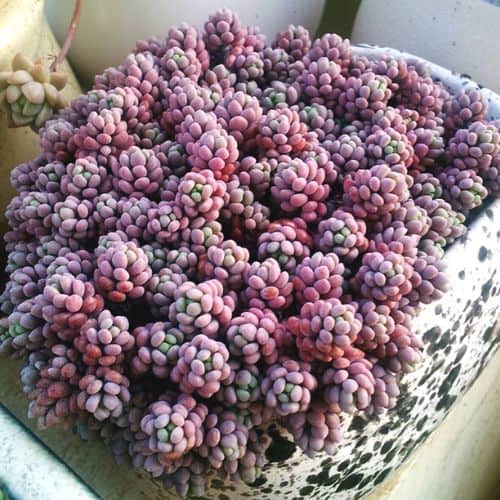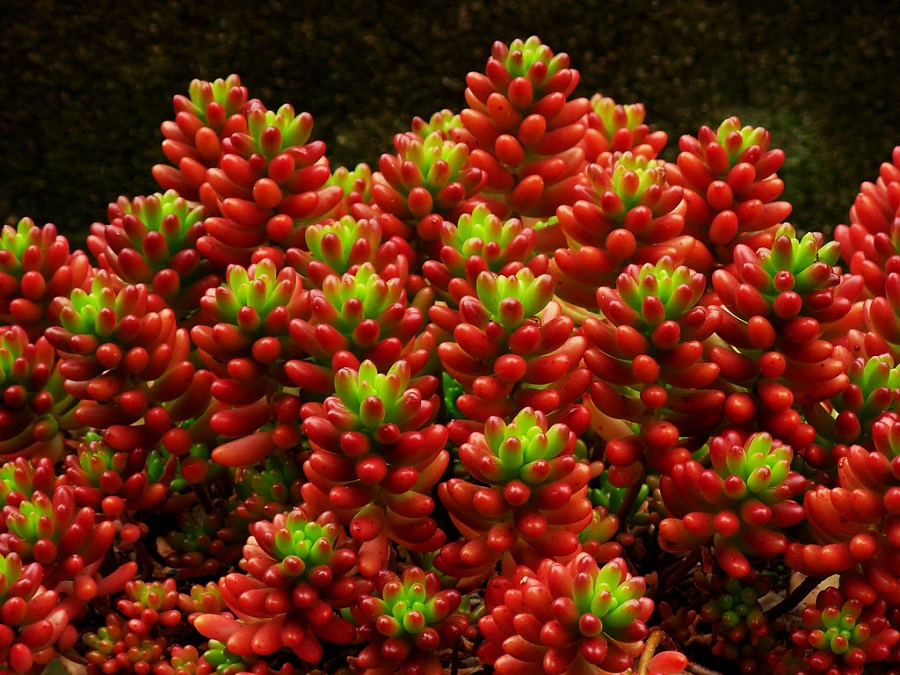130+ Sedum Varieties That Are Too Gorgeous to Be Real
Get ready to be blown away by the incredible world of sedums! These quirky, adorable succulents come in a mind-boggling array of shapes, sizes and colors. With over 130 different varieties, there’s something for everyone to obsess over. From tiny jelly bean look-alikes to giant shrub-like monsters, sedums will captivate you with their weird and wonderful forms. And we’re about to dive deep into this succulent wonderland! Get those gardening gloves ready because once you see these cuties, you’ll be itching to add them all to your collection.
Contents
- 1 Types of Sedums
- 2 Images Of Sedum Varieties
- 2.1 Sedum acre
- 2.2 Sedum actinocarpum
- 2.3 Sedum adolphi
- 2.4 Sedum aetnense
- 2.5 Sedum aizoon
- 2.6 Sedum album
- 2.7 Sedum allantoides
- 2.8 Sedum alpestre
- 2.9 Sedum andegavense
- 2.10 Sedum anglicum
- 2.11 Sedum annuum (Annual Stonecrop)
- 2.12 Sedum arenarium
- 2.13 Sedum assyriacum
- 2.14 Sedum atratum
- 2.15 Sedum baleensis
- 2.16 Sedum bellum
- 2.17 Sedum borissovae
- 2.18 Sedum brevifolium
- 2.19 Sedum bulbiferum
- 2.20 Sedum burrito
- 2.21 Sedum caeruleum
- 2.22 Sedum cepaea
- 2.23 Sedum clavatum
- 2.24 Sedum clavifolium
- 2.25 Sedum cockerellii
- 2.26 Sedum commixtum
- 2.27 Sedum compactum
- 2.28 Sedum confusum
- 2.29 Sedum corynephyllum
- 2.30 Sedum cremnophila
- 2.31 Sedum creticum
- 2.32 Sedum cyaneum
- 2.33 Sedum dasyphyllum
- 2.34 Sedum debile
- 2.35 Sedum dendroideum
- 2.36 Sedum diffusum
- 2.37 Sedum divergens
- 2.38 Sedum emarginatum
- 2.39 Sedum ewersii
- 2.40 Sedum farinosum
- 2.41 Sedum formosanum
- 2.42 Sedum forsterianum ‘Oracle’
- 2.43 Sedum furfuraceum
- 2.44 Sedum glaucophyllum
- 2.45 Sedum gracile
- 2.46 Sedum greggii
- 2.47 Sedum grisebachii
- 2.48 Sedum griseum
- 2.49 Sedum guatemalense
- 2.50 Sedum gypsicola
- 2.51 Sedum hakonense ‘Chocolate Ball’
- 2.52 Sedum hernandezii
- 2.53 Sedum hintonii
- 2.54 Sedum hirsutum
- 2.55 Sedum hirsutum subsp. baeticum
- 2.56 Sedum hispanicum
- 2.57 Sedum humifusum
- 2.58 Sedum hybridum
- 2.59 Sedum integrifolium
- 2.60 Sedum japonicum ‘Tokyo Sun’
- 2.61 Sedum jurgensenii
- 2.62 Sedum kamtschaticum
- 2.63 Sedum kimnachii
- 2.64 Sedum lanceolatum
- 2.65 Sedum laxum
- 2.66 Sedum lineare ‘Variegatum’
- 2.67 Sedum litoreum
- 2.68 Sedum longipes
- 2.69 Sedum lucidum
- 2.70 Sedum lucidum obesum
- 2.71 Sedum makinoi
- 2.72 Sedum macdougallii
- 2.73 Sedum mexicanum
- 2.74 Sedum microsepalum
- 2.75 Sedum mocinianum
- 2.76 Sedum monregalense
- 2.77 Sedum montanum
- 2.78 Sedum montanum subsp. orientale
- 2.79 Sedum moranense
- 2.80 Sedum moranii
- 2.81 Sedum morganianum
- 2.82 Sedum morrisonense
- 2.83 Sedum mucizonia
- 2.84 Sedum multiceps
- 2.85 Sedum muscoideum
- 2.86 Sedum nevii
- 2.87 Sedum nussbaumerianum
- 2.88 Sedum oaxacanum
- 2.89 Sedum obcordatum
- 2.90 Sedum oblanceolatum
- 2.91 Sedum obtusatum
- 2.92 Sedum obtusifolium
- 2.93 Sedum ochroleucum ‘Red Wiggle’
- 2.94 Sedum orbatum
- 2.95 Sedum oreganum
- 2.96 Sedum oregonense
- 2.97 Sedum oteroi
- 2.98 Sedum oxypetalum (Dwarf Tree Stonecrop)
- 2.99 Sedum pachyphyllum
- 2.100 Sedum pallidum var. bithynicum
- 2.101 Sedum palmeri
- 2.102 Sedum pilosum
- 2.103 Sedum pluricaule
- 2.104 Sedum polytrichoides
- 2.105 Sedum potosinum
- 2.106 Sedum praealtum
- 2.107 Sedum pusillum
- 2.108 Sedum radiatum
- 2.109 Sedum ‘Red Canyon’
- 2.110 Sedum reptans
- 2.111 Sedum rhodanthum
- 2.112 Sedum Rosy Glow
- 2.113 Sedum rubens
- 2.114 Sedum rubrotinctum
- 2.115 Sedum rupestre
- 2.116 Sedum sediforme
- 2.117 Sedum shitaiense
- 2.118 Sedum sieboldii
- 2.119 Sedum smallii
- 2.120 Sedum spathulifolium
- 2.121 Sedum spectabile
- 2.122 Sedum spurium
- 2.123 Sedum stahlii
- 2.124 Sedum stefco
- 2.125 Sedum stellatum
- 2.126 Sedum stenopetalum
- 2.127 Sedum stoloniferum
- 2.128 Sedum suaveolens
- 2.129 Sedum tenellum
- 2.130 Sedum ternatum
- 2.131 Sedum tetractinum
- 2.132 Sedum torulosum
- 2.133 Sedum treleasei
- 2.134 Sedum urvillei
- 3 How To Care For Sedum Varieties
- 4 Propagating Sedums
Types of Sedums
Sedums come in 3 categories:
Upright Sedum Varieties
These Sedum types have dense, domed flowers and succulent leaves on 1- to 2-foot stems. These taller sedum varieties generally behave like perennials and do well in zones 4 or 5 to 9, with a layer of winter mulch recommended in zones 4 and 5.
Creeping Sedum Varieties
These stonecrop varieties produce clusters of star-shaped flowers. They are well suited for ground cover, rock walls, roof gardens, living walls, or tucked into strawberry pots.
Trailing Sedum Varieties
One popular example is the donkey’s tail, also called burro’s or lamb’s tail. These Sedum types are well-suited for draping over the edges of containers or hanging baskets.
Images Of Sedum Varieties
If you are wondering what kind of succulent you have, this section has 130+ images of sedum varieties that can help you with common and rare sedum identification.
Related Post:
1,000 Types of Succulents With Pictures.
Sedum acre
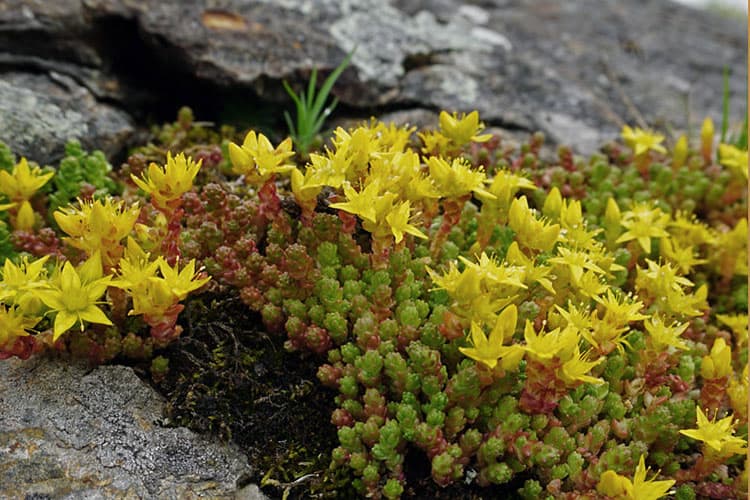
This cute little plant only grows 3 inches tall but spreads out up to 2 feet wide, creating a lush green carpet. Its chubby green leaves overlap like roof shingles, giving it a distinct appearance. In summer, clusters of tiny yellow star-shaped flowers pop up, almost getting lost amongst the foliage. Incredibly hardy, this one can survive droughts and freezing temperatures.
Sedum actinocarpum
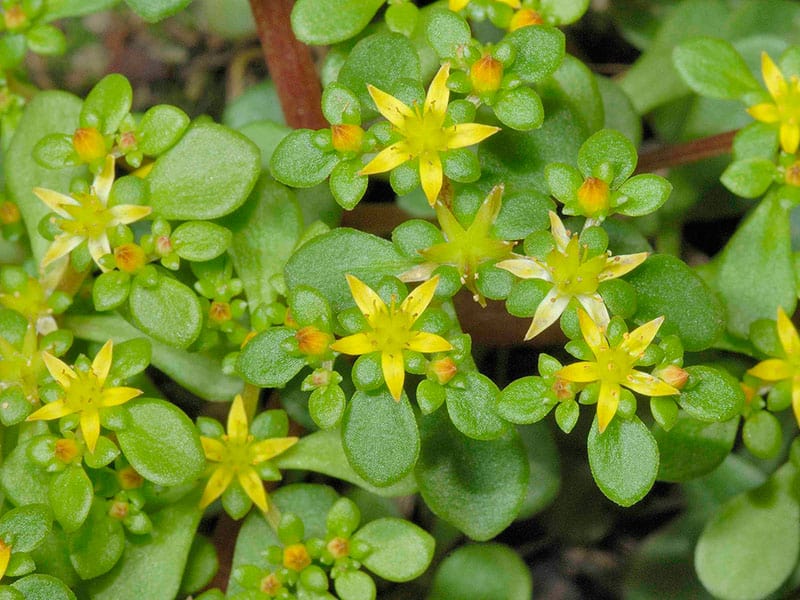
Don’t let the plain name fool you – this unusual sedum sports vivid yellow star-shaped blooms from late winter through spring. It has slender upright stems reaching 7 inches tall, lined with rounded blue-green leaves. After the cheerful flowers fade, horizontal seed pods spread out in a rosette pattern, creating an other-worldly display.
Sedum adolphi
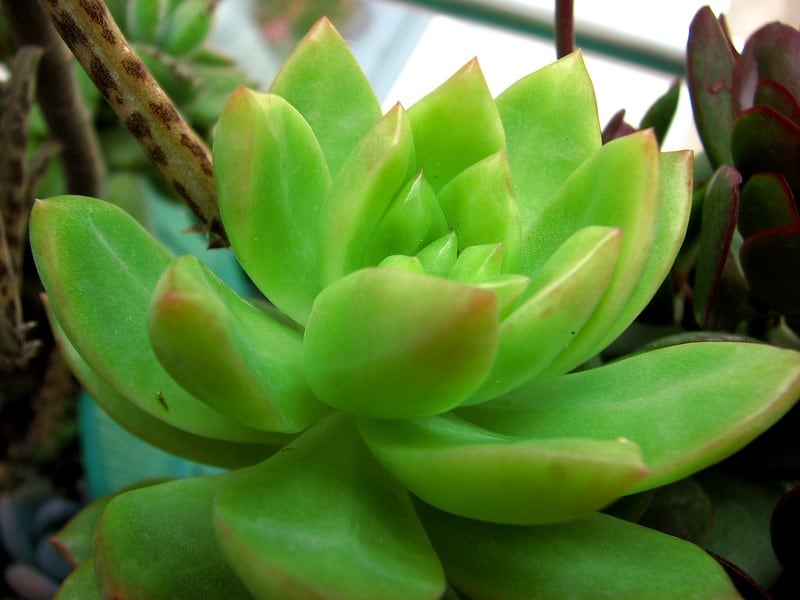
This vibrant Mexican sedum forms a bushy mound up to 1 foot high and wide. The plump green leaves take on incredible orange-red tones in full sun. But the real showstopper is the fragrant white flower clusters that emerge in late winter, perfuming the whole garden.
Related Post:
Sedum nussbaumerianum vs Sedum adolphii
Sedum aetnense
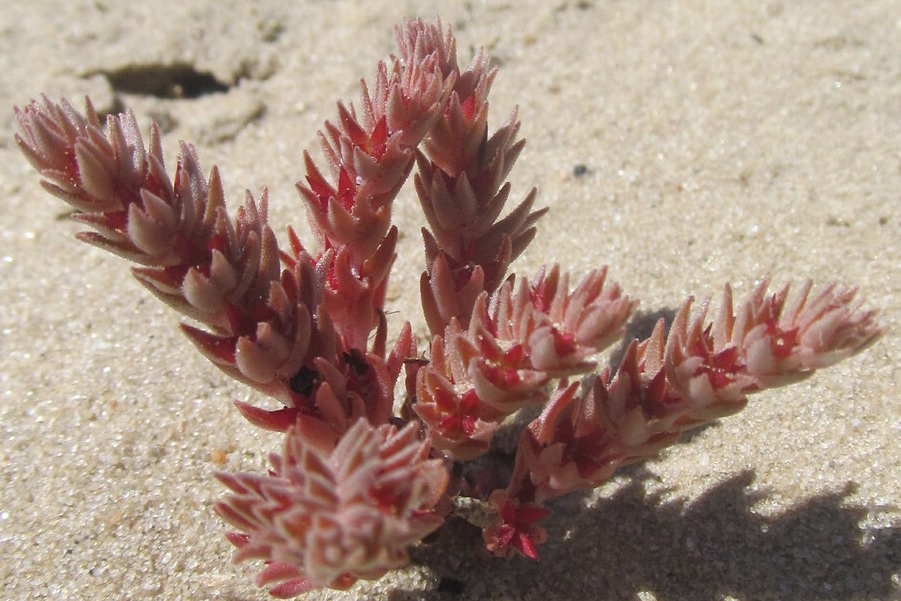
Despite its tiny stature of just 2.4 inches tall, this plucky little sedum packs a colorful punch. The fleshy blue-green leaves are tipped with a dusty white bloom, giving them an ethereal look. But the real magic happens in summer when clusters of white or pinkish-red star-shaped flowers appear, almost concealing the entire plant.
Sedum aizoon
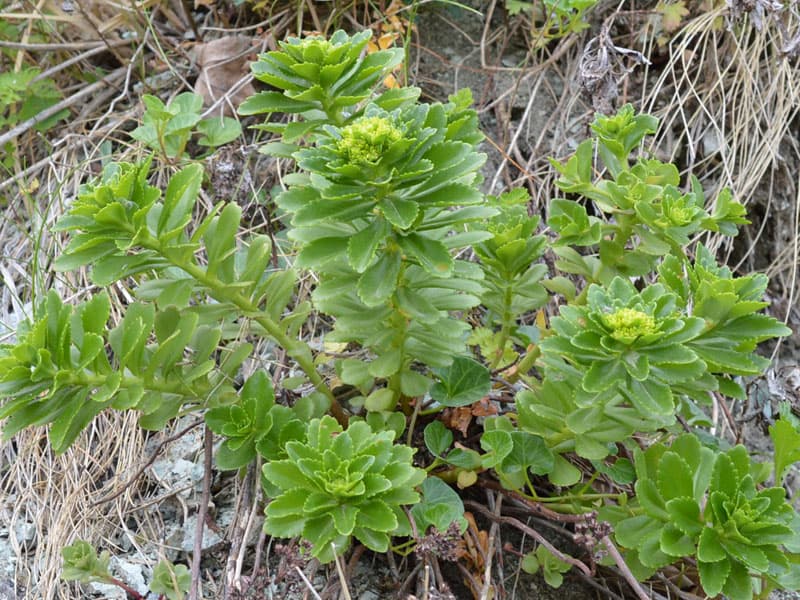
Prepare to be wowed by this tall and stately stonecrop! Reaching up to 20 inches high, its upright stems are cloaked in fleshy green leaves with irregular teeth along the edges. The flat-topped flower clusters put on a dazzling yellow display in summer, with each little blossom measuring 1/2 inch across. No wonder it’s been a garden staple for centuries!
Sedum album
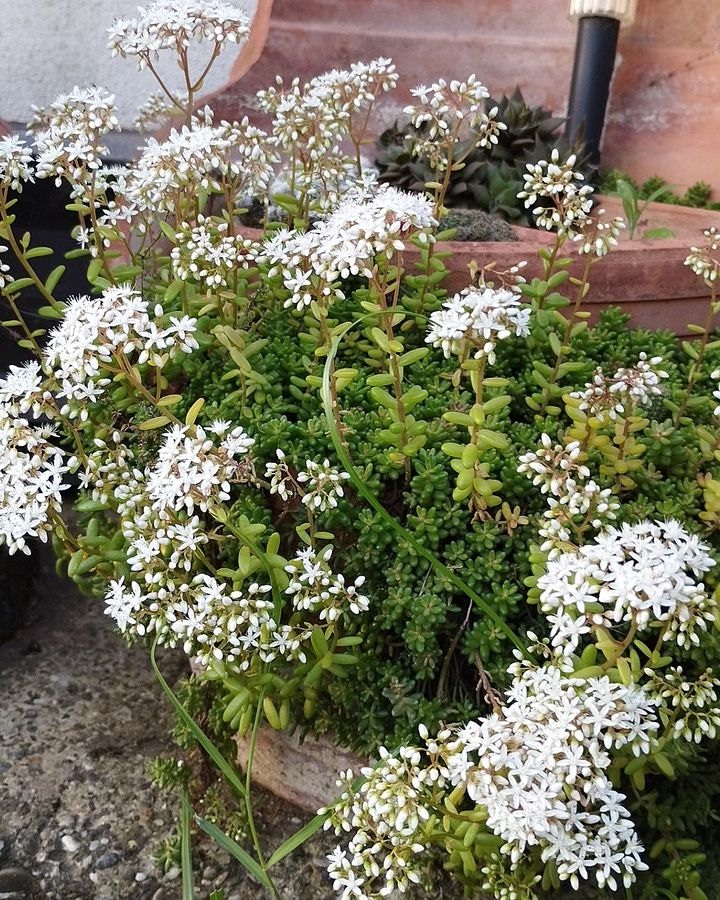
Who can resist the charms of this evergreen mat-former? In summer, dainty white star-like flowers smother the plump green foliage, attracting butterflies galore. But the real magic happens in fall and winter when the leaves blush crimson, creating a fiery carpet to enliven the cold-weather garden. Tough as nails too – it laughs in the face of drought and scorching heat.
Sedum allantoides
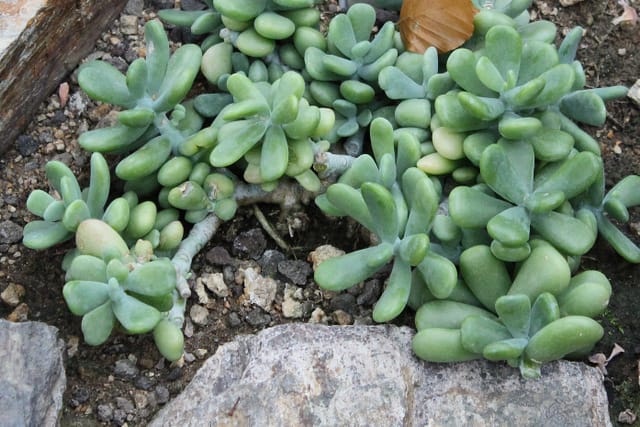
Here’s a small but feisty number reaching just 1 foot tall and wide. The fleshy blue-green leaves look like they’ve been dusted with powder, giving the whole plant an ethereal vibe. But things really get exciting in summer when saucer-sized clusters of greenish-white flowers emerge. Not your average wallflower!
Sedum alpestre
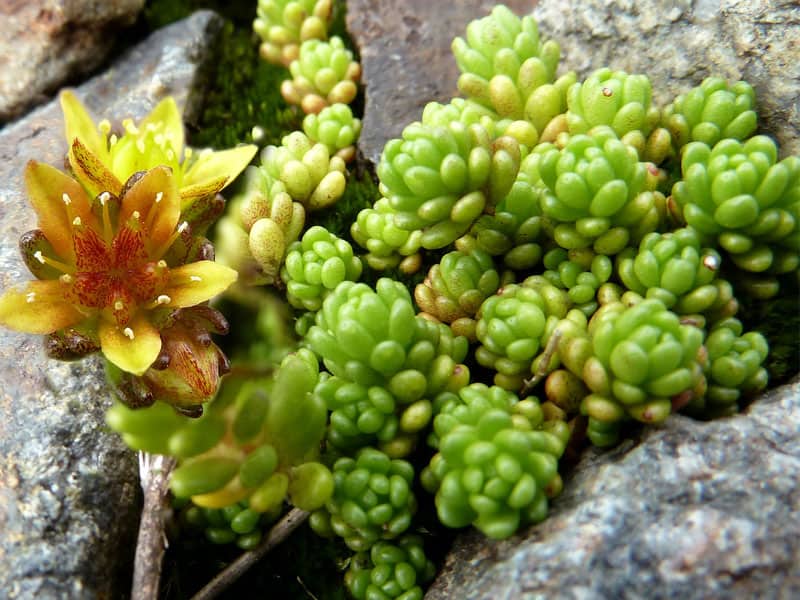
Don’t let the modest appearance fool you – this compact alpine sedum is one tough cookie. Native to rocky alpine areas, it forms a low-growing mat of blue-green rosettes, topped with cheery yellow flowers with red venation. It’s hardy enough to survive elevations nearing 11,000 feet!
Sedum andegavense
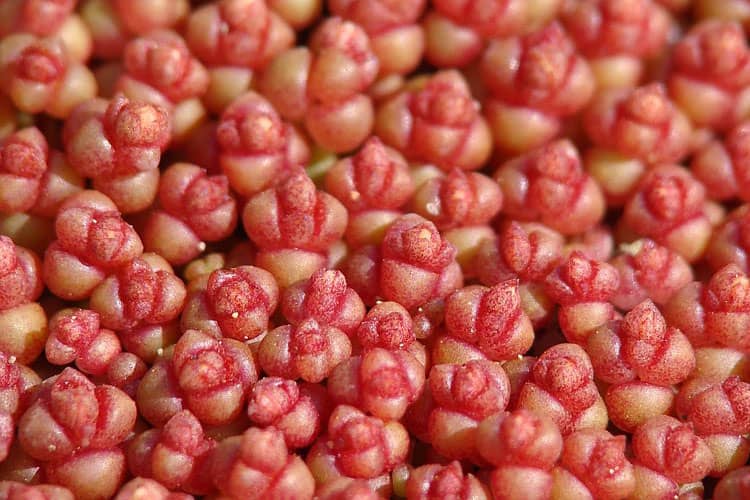
Sedum anglicum
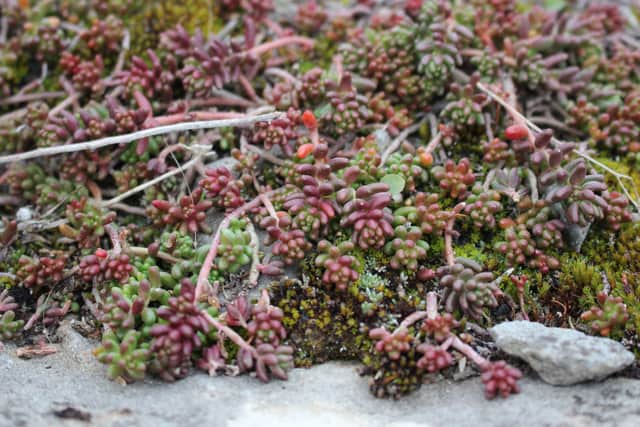
As its name suggests, this quintessentially English plant is as cute as a button. The stubby green leaves take on shades of pink when conditions are dry, almost like it’s blushing. But the real charmers are the dainty white flower clusters that rise above the foliage, showcasing 10 contrasting yellow stamens.
Sedum annuum (Annual Stonecrop)
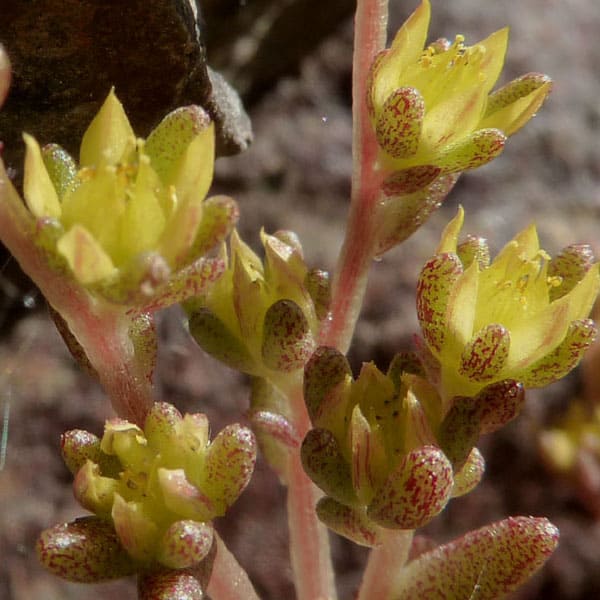
This cheerful little annual is the perfect pocket-sized sedum. Only reaching 6 inches tall at most, the bright green leaves remain compact and tidy. But beginning in mid-spring, an explosion of radiant yellow star flowers take over, almost concealing the plant entirely until fall. Great for containers and rock gardens.
Sedum arenarium
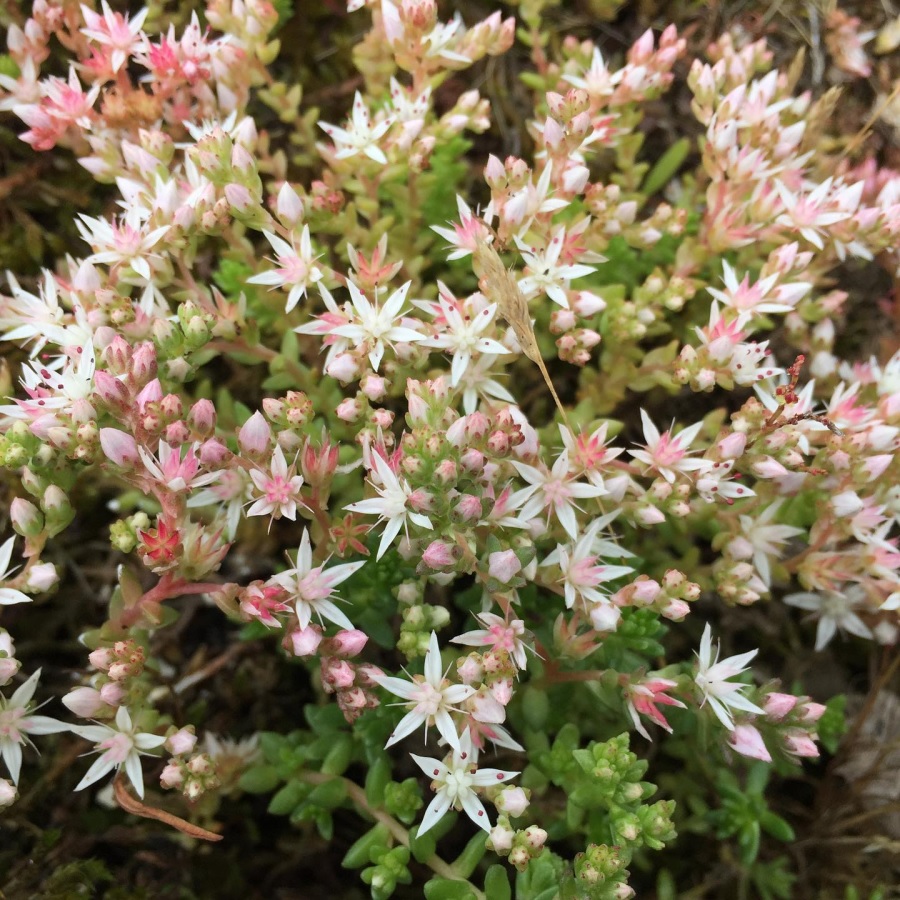
From its chunky green leaves arranged in perfect rosettes to the stout upright stems, everything about this mounded sedum is just plain huggable! Even the tiny white flowers have a cheery vibe when they blanket the foliage in summer. Tough as nails yet still absolutely adorable.
Sedum assyriacum
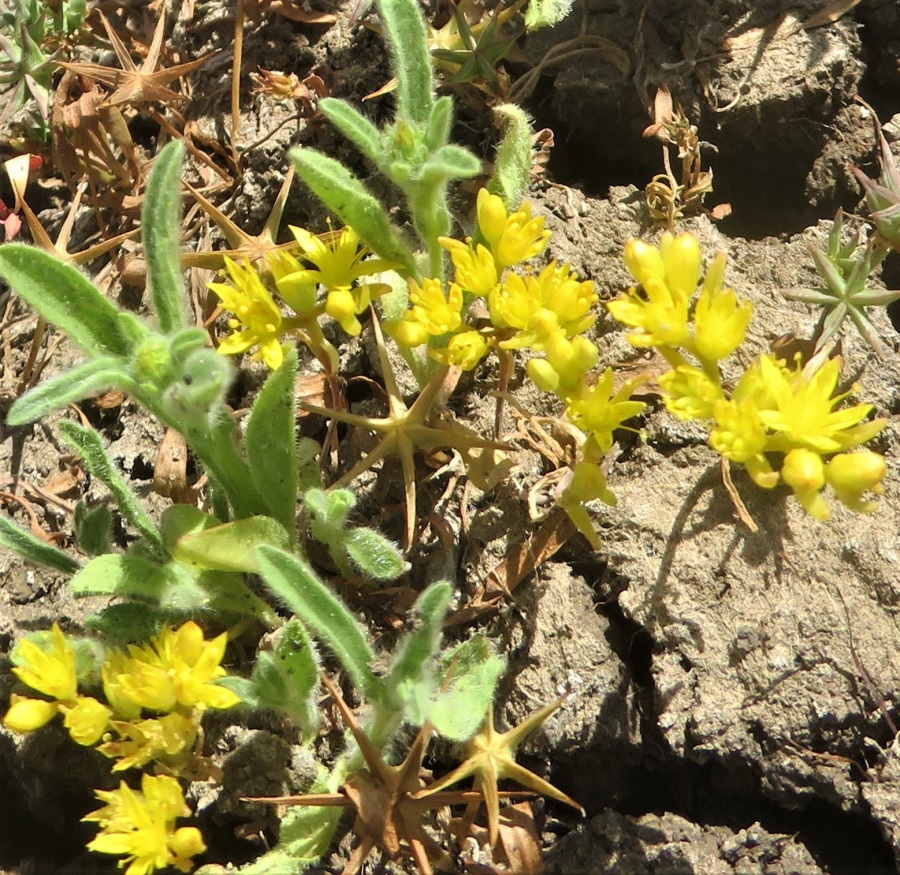
Don’t let the plain green looks fool you – this petite annual from the Middle East has some funky flowers up its sleeve. In spring, clusters of vivid butter-yellow blooms appear, each one featuring elongated spiky petals radiating out like a crazed star. A real weirdo, but isn’t that why we love sedums?
Sedum atratum

This tiny alpine gem will have you scouring nurseries to find it! The miniature rosettes, only 2-4 inches across, are adorned with plump green leaves that take on a rich wine-red hue. But the real stars are the clusters of deep pink flowers that pop up in spring on short fleshy stems, as if stemming right from the center of the rosettes themselves.
Sedum baleensis
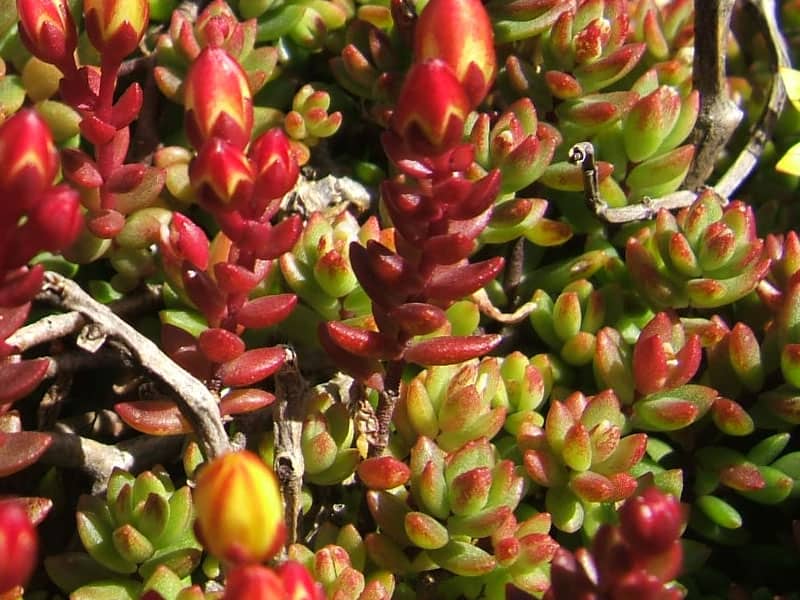
Sedum bellum
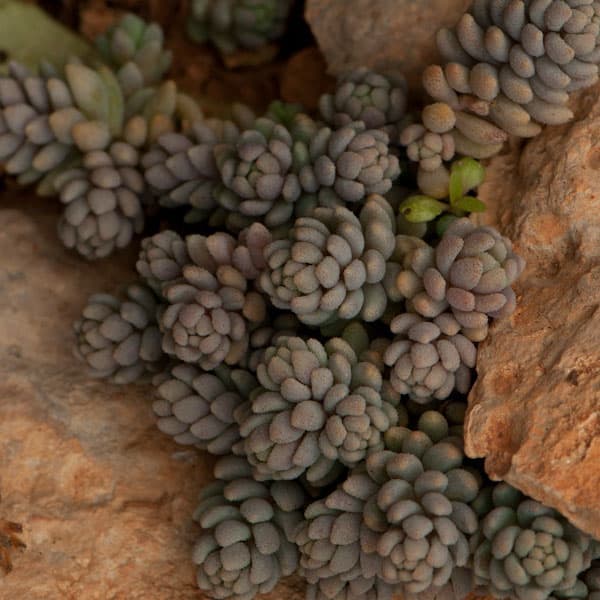
As its name suggests, this Mexican sedum is an absolute beauty. The slender stems have a casual, trailing habit adorned with dainty olivey-green jelly bean leaves that blush burgundy in full sun. But then come the brilliant orange flowers in summer – an electric zinger of color to brighten up any garden nook or container.
Sedum borissovae
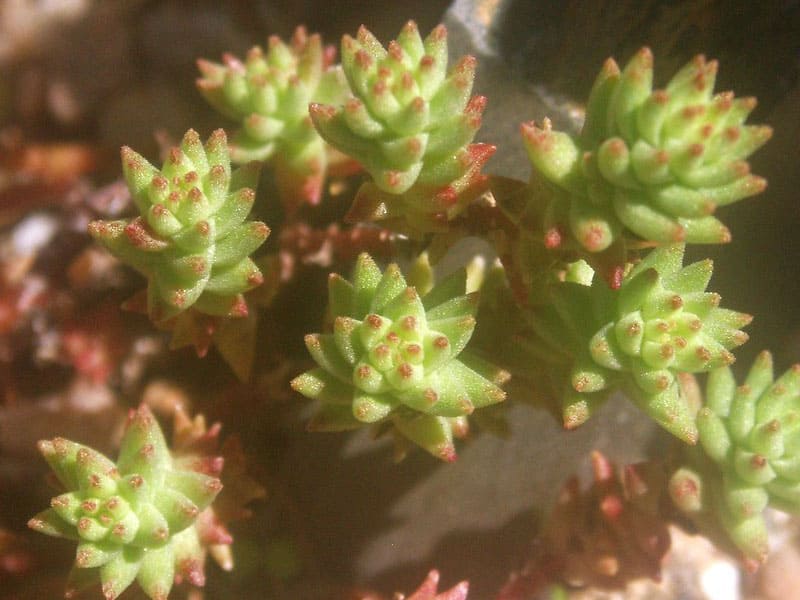
Sedum brevifolium
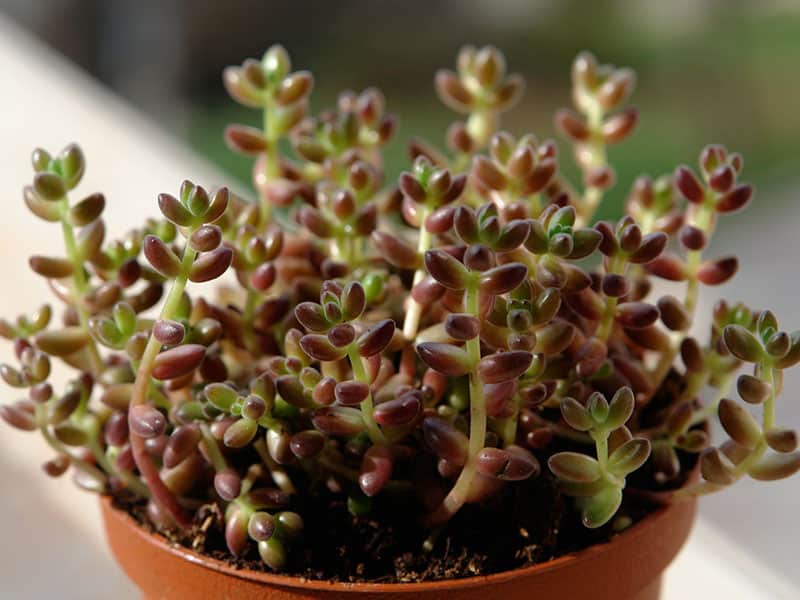
For a truly unique textural accent, look no further than this miniature shrublet. Tightly clustered green leaves create a dense, conifer-like appearance, while the entire plant stays under 6 inches tall and wide. In summer, a dusting of dainty white starry flowers provides an ethereal finishing touch to its woodsy look.
Sedum bulbiferum
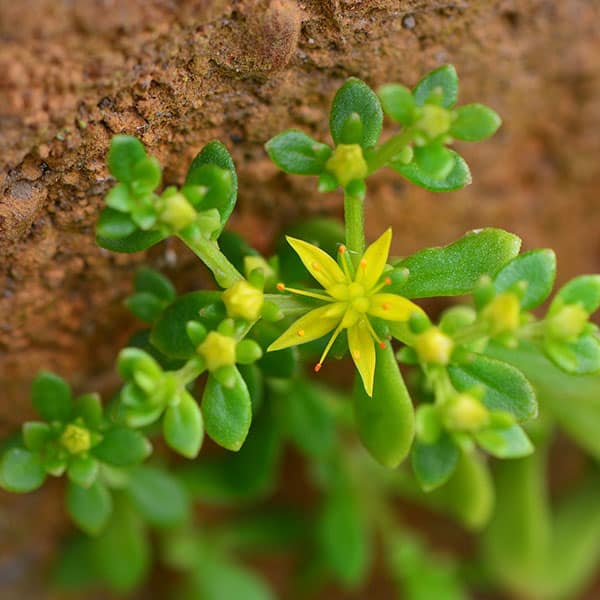
Prepare for an untamed burst of fireworks the first time you see this quirky character in bloom! The upright tangled stems, up to 2 feet tall, get completely engulfed by sprays of vibrant yellow stars. On their own, the fleshy blue-grey leaves arranged in odd patterns give it a zany appeal too.
Sedum burrito
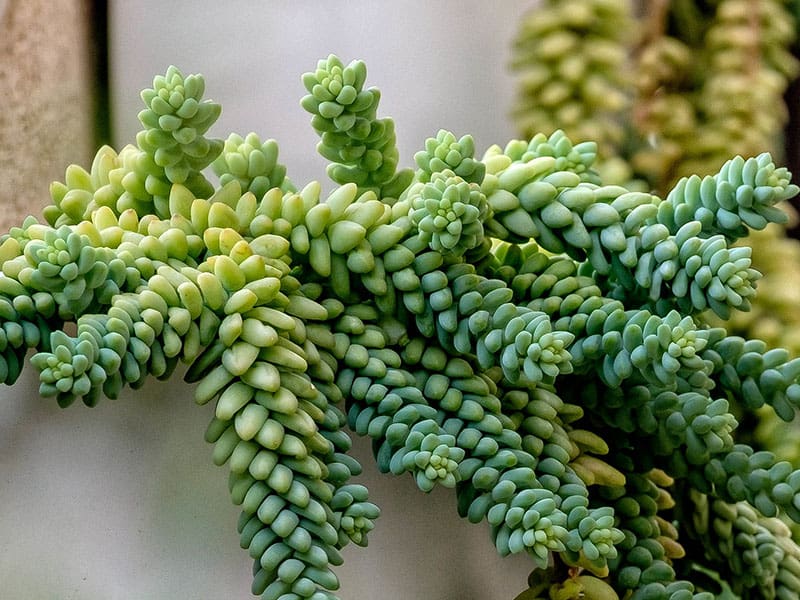
You’ll get why it’s nicknamed “Burro’s Tail” the second you lay eyes on this trailing succulent. Thick, blue-green leaves overlap along the stems in perfect braidlike spirals, making it look just like…well, you get the idea! In summer, the stem tips get capped with vivid fuchsia flower clusters. An offbeat charmer for hanging baskets or warm climates.
Sedum caeruleum
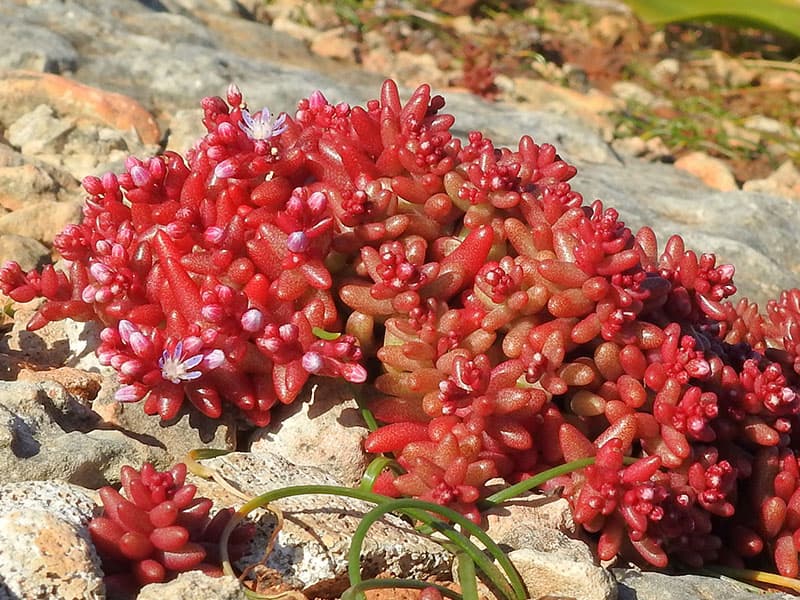
Stop the presses – we’ve got a rare blue-flowered sedum on our hands here! Indeed, the starry cornflower-blue blooms are the crowning glory of this upright, bushy annual reaching 1 foot tall and wide. A row of plump blue-green leaves spirals up each stem, finally bursting into those coveted periwinkle puffs.
Sedum cepaea
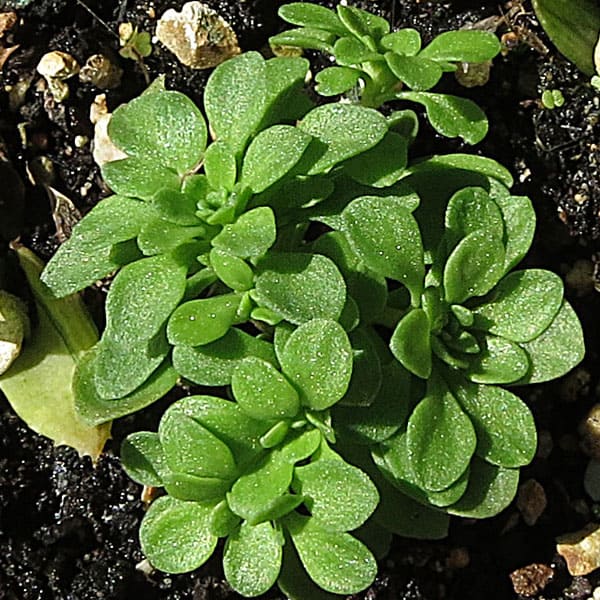
Don’t scroll past just because it’s an annual! This cheerful, much-branched sedum from Morocco is just plain fun. Reaching up to 2.5 feet tall, the stems get lined with festive sprays of bright yellow starry flower heads, each one accented by deep crimson anthers in the middle. Talk about whimsical!
Sedum clavatum
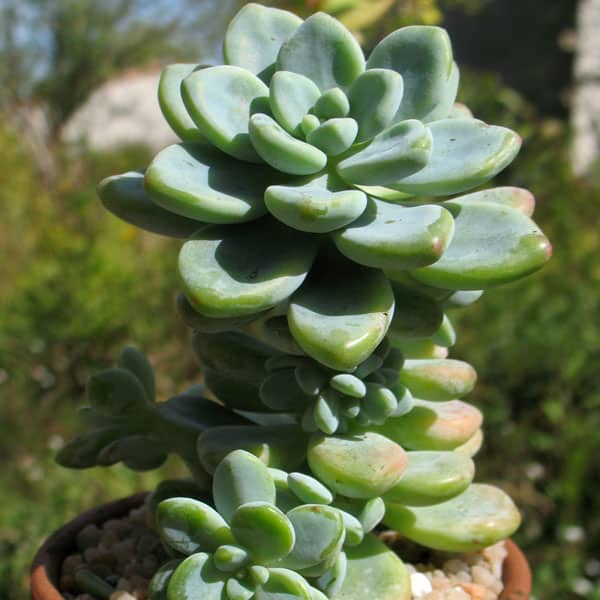
As endearing as a favorite stuffed animal, this dwarf stonecrop forms tight rosettes of frosty blue-gray leaves that resemble soft pom-poms. But the real kicker is the scattering of white flowers it releases in spring, held in cupped clusters amidst the foliage like captured bubbles. This miniature easily wins the “Cutest Sedum” award!
Sedum clavifolium
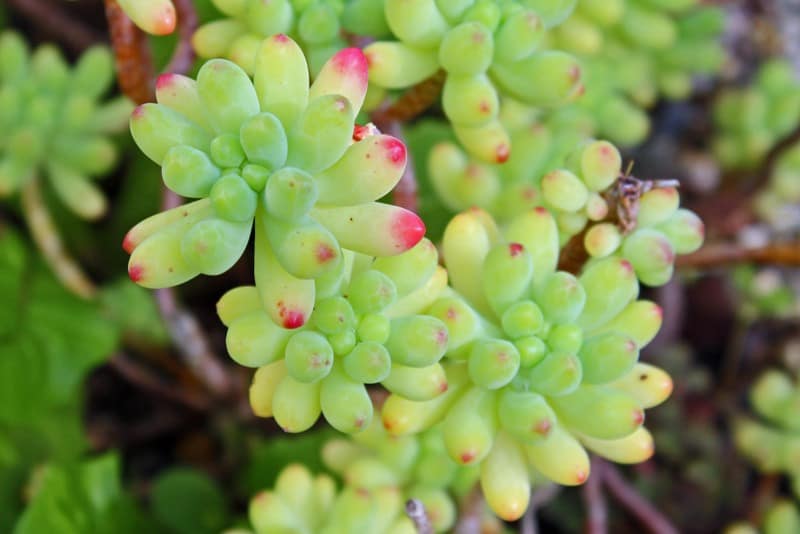
Sedum cockerellii
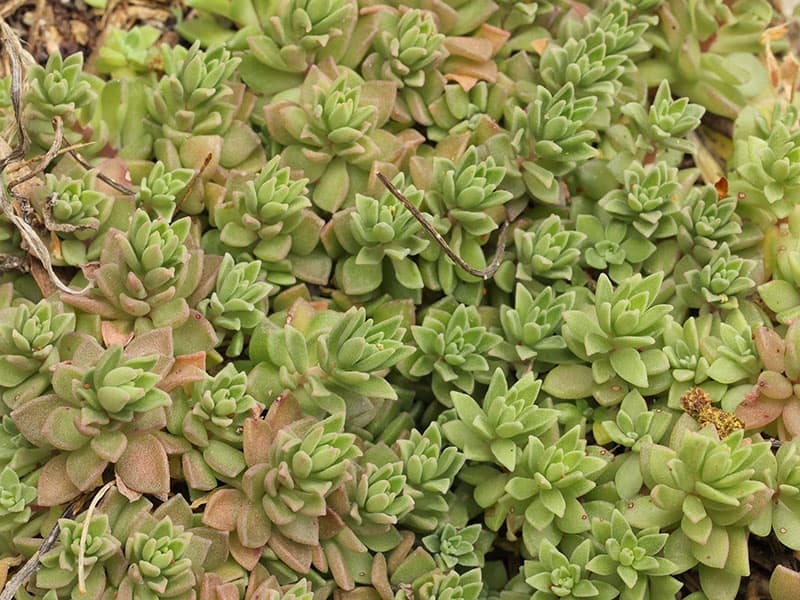
Don’t let the subtle looks fool you – this little south western native is one tough cookie! The fleshy green leaves may appear modest, but they allow the plant to thrive in rocky, shaded areas up to 11,500 feet in elevation. In summer, sprays of pink-tinged white starry flowers add a delicate touch of color. A resilient yet charming choice for challenging spaces.
Sedum commixtum
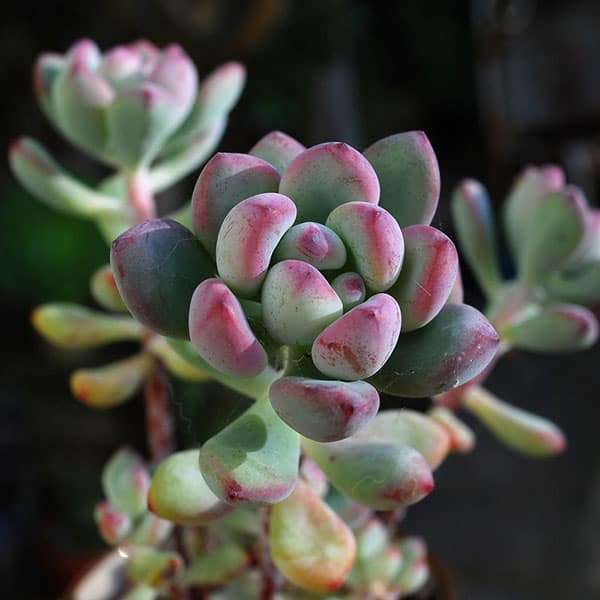
Here’s a variety that likes to flaunt its chameleon ways! The fleshy blue-green leaves take on rosy-gold to coppery-red tones in full sun, creating a feisty multicolored display. But that’s just the opening act – in summer, the entire plant becomes cloaked in dull yellow starry blooms for a real fairy-tale finale. A dazzler for containers and rock gardens!
Sedum compactum
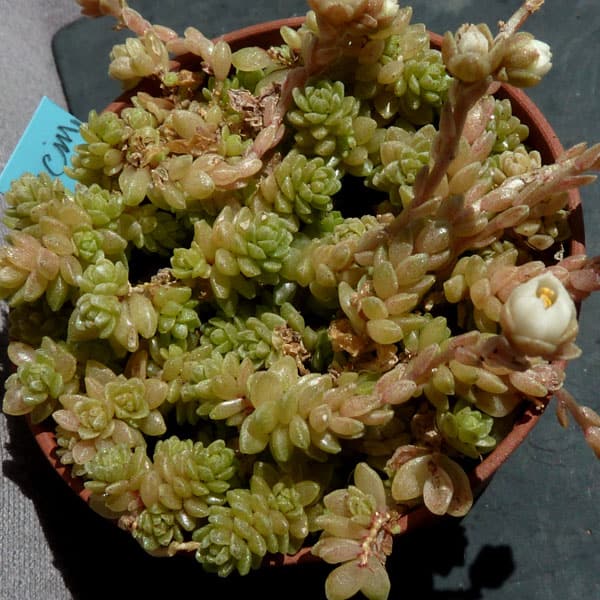
Don’t be fooled by the petite stature – this tiny sedum packs a big punch! The tidy, bun-shaped rosettes of chubby green leaves only reach 2-4 inches high, but they spread rapidly to form a lush mat of texture. In summer, the foliage gets practically obscured by a blizzard of dainty white starry flowers. Perfection for cracks, crevices and fairy gardens!
Sedum confusum
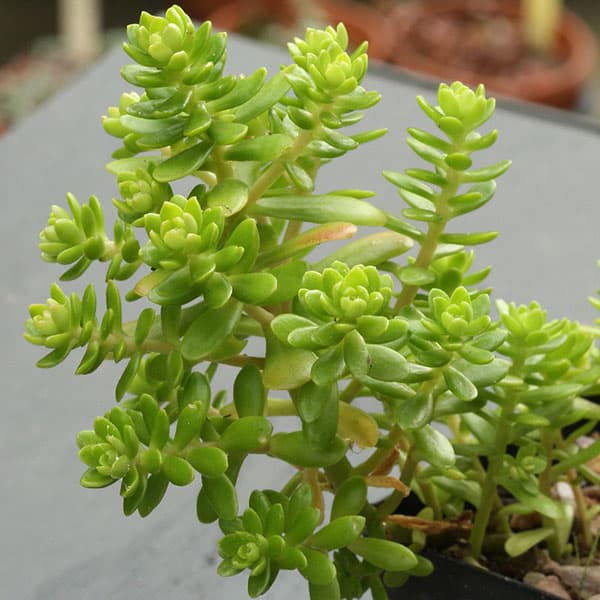
True to its name, this creeping sedum will have you scratching your head at first glance! The trailing stems get completely engulfed by fleshy, glossy green jelly bean leaves that blush pink along the edges in full sun. But then in summer, vibrant yellow star flowers burst forth to cover the entire mat. Quirky looks with a big color payoff!
Sedum corynephyllum
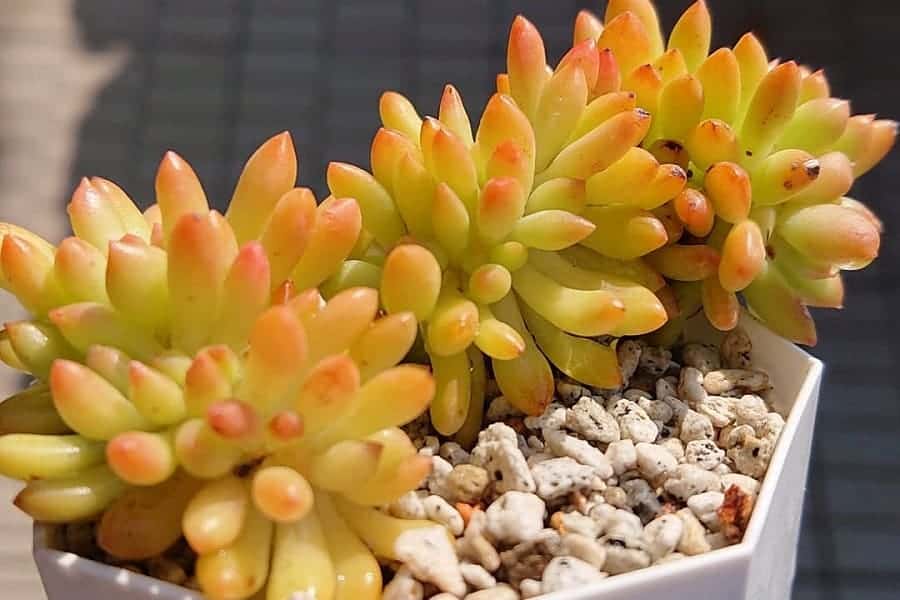
This unassuming little sedum is a real showoff when it comes to color changes! The fleshy blue-green leaves arranged in spiral patterns up the stems take on luminous golden-yellow tones when exposed to plenty of sun. But as if that vibrant transformation wasn’t enough, fluorescent yellow flower clusters then burst open in summer to really crank up the wattage. Whether planted as a mounded accent or trailing spiller, it lights up the garden with incandescent brilliance. Who needs green when you can put on such a radiant display?
Sedum cremnophila
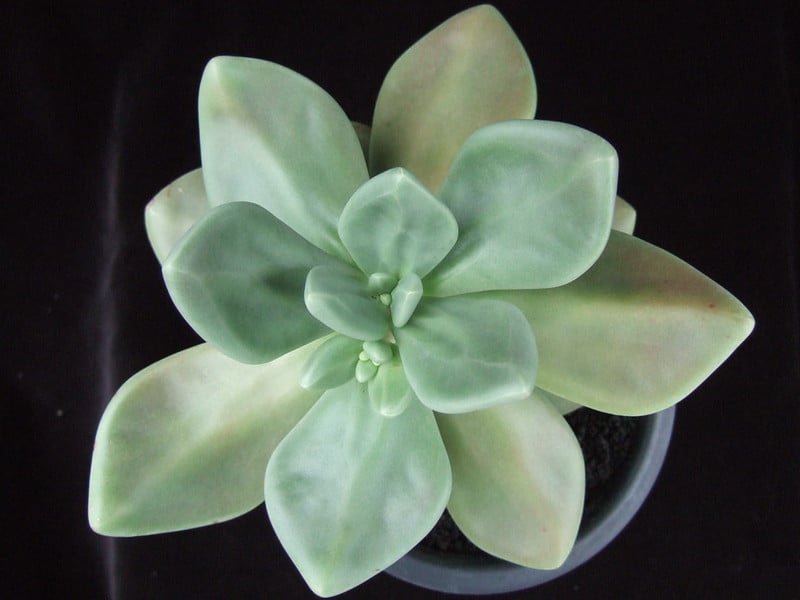
Fans of the classic “jelly bean” sedums will go crazy for this trailing variety from Mexico. The plump bronze-green leaves spiral along the stems in captivating patterns, looking like strands of sautéed pads ready to burst. In summer, the show kicks into high gear with sprays of starry yellow blooms that age to ruby red. A fiesta on every stem!
Sedum creticum
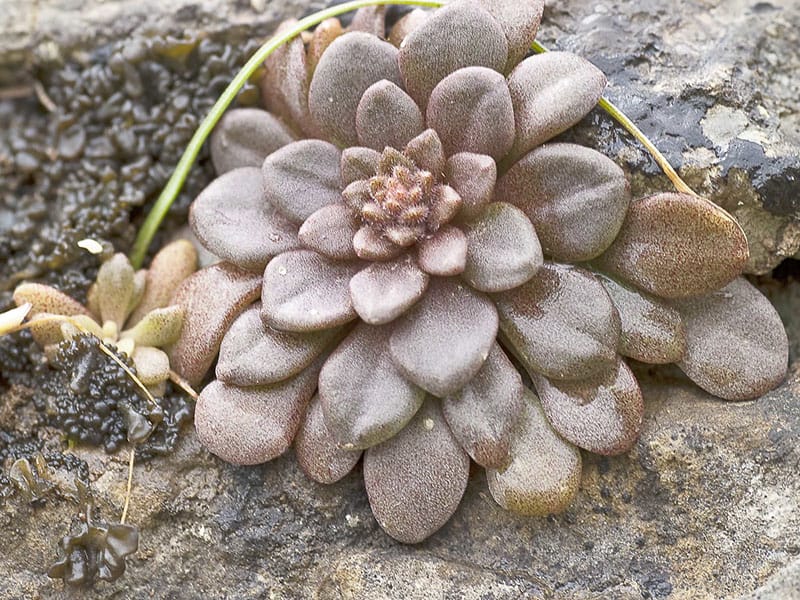
Sedum cyaneum
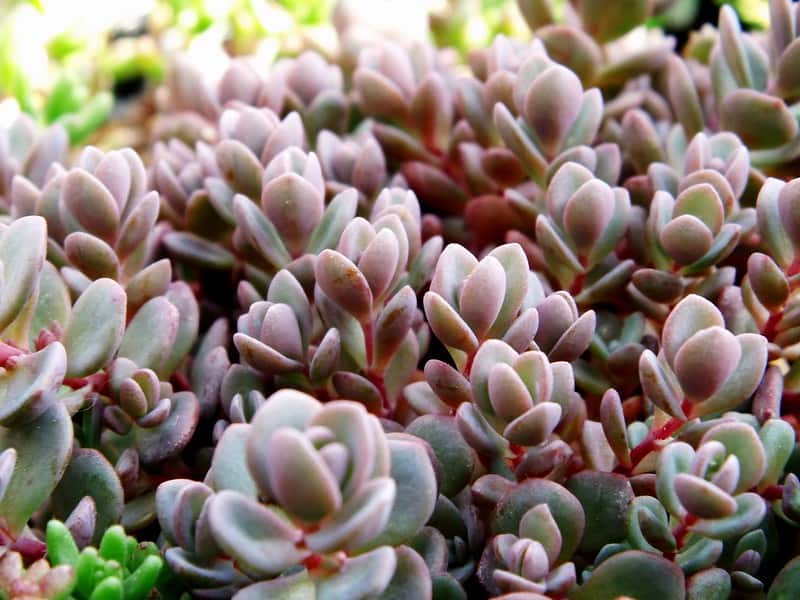
Here’s a sedum rebel that breaks all the rules! Instead of the typical yellows and whites, this ground-hugging variety unleashes one of the most electric shades of pink-purple imaginable when the starry flower clusters appear in late summer. The needle-like blue-gray foliage sets the perfect stage for such an in-your-face floral display too.
Sedum dasyphyllum
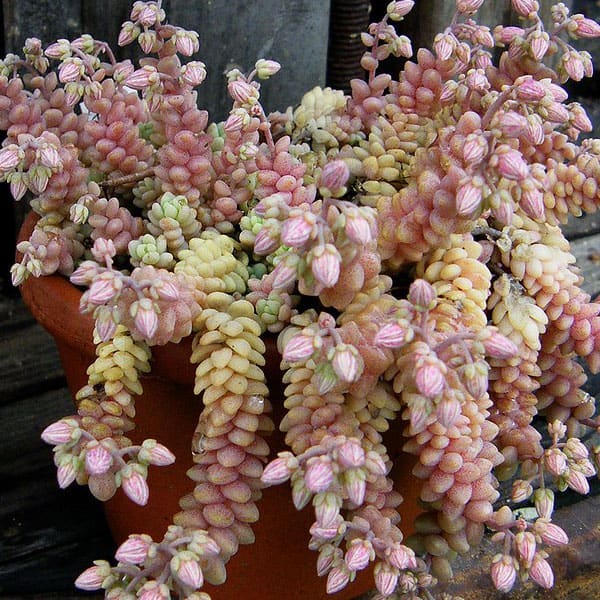
This European native threads the needle between funky looks and easygoing charm. Low-growing blue-green leaves arranged in tight, powdery rosettes create the cutest texture-fest in the garden. But the arrival of cheerful white starry flowers in early summer prevents it from being too weird. An accessible novelty for beginning sedum lovers!
Sedum debile
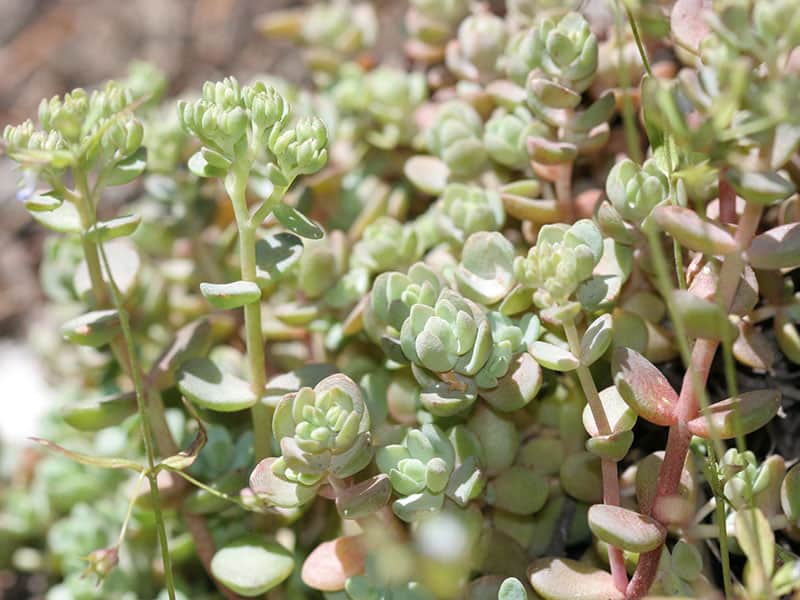
Imagine tiny green toupées covering the ground and you’ll get a sense of this sedum’s quirky look. The fleshy rounded leaves form dense clusters along the trailing stems, blushing pink in full sun. But it’s the scattered yellow starry flowers in summer that provide the real pizazz, hovering over the foliage like a sunny haze.
Sedum dendroideum
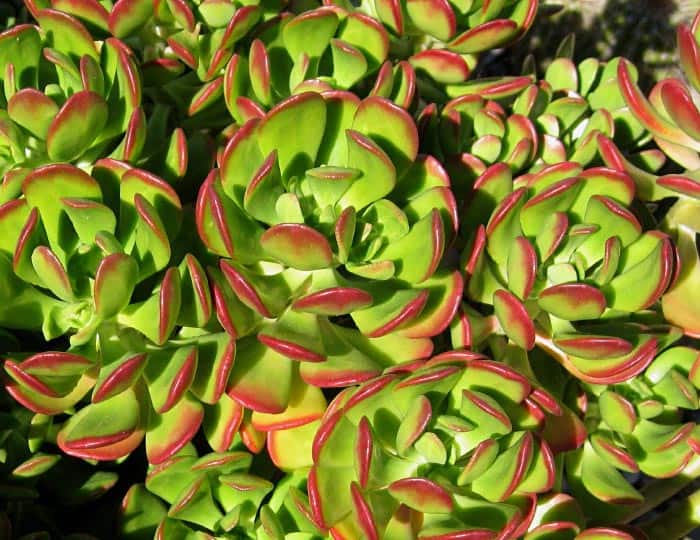
For sedum lovers who crave something a tad more substantial, this shrubby Mexican variety fits the bill. The thick blue-green spoon-shaped leaves spiral up the stems in dense patterns, creating a lush look that toes the line between succulent and perennial. But the real star is the burst of bright yellow flowers engulfing the entire plant in late winter. An attention-grabber for sure!
Sedum diffusum
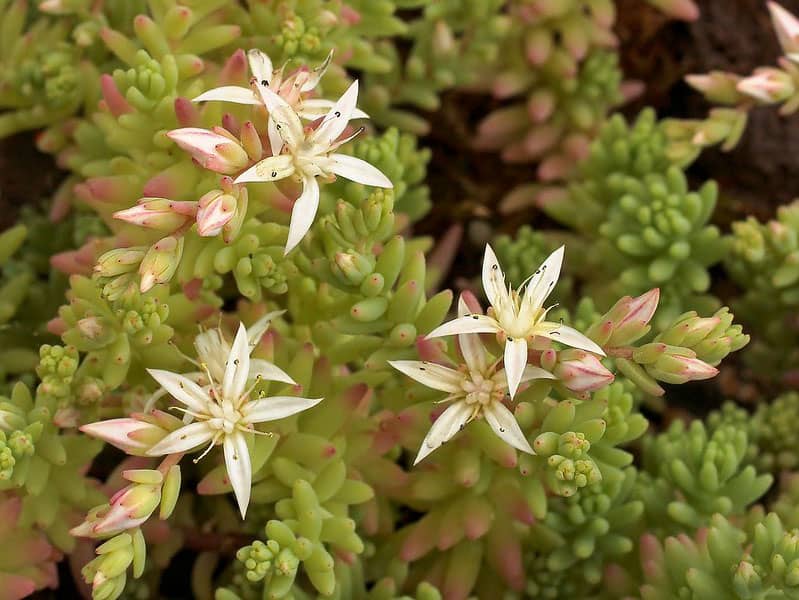
With its trailing stems covered in round green jelly beans that blush pink in the sun, this species already has plenty of personality. But then you get those clusters of cheerful white starry flowers in late spring, providing an ethereal accent to the chunky foliage. A fun option to let tumble over rocks or container edges.
Sedum divergens
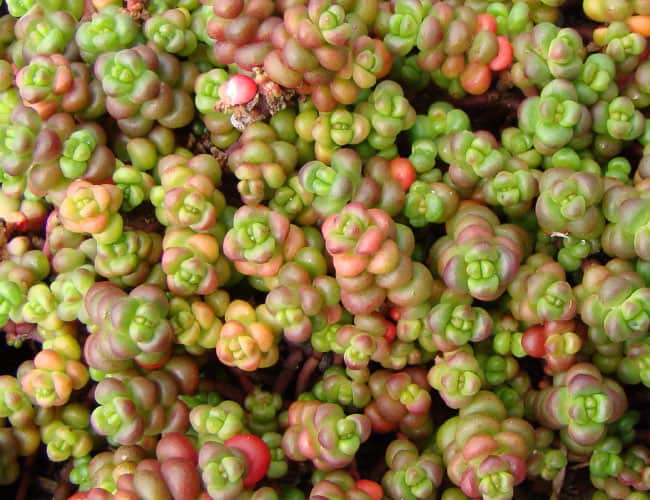
As cute as a puppy, this Pacific Northwest native forms a lush, spreading mat of chubby green leaves tinged with pink. The rounded foliage pairs create perfect rosettes along the stems, giving it a tidy yet still whimsical look. But the real showstopper is the radiant yellow flower clusters that pop up in summer, practically glowing against all that vibrant greenery.
Sedum emarginatum
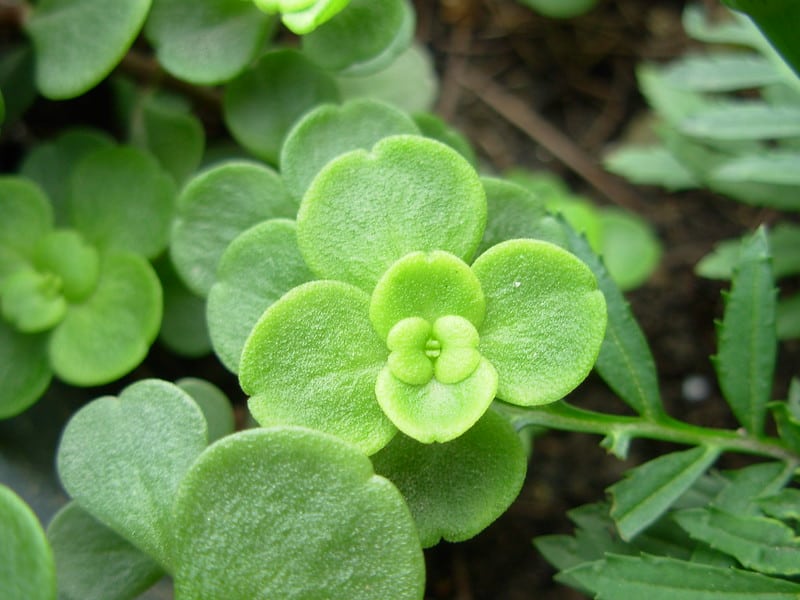
Don’t let the common name fool you – this variety is about as all-American as apple pie! The succulent green paddle-shaped leaves form tidy rosettes that blush burgundy as temperatures drop. But it’s the bright yellow starry flowers in summer that steal the show, smothering the entire plant in radiant sunshine. A classic for good reason.
Sedum ewersii
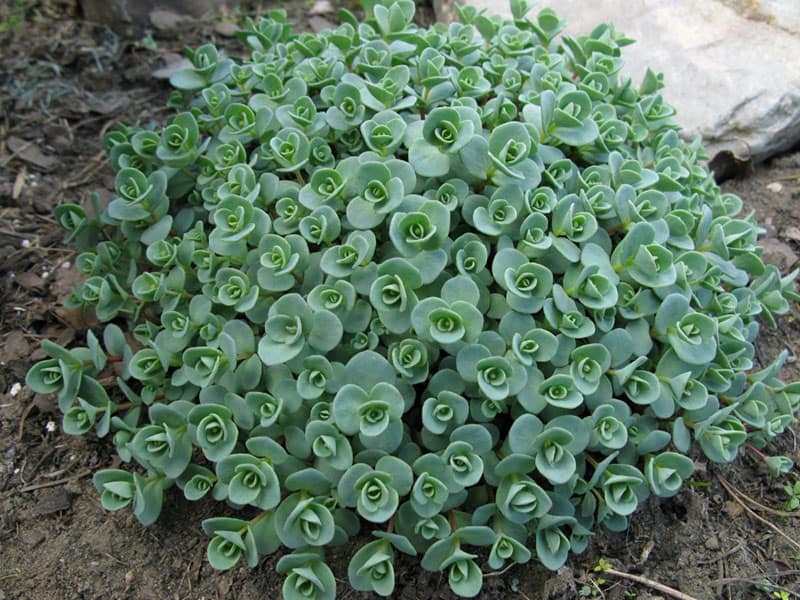
For fans of blue-toned plants, this petite stonecrop is a must-have! The low, dense mound is composed entirely of plump, blue-green leaves that take on a rosier blush in full sun. But then in late summer, the whole thing gets studded with clusters of rose-pink starry flowers – an enchanting shade echo. Plant it to spill over rocks or contain it in a trough where you can admire its tranquil beauty up close.
Sedum farinosum
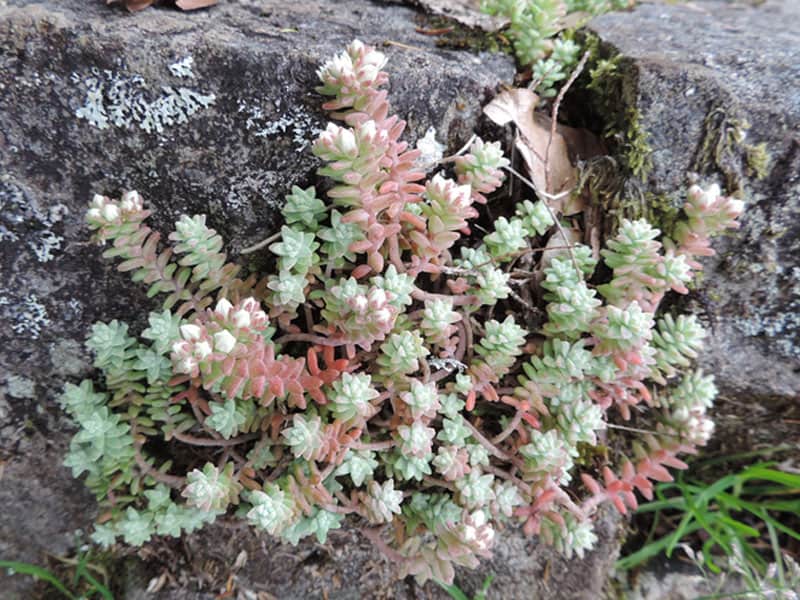
Sedum formosanum
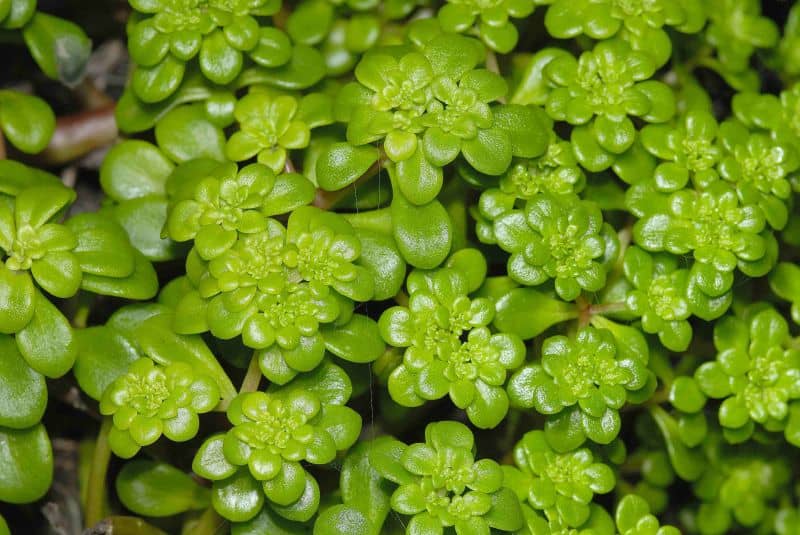
Sedum forsterianum ‘Oracle’

Here’s a sedum with a mystical quality fit for its name! The rounded, powder-blue leaves create an ethereal carpet, while in summer wands of bright yellow starry flowers emerge to provide a sunny contrast. ‘Oracle’ has a way of making even the most discordant areas appear harmonious. No wonder it’s been a rock garden staple for ages!
Sedum furfuraceum
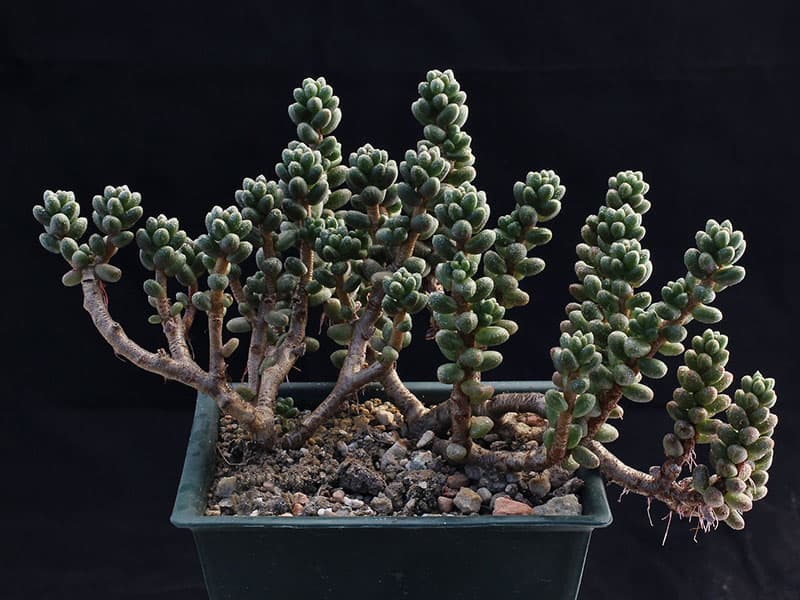
With its quirky looks, this species immediately draws you in for a closer look. The trailing stems are lined with plump whitish-green leaves that look like they’re covered in coarse granules. But the real selling point is the way the foliage takes on shades of pink and red in bright light, almost as if it’s blushing from embarrassment at its crazy appearance! Bright yellow starry flowers provide one final eccentric touch in early spring.
Sedum glaucophyllum
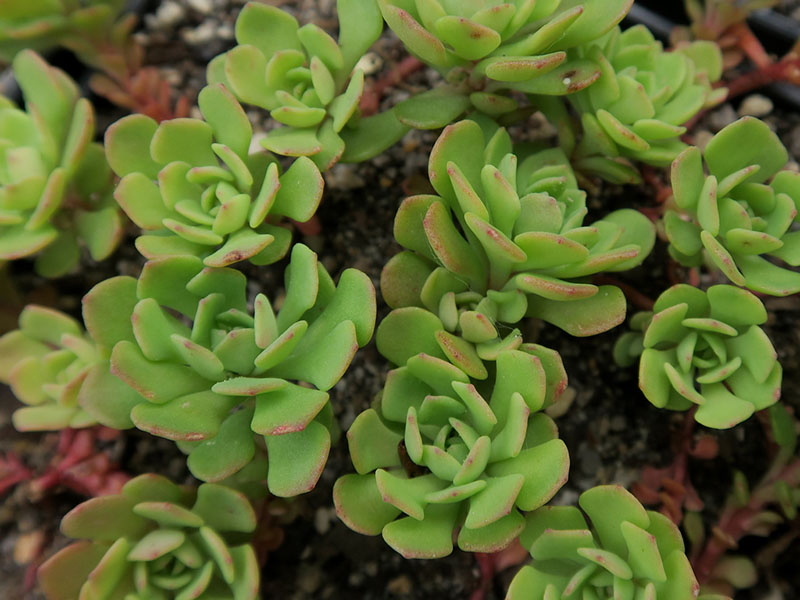
For those who like their sedums on the more demure side, this mat-forming variety is a elegant choice. The frosty blue-green leaves spiral around the stems in tight, jelly bean-like patterns to create an incredibly refined texture. But just when you think it’s too prim, dainty white flower clusters appear in summer, hovering over the foliage like delicate lace. A classy yet still quirky addition to rocks and containers.
Sedum gracile
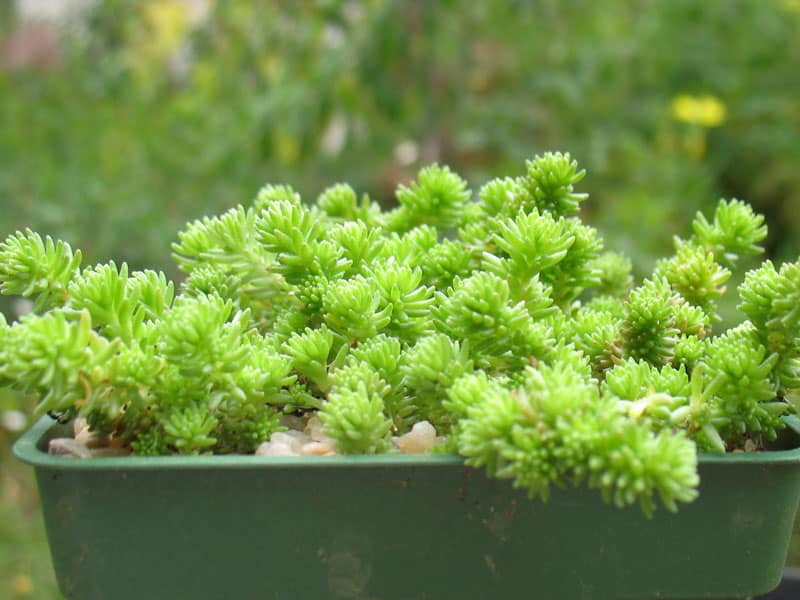
Sedum greggii
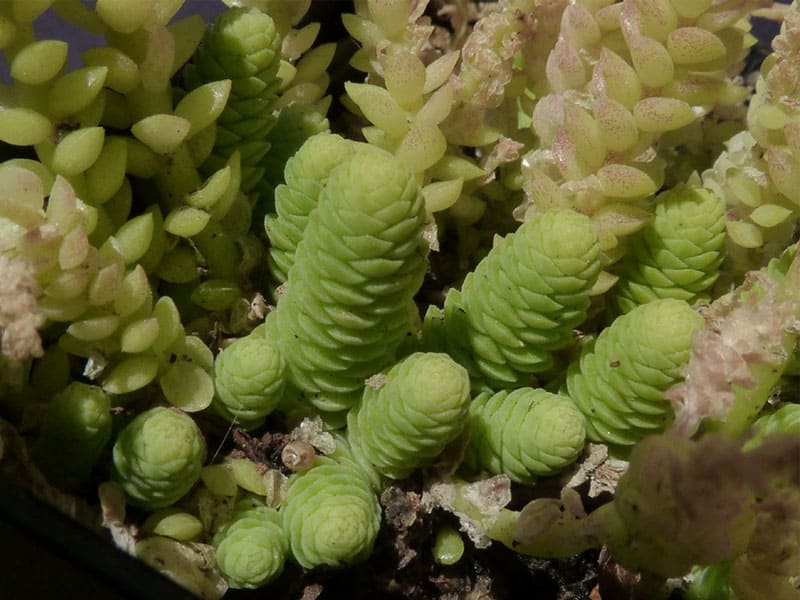
With its cone-shaped rosettes at the base of each flower stem, this variety has a zany, punk-rock kind of vibe. The fleshy blue-green leaves get arranged in funky patterns that continue to evolve after the radiant yellow flowers appear in summer. By fall, the foliage takes on even crazier formations as it clusters into bulbous spires. An eccentric masterpiece for the offbeat gardener!
Sedum grisebachii
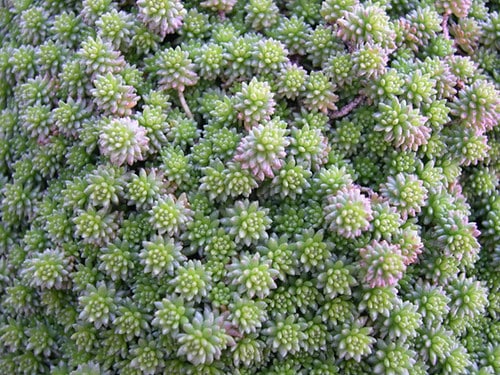
Here’s a sedum that’s perfect for those who like their plants on the unrulier side. A dense mat of wiry stems and minute bead-like green leaves forms a shaggy, unkempt base. But then in summer, dozens of tiny yellow starry flowers appear in a swirling constellation across the entire patch. It’s controlled chaos at its most beautiful and endearing!
Sedum griseum
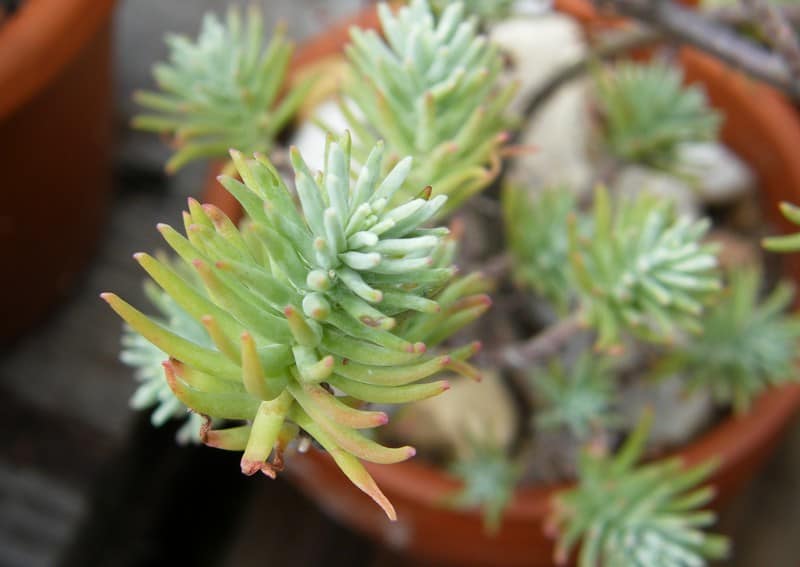
With its dusty blue-green foliage arranged in dense whorls along semi-woody stems, this Mexican variety straddles the line between succulent and sub-shrub. The needle-like leaves give it an exotic, almost spiky look that’s sure to turn heads. But the clustered starry white flowers only amp up the drama when they arrive in winter. A bold, eye-catching specimen for sun-baked areas!
Sedum guatemalense
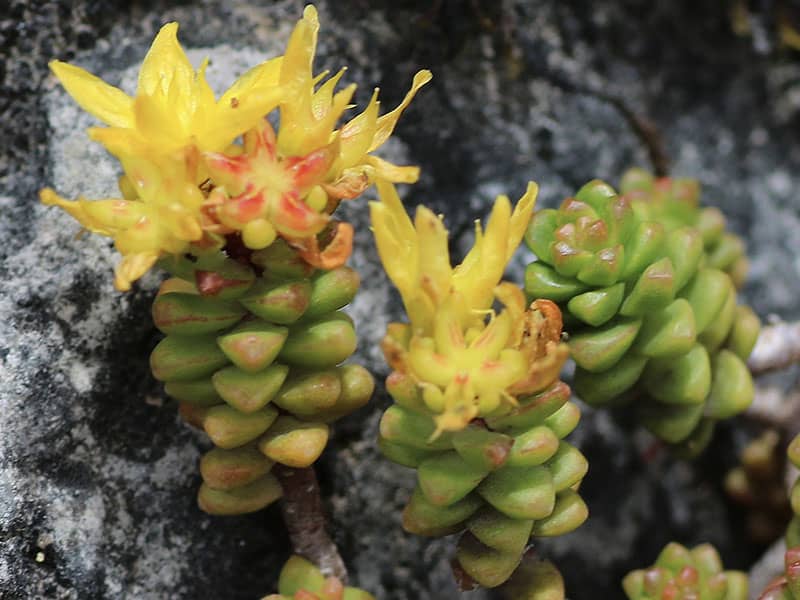
Sedum gypsicola
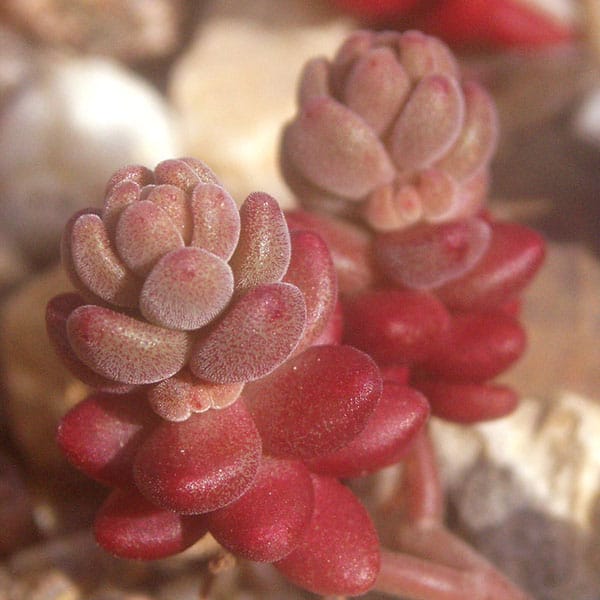
Sedum hakonense ‘Chocolate Ball’
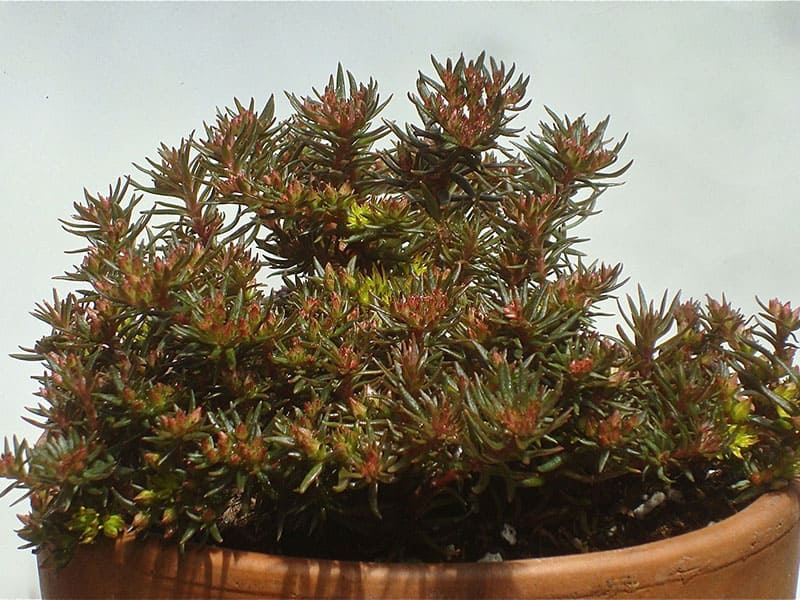
With rich velvety chocolate-brown foliage so chunky and plump it looks good enough to eat, this variety is an indulgent treat for sedum lovers. The низкая mounded shape maintains a tidy, tailored presence too. But when the bright yellow starry flowers appear in summer, they provide a brilliant sunny contrast to all that molten lushness. A must-have for adding opulent tones to containers and gardens!
Sedum hernandezii
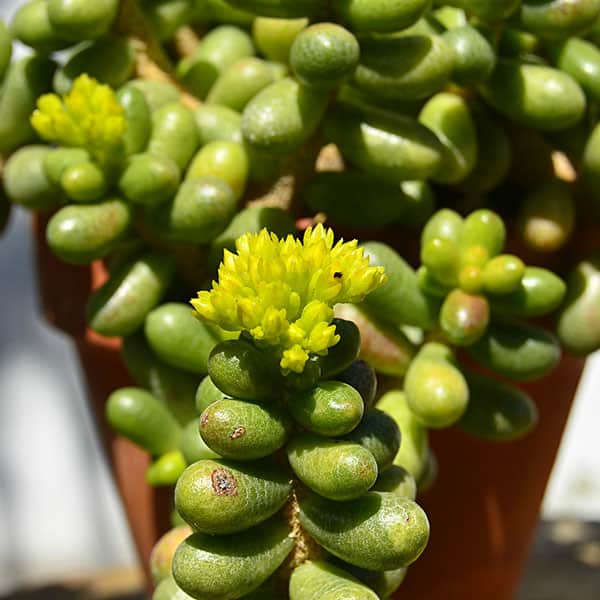
For fans of the classic jelly bean sedums, this Mexican variety is sure to become an instant favorite. The chubby teal-green leaves have that signature cracked exterior, tumbling along the stems in shaggy patterns. But in winter and spring, the groovy foliage gets completely overshadowed by sprays of brilliant yellow starry flowers that practically glow against the cool succulent hues. A garish showstopper!
Sedum hintonii
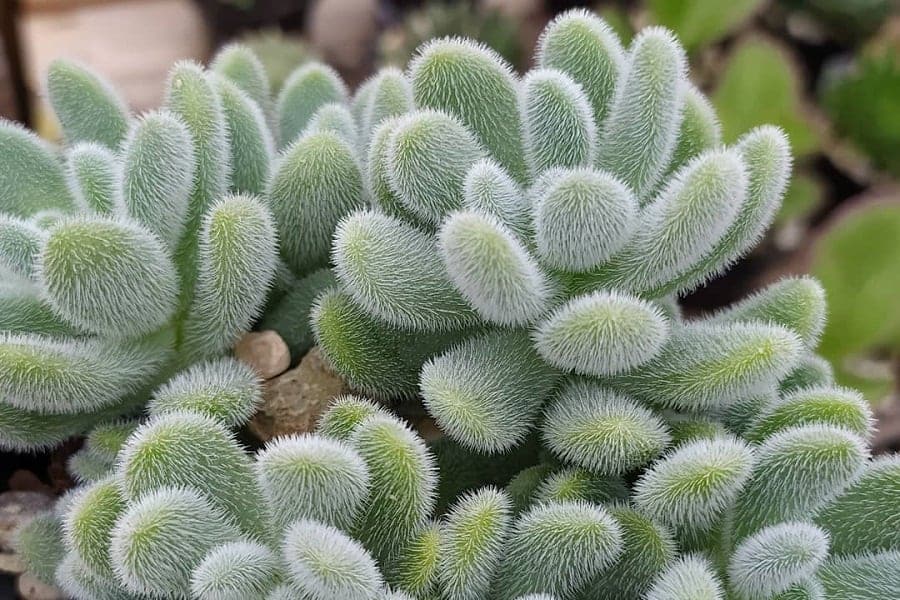
With its chubby, egg-shaped leaves covered in fuzzy white whiskers, this variety is an absolute charmer! The fleshy jade-toned foliage spirals along the short stems in adorable patterns. But then the whole plant gets studded with celosia-like clusters of sunny yellow starry flowers that practically vibrate against all that powdery grey-green color. A real cutie for dish gardens and novelty containers.
Sedum hirsutum
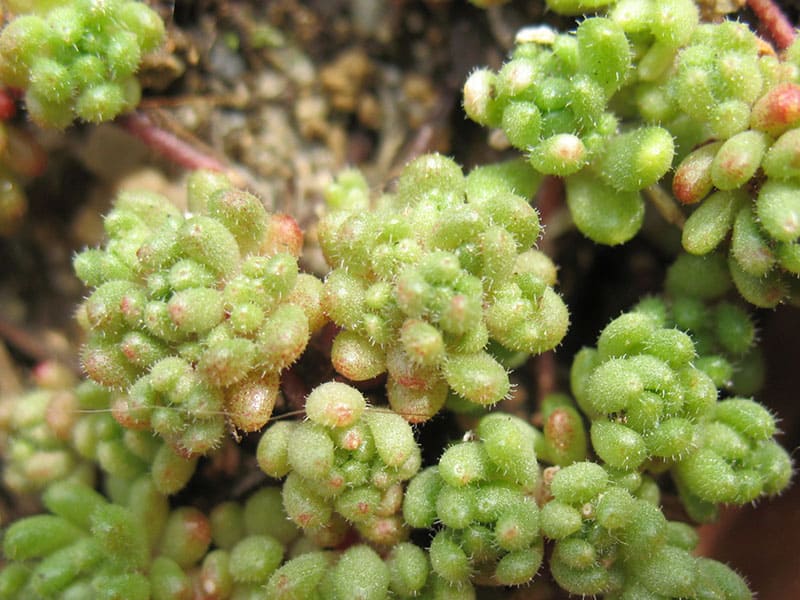
Don’t let the plain name fool you – this little alpine stonecrop is one hairy dude! The petite rosettes are coated in a fuzzy pelt of white bristles, making the plump green leaves resemble tiny cacti pads. But the quirky textural looks are just an opener for the real show – sprays of pure white starry flowers that look like petite bursts of cotton. A real novelty item for dish gardens and troughs.
Sedum hirsutum subsp. baeticum
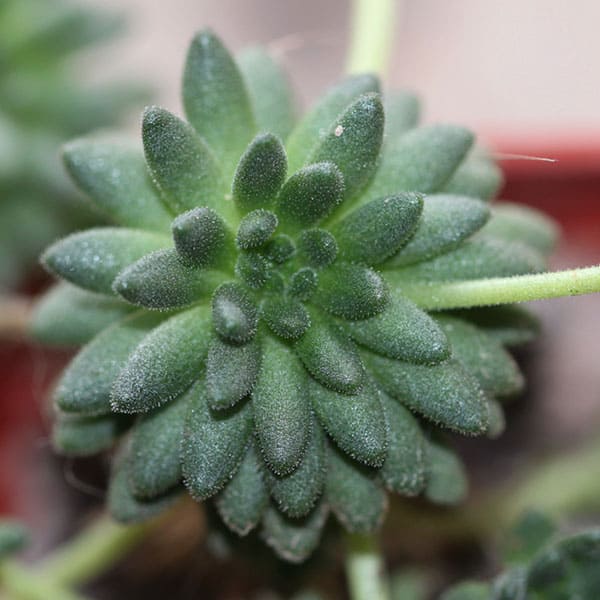
As if the regular Hairy Stonecrop wasn’t quirky enough, this Spanish subspecies takes the fuzzy, hedgehog-like look to new extremes! The miniature rosettes resemble tiny beige pincushions coated in a thick fuzz of white bristles. But then in summer, sprays of dainty pinkish-white starry flowers emerge from the centers, creating a stunning contrast with the woolly succulent foliage. A real novelty item that’s sure to delight anyone who adores oddities for the rock garden or dish.
Sedum hispanicum
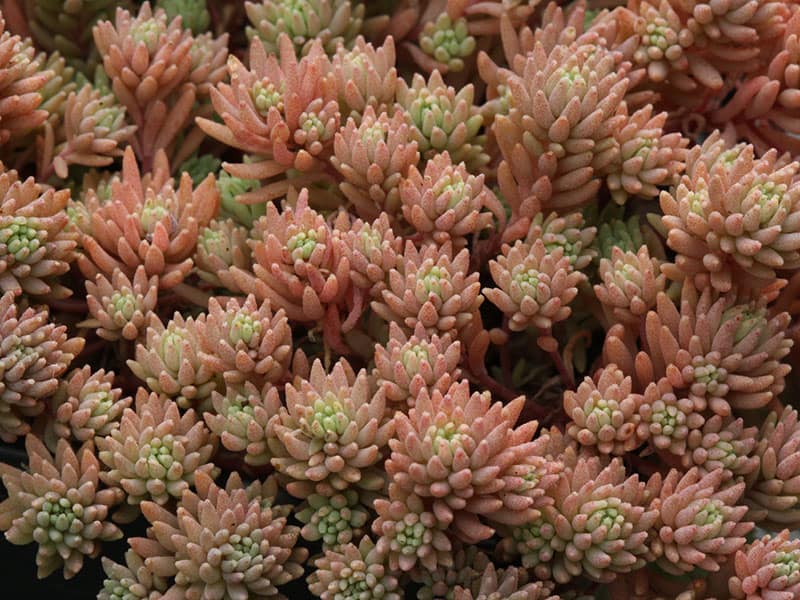
With its lush blue-green foliage that transitions to powder-blue in summer, this sedum makes an elegant yet easygoing groundcover or rock garden accent. The density of the wiry stems and feathery leaves helps it stay looking perpetually groomed too. When the dusty pink flower clusters arrive, they provide a soft, romantic finishing touch without being overpowering.
Sedum humifusum
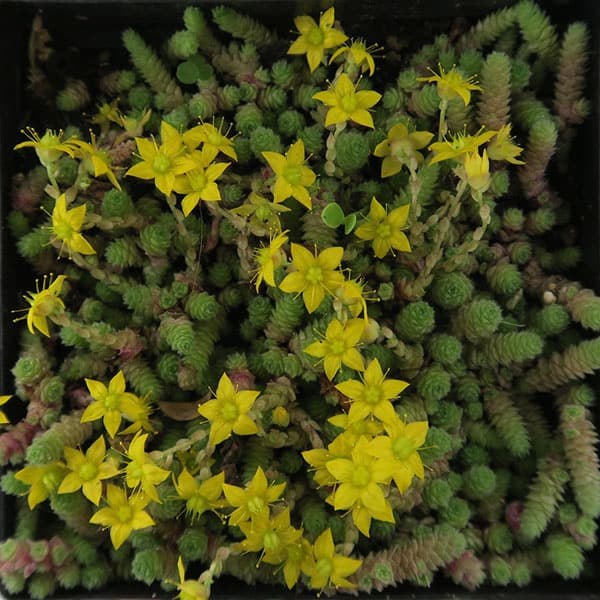
If you love sedums on the more eccentric side, this tiny species is sure to delight. The tomato-red stems and blazing yellow flowers provide a zesty color contrast in spring. But the real showstopper is the way the fat green jelly bean leaves take on vivid crimson shades in hot or cold conditions, making the whole plant glow brilliantly. Plant it anywhere you need a bolt of vibrancy.
Sedum hybridum
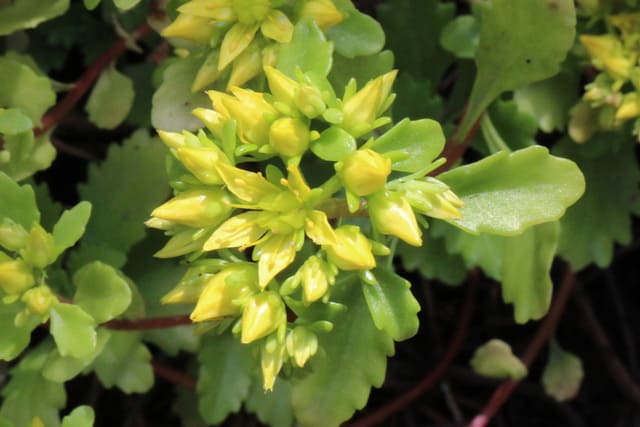
Why just stick with green when you can have red and green? This colorful interspecies hybrid stonecrop forms a vibrant tapestry of burgundy and emerald succulent foliage that maintains its bicolor display all season long. But just when you think it can’t get any better, sprays of brilliant yellow starry flowers appear in summer to amplify the eye-catching effect even further. A real showstopper for groundcover or containers!
Sedum integrifolium
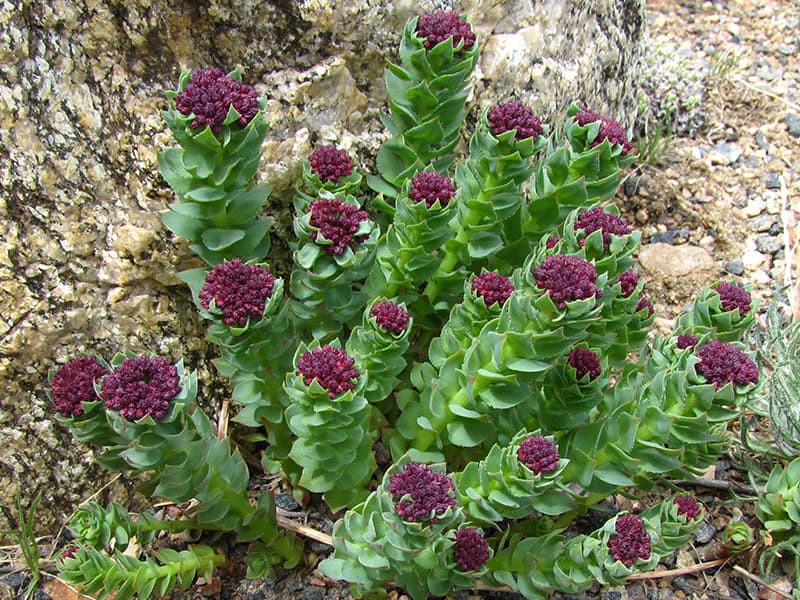
With its broad, plump blue-gray leaves arranged in perfect rosettes, you’d never guess this variety hails from some of North America’s harshest environments! But those cute succulents help it withstand anything from blistering heat to subzero cold. And once summer arrives, sprays of golden yellow starry flowers add a brilliant finishing touch to the foliage. An extraordinary plant for ordinary conditions!
Sedum japonicum ‘Tokyo Sun’
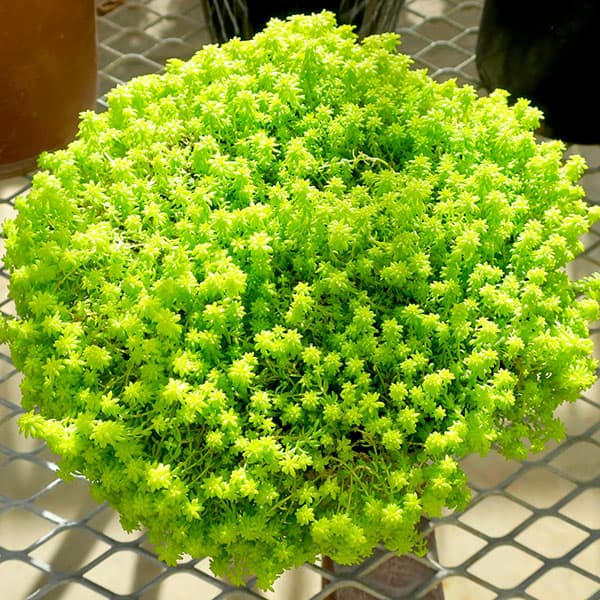
Here’s a sedum that embraces its role as sunworshipper to the fullest! The vibrant lemon-lime whorls maintain their radiant golden glow as long as you provide enough bright light. But that’s just the start of the ray-soaking fun – in summer, domed clusters of tiny yellow starry flowers appear to amplify the electric effect even further. Plant it where it can saturate itself in sun all day long.
Sedum jurgensenii
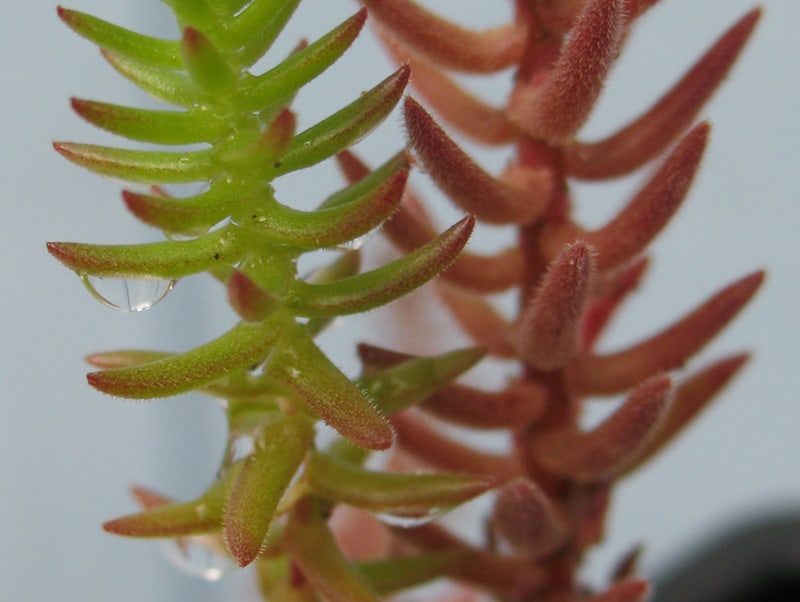
Sedum kamtschaticum
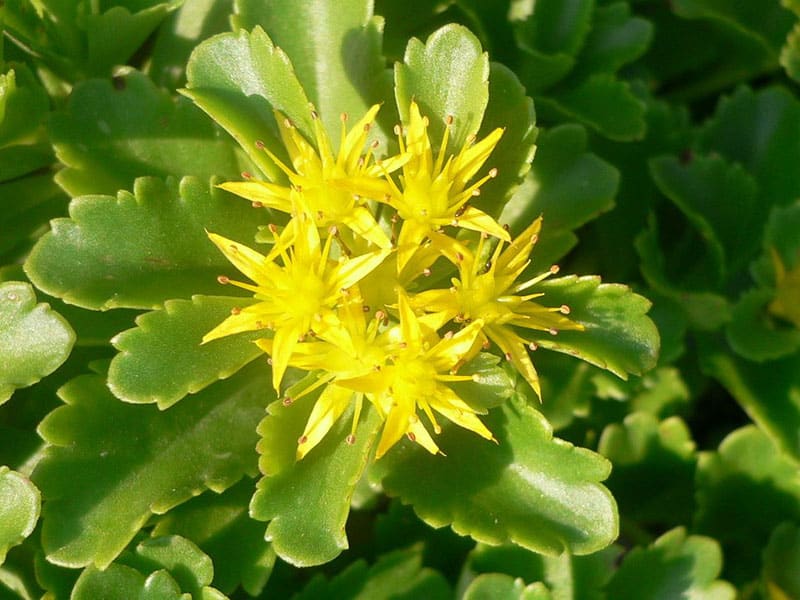
With its chunky, spooned succulent foliage that blushes ruby-red in fall, this Russian native already has plenty of personality. But when those clusters of brilliant yellow starry flowers appear in late spring, it kicks the vibrance into overdrive. Whether planted as a compact groundcover or trailing accent, it delivers nonstop color from spring to fall. No surprise it’s been a Eurasian garden staple for ages!
Sedum kimnachii
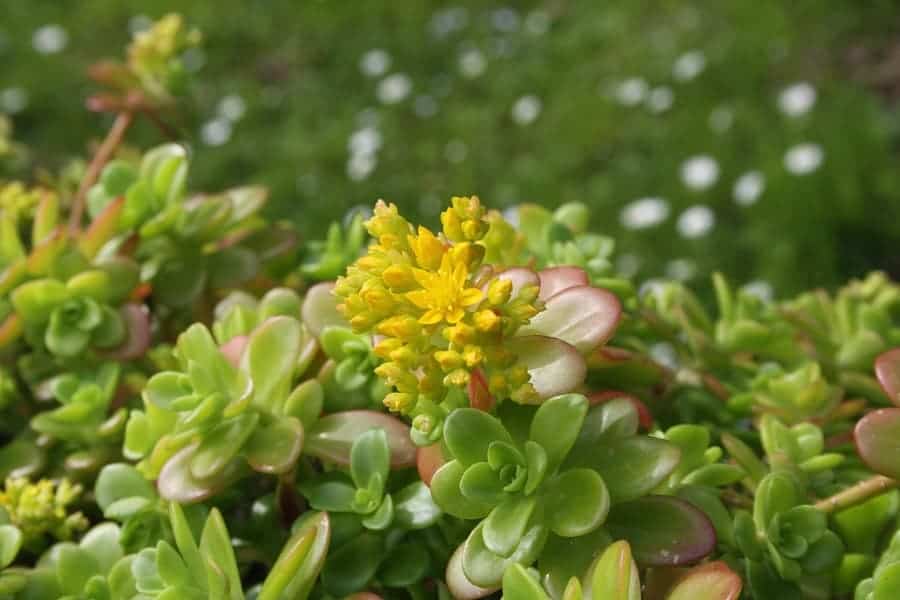
With its dense rosettes of glossy green jelly bean leaves that blush crimson at the tips, this Mexican sedum already has tons of personality. But then it goes full-on drama queen when the bubblegum pink flower buds burst open in summer, practically smothering the entire plant in starry blooms. Whether contained in a pot or allowed to sprawl, it delivers nonstop vibrance all season long.
Sedum lanceolatum
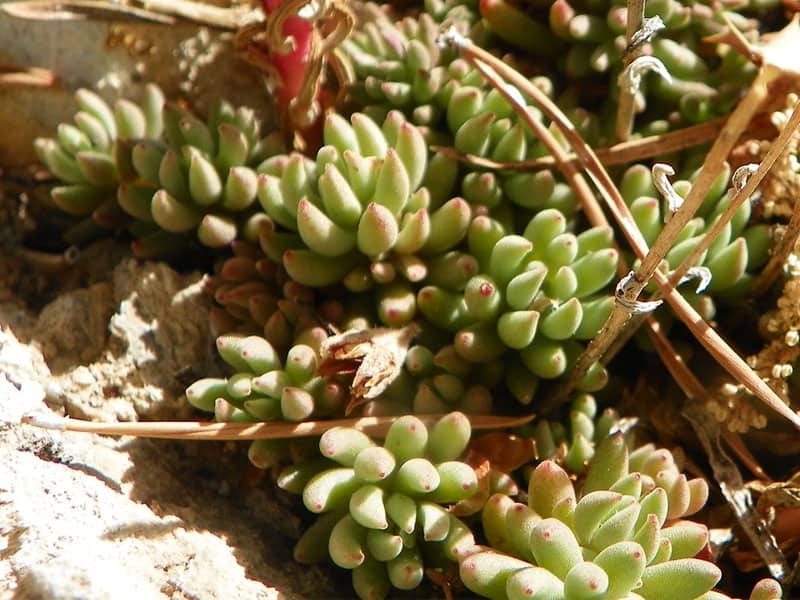
Don’t let the petite size of this European native fool you – it packs a pretty big punch! The slender blue-green leaves may be tiny, but they spiral around the trailing stems in orderly patterns to create a refined look. Then in summer, sprays of pale yellow starry flowers add an airy, ethereal element. A delicate yet stylish option for rocks, walls and troughs.
Sedum laxum
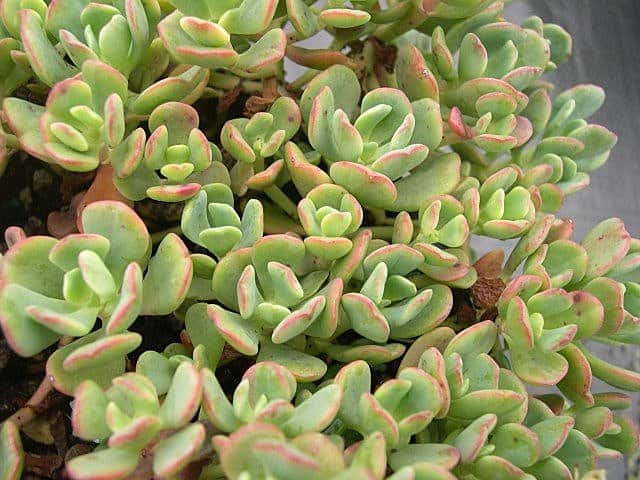
Here’s a distinctive stonecrop that marches to the beat of its own drum! Instead of the standard yellow or white blooms, ‘Roseflower’ unleashes masses of pale pinkish flowers that create a soft, romantic haze when they appear in summer. The powdery blue foliage sets the perfect stage too. A pretty yet still quirky choice for rock gardens and containers.
Sedum lineare ‘Variegatum’
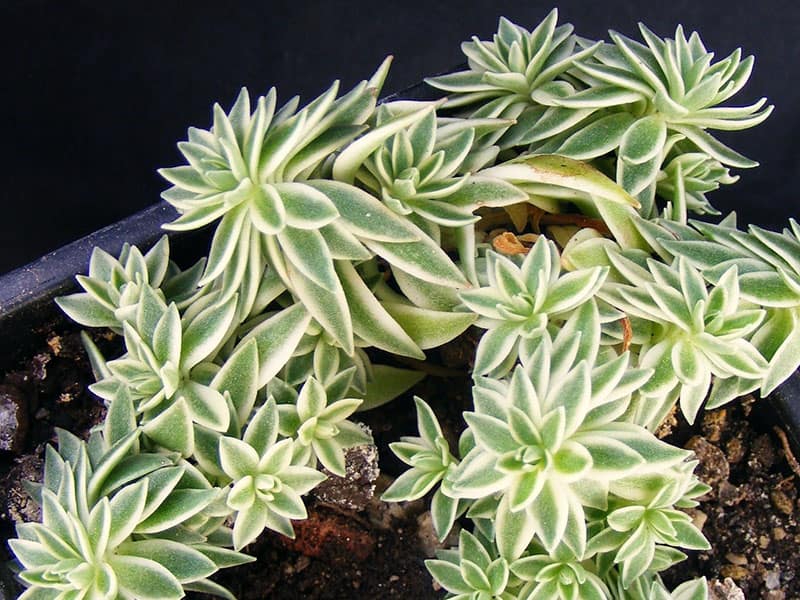
With its tiny, bead-like leaves edged in creamy yellow and arranged in perfect toupée patterns along the stems, this spreading stonecrop is one dapper little groundcover! But the elegant looks are just the opening act for the real show – a smattering of brilliant yellow starry flowers that arrive in early summer to double the electric effect. A classy yet still fun pick for spaces that crave refinement and whimsy.
Sedum litoreum
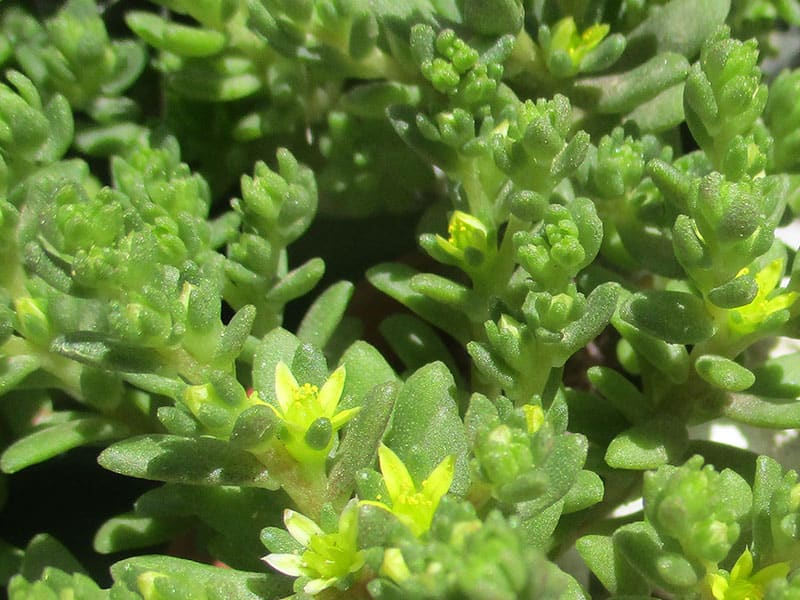
Some of the smallest sedums pack the biggest punches, like this petite 6-inch tall annual from coastal areas. The oblong sage green leaves may be modest, but then the entire plant gets smothered in a confetti burst of pale yellow starry flowers in spring. It’s gardening’s version of a kernel snuck inside a box of crackers – the tiniest surprises are often the most delightful!
Sedum longipes
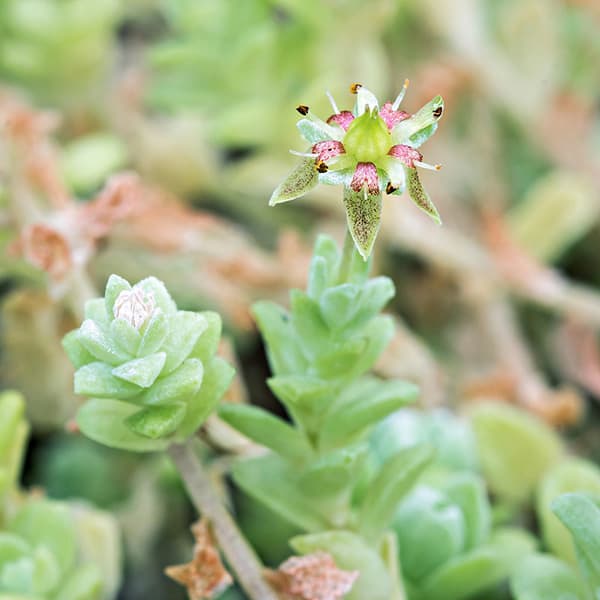
Sedum lucidum
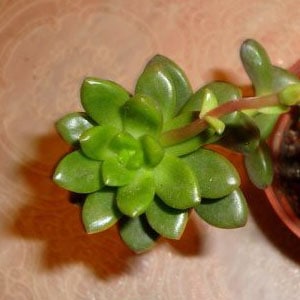
With its chubby green jelly bean leaves arranged in perfect spiral rosettes, this Mexican native already looks pretty animated right out of the gate. But then the ruby red edges and tips appear in sunlight to amp up the eccentric quotient even further. As if that wasn’t enough, fragrant white starry flowers burst forth in winter to provide one final dazzle of whimsy.
Sedum lucidum obesum
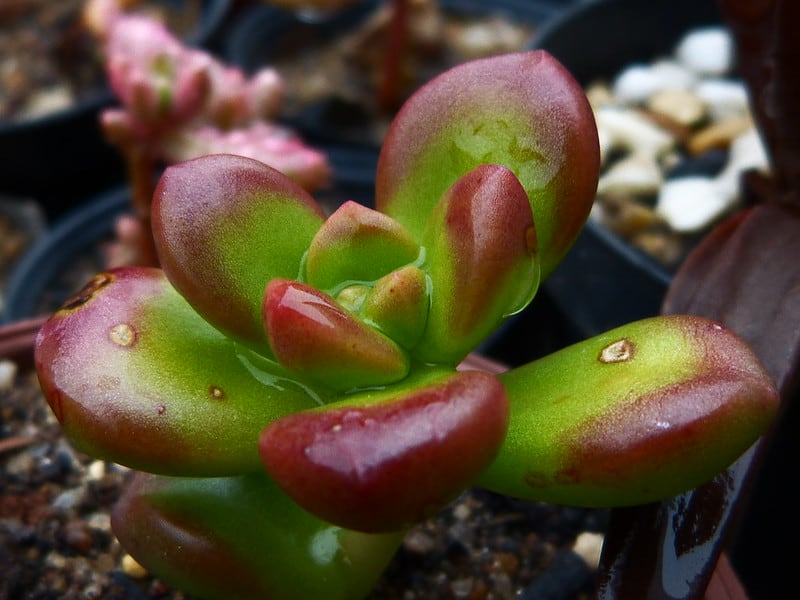
This plumper, rounder version of Sedum lucidum really kicks the chunky looks up a notch! Imagine the classic jelly bean succulent on an all-carb diet and you’ll get a sense of the extra girthy, blinged-out foliage. The radiantly glossed leaves transition from olive green to blazing scarlet as sun exposure increases. But of course it still retains those small but fragrant white flowers for one final eccentric touch.
Sedum makinoi
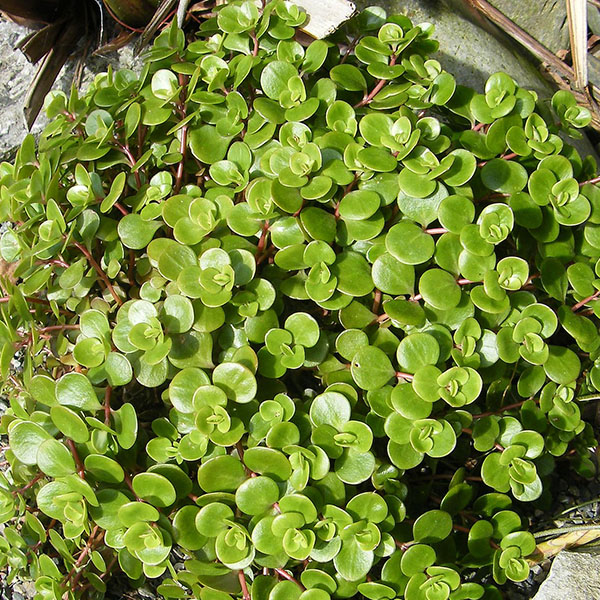
With its mix of chubby blue-green leaves gently trailing along slender stems, this Japanese stonecrop walks the line between cute and refined. The succulent foliage creates a soft, feathery look that’s at once delicate yet rugged. But the sunny lemon-yellow starry flowers that pop up in midummer add just the right touch of radiance to liven things up. A stylishly restrained choice for container edges or rockeries.
Varieties of Sedum makinoi:
Sedum makinoi Limelight
Sedum macdougallii
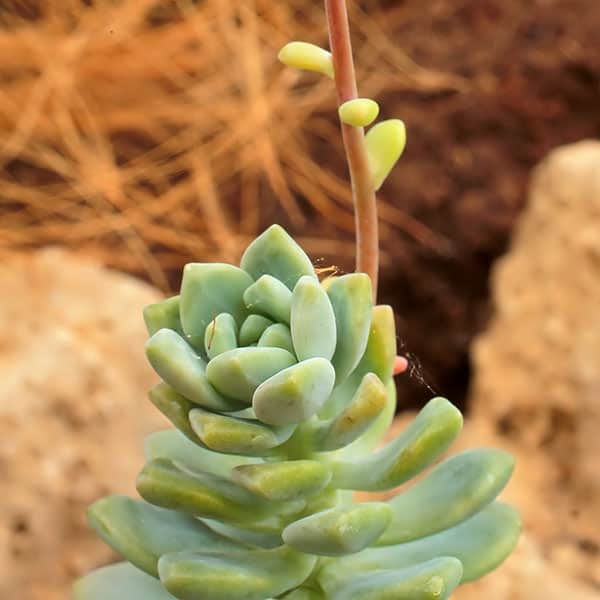
Sedum mexicanum
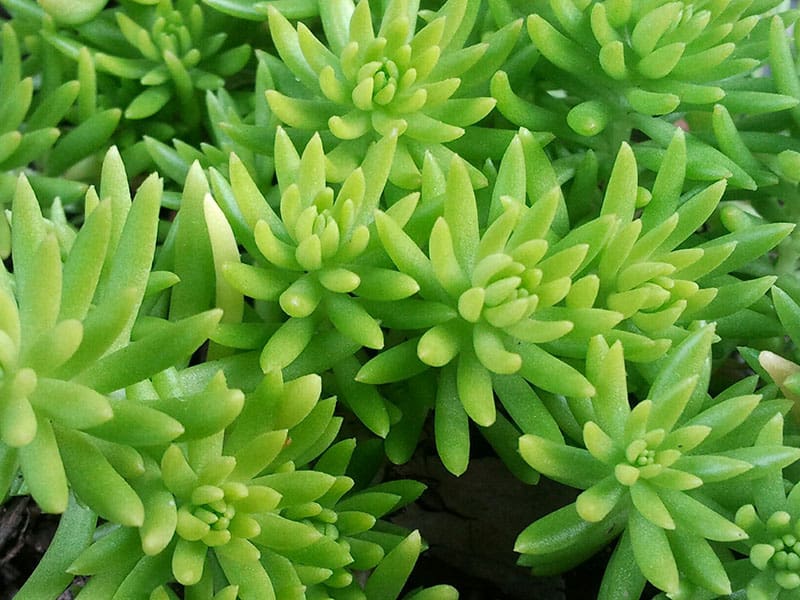
Don’t be fooled by the name – this easygoing groundcover actually hails from China, not Mexico! The fresh lime-green foliage has a soft, feathery look that makes it an appealing filler between stockier plants. But it really struts its stuff in summer when the airy stems get studded with brilliant yellow starry flowers to amplify that sunny disposition even further. An unpretentious yet still charming choice.
Sedum microsepalum
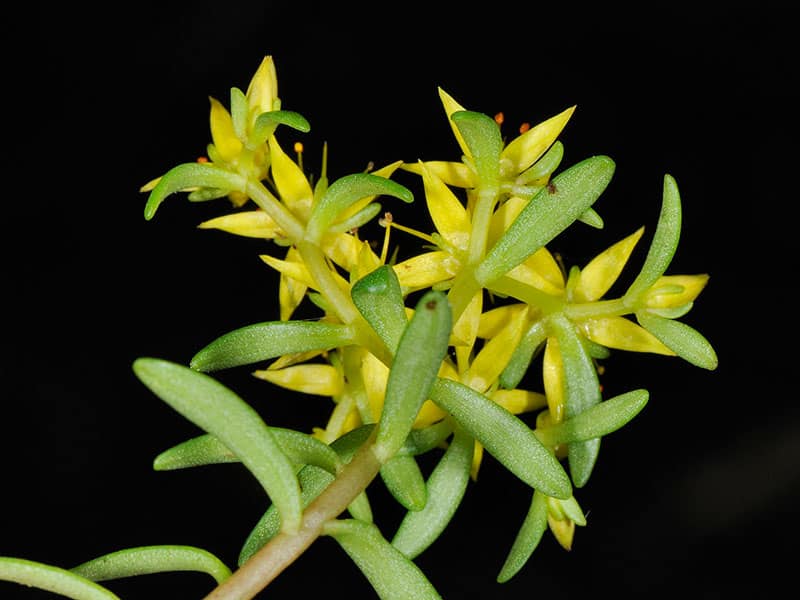
Sedum mocinianum
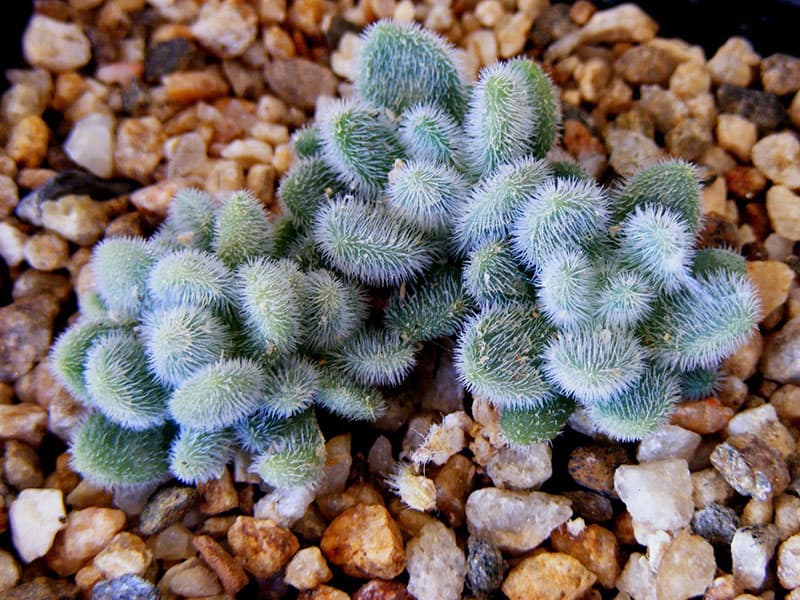
Get ready for some serious stem drama with this distinctive Mexican stonecrop! The thick rubbery leaves get arranged in mesmerizing spiral patterns along pendant stems up to 3 feet long, giving it an almost codelike geometric look. But when the creamy white starry flowers arrive in winter, dusted with ruby red anthers, it’s pure nature’s calligraphy. A real standout for baskets or raised areas where it can spill and trail.
Sedum monregalense
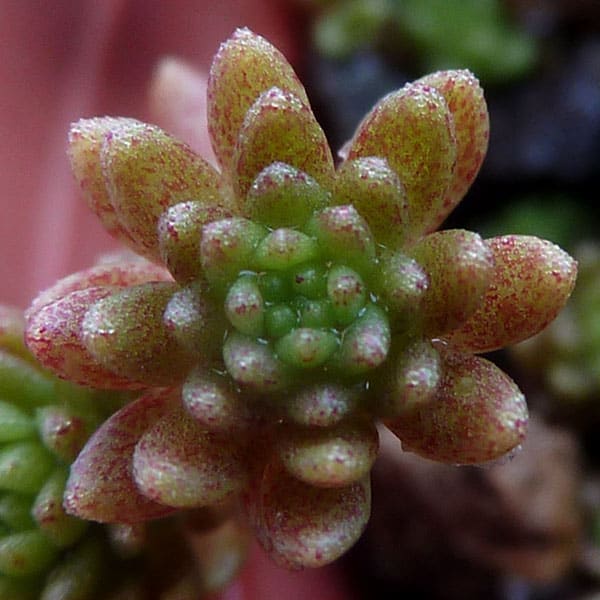
Here’s a compact little sedum that brings a bolt of crazy texture to any rockery or container planting. The thick blue-green leaves spiral in tight concentric circles to form neat toupée patterns at the stem tips. When the white starry flowers appear in summer, they create a soft hazy contrast against the bold succulent coils. Très chic in a way that only sedums can pull off!
Sedum montanum
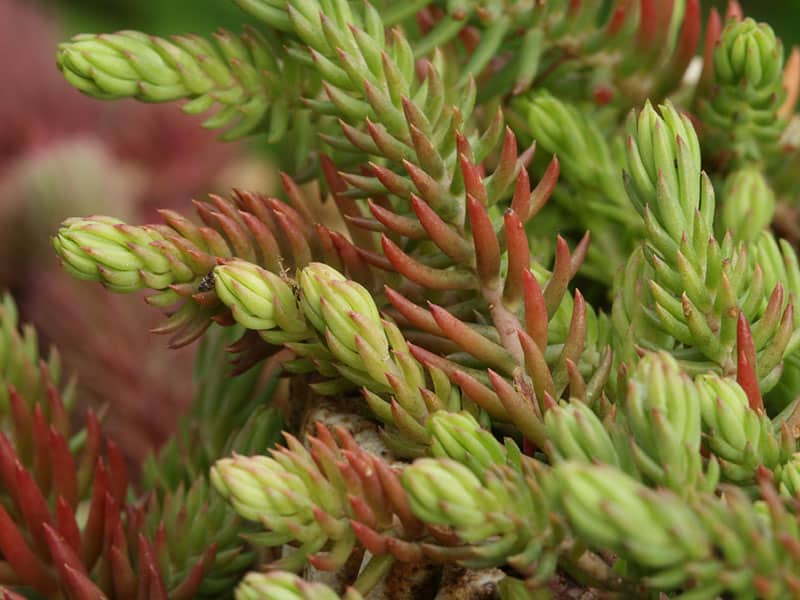
Sedum montanum subsp. orientale
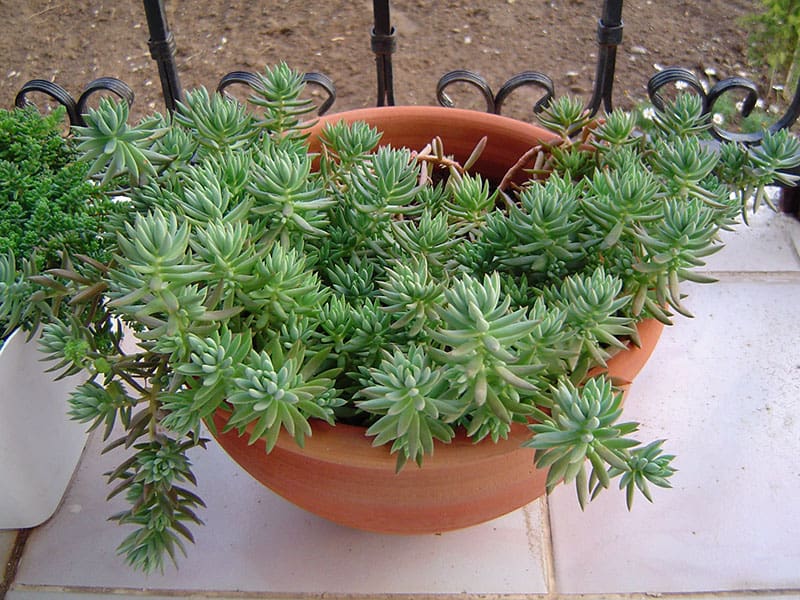
This variety from eastern Asia is like a miniature blue spruce tree reimagined as a stonecrop! The needle-like blue-green leaves spiral along the stems in precise patterns, creating a perfectly symmetrical coniferous look. But lest you think it’s too prim and proper, the foliage bursts into shades of vivid purple and pink come fall, giving it an electrifying cool-weather display. Top that off with sprays of sunny yellow flowers in summer and you’ve got one wildly charismatic little plant for rocks and troughs!
Sedum moranense
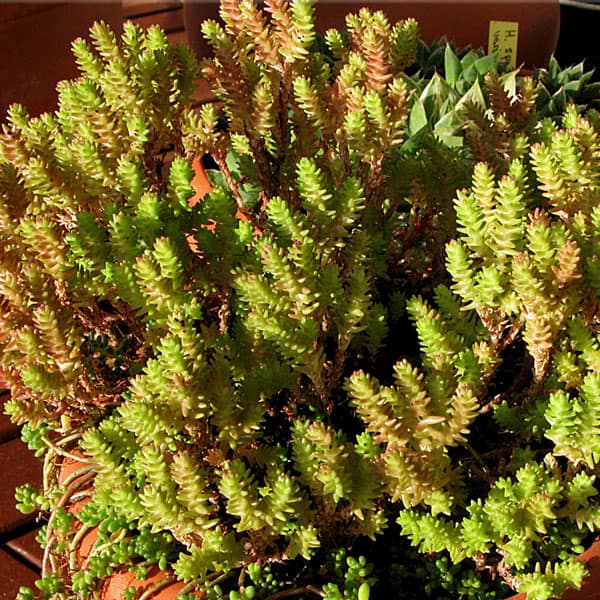
Like a mermaid transforming from the sea, this vibrant Mexican sedum goes through a dazzling spectrum of color changes. The chubby blue-green leaves start off looking rather plain, but then fluorescent red tones start spreading from the tips and edges as temperatures drop, eventually achieving full scarlet saturation. Throw in those dainty white flower clusters and you’ve got one sizzling head-turner for winter containers!
Sedum moranii
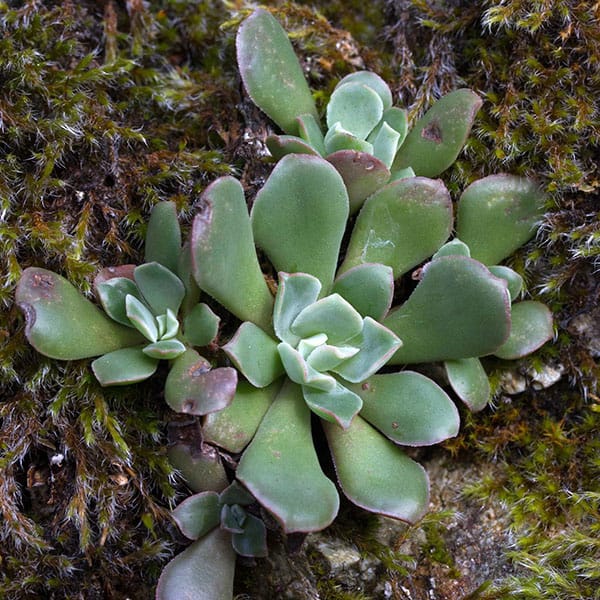
This ultra-rare Oregon native stonecrop is like a quirky little friend you’ll want to treasure and protect. The fleshy blue-gray leaves form miniature rosettes that almost appear to be squinting up at you with an endearing expression. In late spring, sprays of tiny white starry flowers add a wispy, ethereal element. But what really makes Sedum moranii special is knowing it only exists in a few locations along the Rogue River, making every specimen feel like a precious gem. For discriminating sedum collectors only!
Sedum morganianum
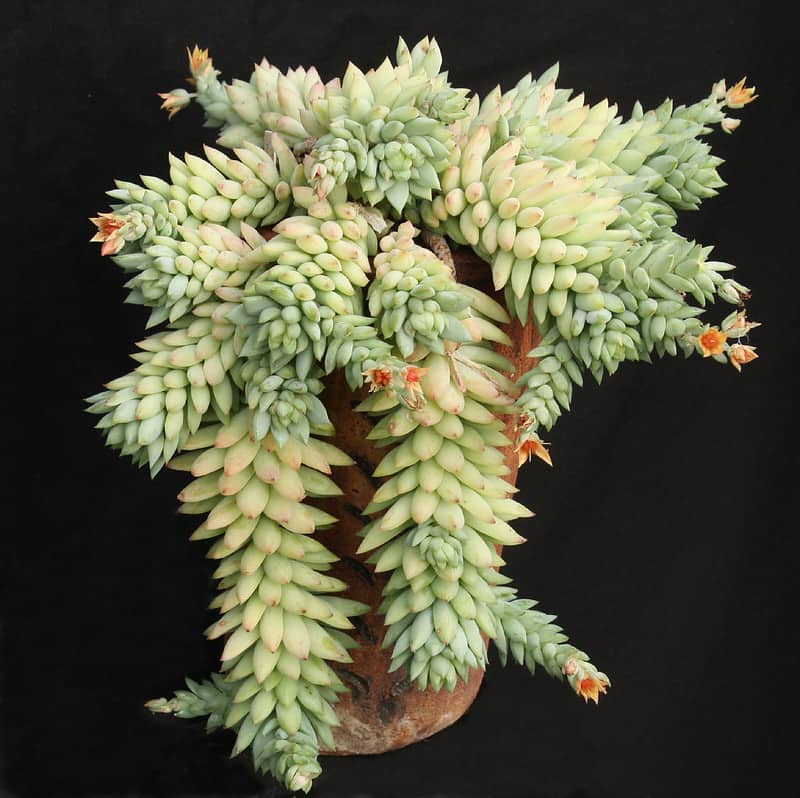
Fans of the classic burro’s tail sedums will go gaga over this stunning trailing variety from Mexico. The plump blue-green leaves overlap in alluring, curvaceous patterns along the pendulous stems, creating the most sensuous calligraphic display. But then the whole plant goes full showstopper when sprays of hot pinkish-red flowers emerge in spring to light up the show. A must-have for baskets or raised areas!
Sedum morrisonense
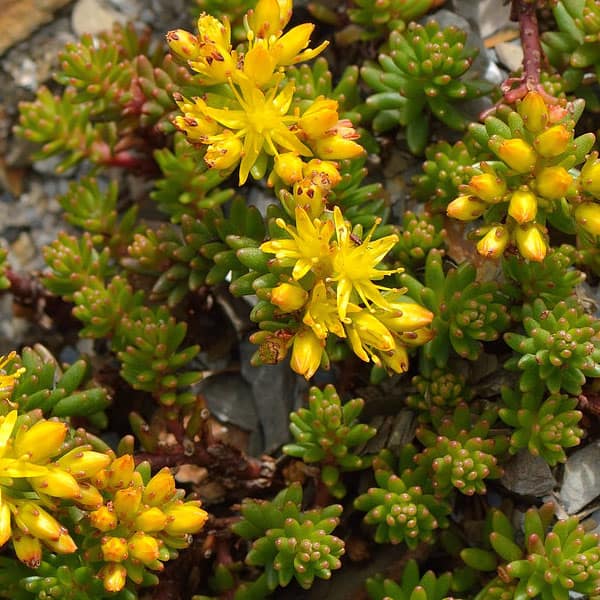
Sedum mucizonia
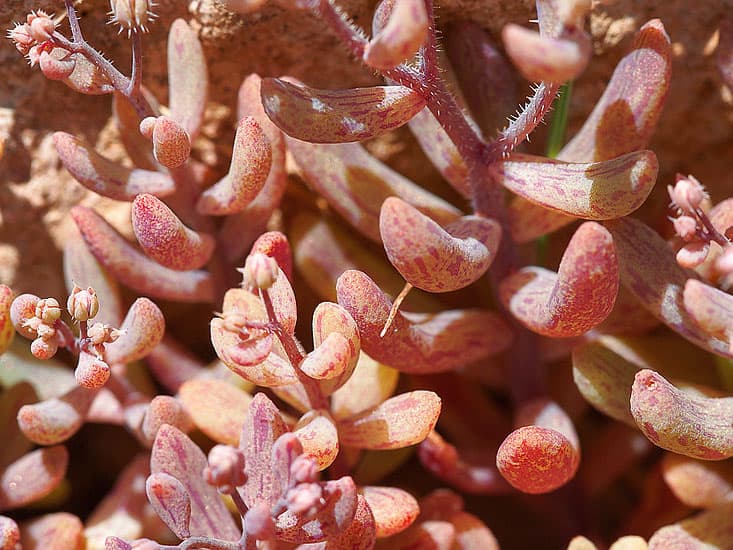
Sedum multiceps
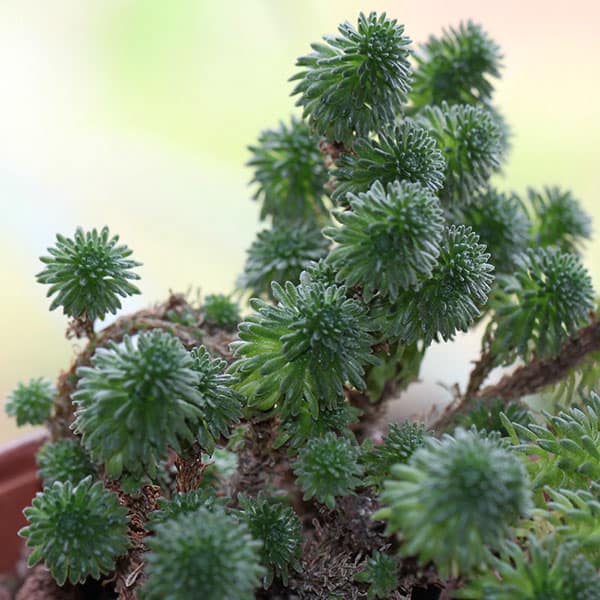
Imagine the famous twisting branches of the Joshua Tree shrunk down to adorable pint-sized proportions and you’ll get a sense of this variety’s unbelievable novelty appeal! The thick, succulent stems only reach a few inches tall but they get completely covered in tightly overlapping blue-green leaves, creating the most uncanny miniature tree-like shapes. Then in summer, large buttery yellow starry flowers appear in clusters atop each “trunk” as if nature is playing a delightful trick on you. Prepare to do a double-take every time you see this one!
Sedum muscoideum
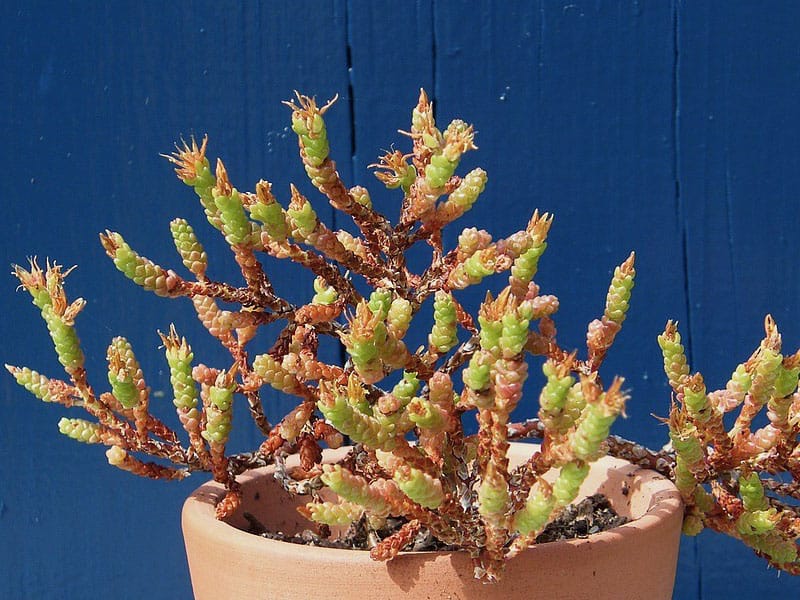
With its tight, imbricate blue-green leaves plastered along thin upright stems, this little stonecrop already looks like a zany desk accessory right out of the gate. But then those oversized lemon-yellow starry flowers arrive in summer, bodaciously overwhelming the minimalist succulent foliage as if to loudly proclaim “Hey, look at me!” A real conversation piece for troughs and novelty plantings.
Sedum nevii
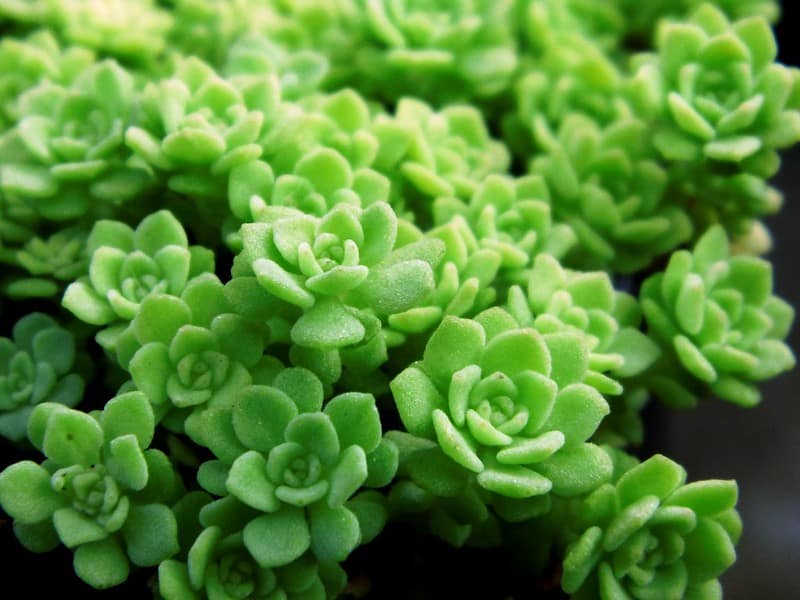
As charming as its name is challenging to pronounce, this southeastern native sedum wins you over with its cute patterning and bold coloration. The pinwheel rosettes are composed of plump blue-green jelly beans that develop a copper sheen in sun. But the whole plant gets virtually buried in early summer when masses of tiny white flower clusters erupt for a delicate, lacy finish. A quirky yet easy-to-love groundcover.
Sedum nussbaumerianum
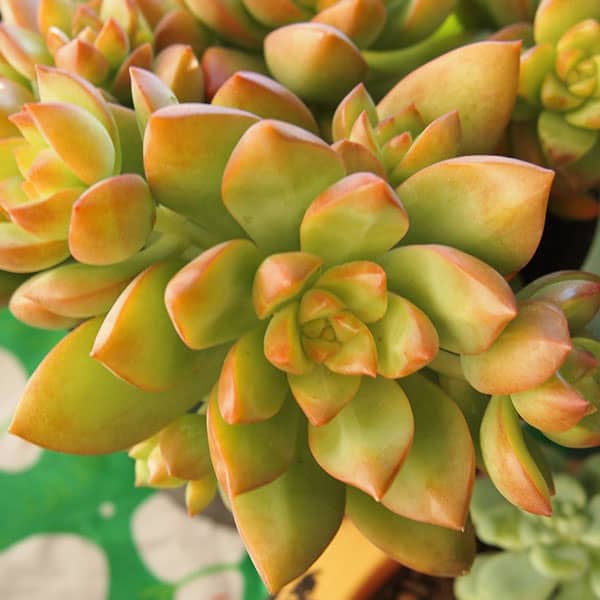
Here’s a sedum that truly earns its common name of Coppertone! The pointed succulent foliage takes on electrifying shades of rosy-peach to glowing amber when exposed to plenty of sun, practically radiating warmth in the garden or container. But just when you think it couldn’t get any hotter, sprays of lemon-yellow starry flowers arrive to amp up the incandescence even further. A real sizzler!
Sedum oaxacanum
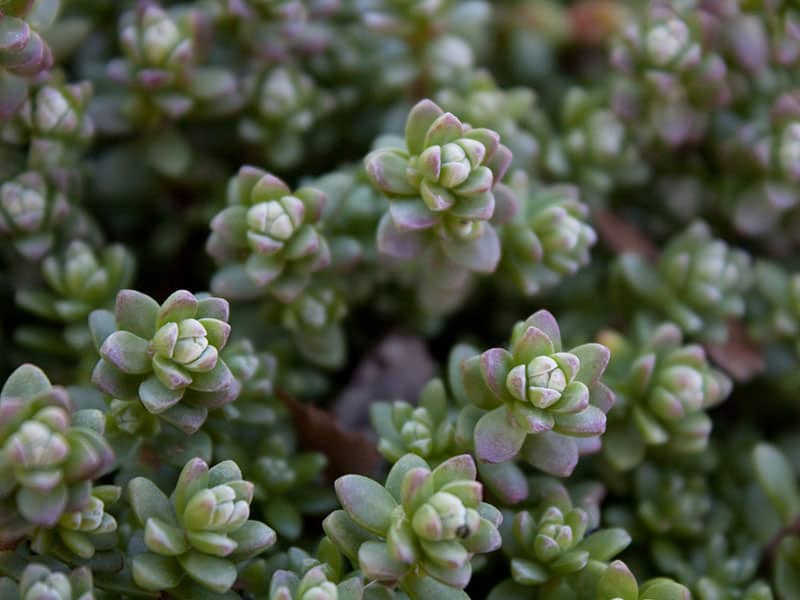
For sedum lovers who like them low, wiry and with tons of intricate details, this Mexican variety is sure to delight. The mounding mat of powder-blue jelly bean leaves is already a marvel of geometry arranged along burgundy-tinted stems. Then the sprays of brilliant yellow starry flowers arrive in summer, hovering over the succulent coils with radiant elegance. An absolute gem up close!
Sedum obcordatum
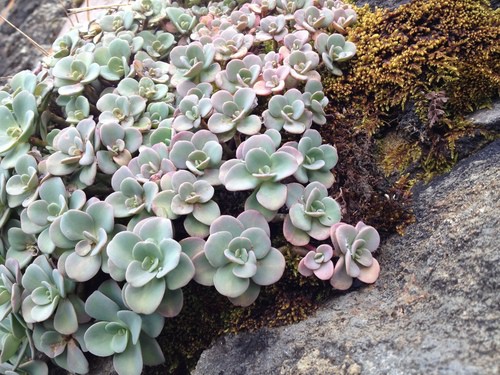
Don’t let the tongue-twisty name intimidate you – this Mexican stonecrop is one friendly, cheerful plant! The plump, rounded blue-green leaves arranged in lax spiral patterns give it an adorably rumpled look. But then the entire plant gets cloaked in a brilliant shade of buttercup yellow when the starry flower clusters burst open in spring. It’s like a ray of sunshine landed right in your garden bed or container to provide an annual pick-me-up. Simple joys are sometimes the most rewarding!
Sedum oblanceolatum
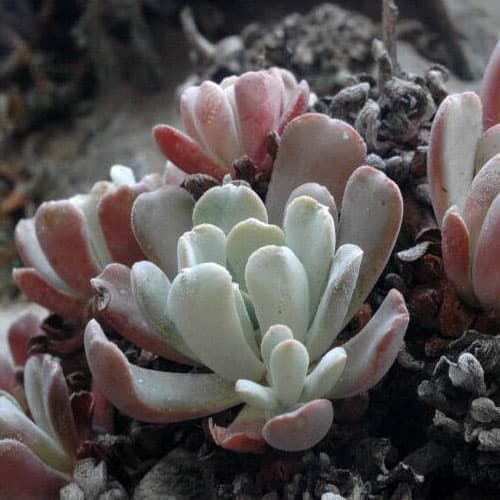
This rare western native stonecrop has a subtle, almost moonlit beauty to it that’s sure to enchant. The dusty blue-grey leaves form tight rosettes that multiply sideways in snowflake-like patterns to create delicate, lacy textures. But then in summer, sprays of pale creamy yellow starry flowers provide an iridescent finishing touch. An ethereal yet hardy option for rock gardens and troughs.
Sedum obtusatum
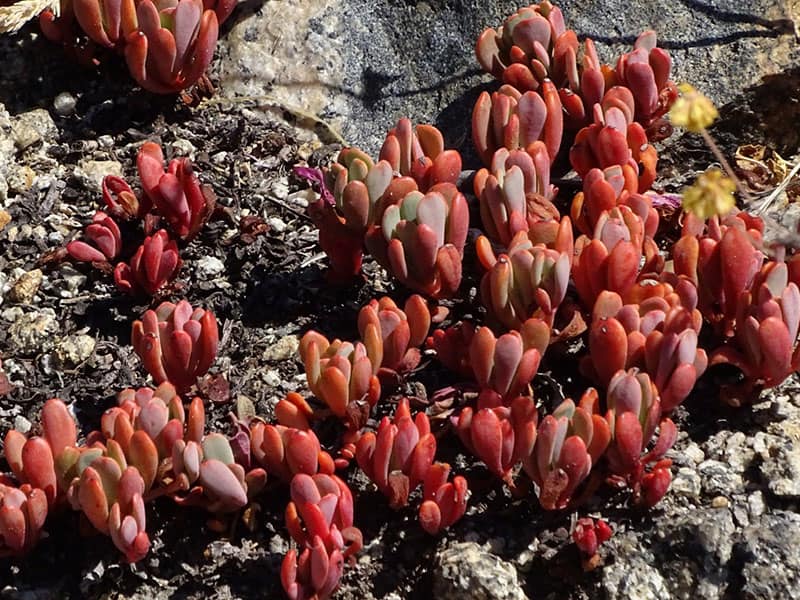
Imagine a plump red starfish covered in a dusty silver bloom and you’ll get a sense of this variety’s odd yet alluring look. Each chubby leaf is rounded with a flat top and widest below the tip, arranged in tidy rosettes. But the weirdness factor multiplies when the flat-topped yellow flower clusters appear looking like little golden clouds hovering over the succulent foliage.
Sedum obtusifolium
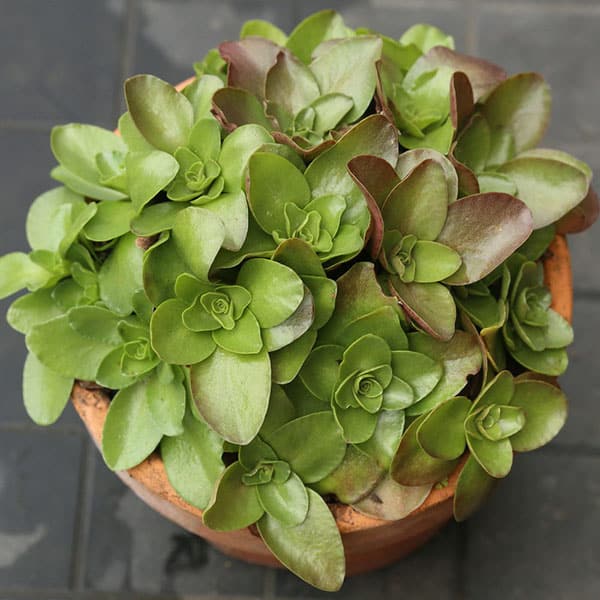
With its wide, rounded blue-green leaves arranged in perfect Little Mermaid-esque rosettes, this Iranian sedum is already an offbeat beauty. But then it absolutely kicks the drama into high gear when those fleshy whorls get completely concealed beneath masses of hot pinkish-white starry flowers in summer, creating a wild floral pincushion effect. A true spectacle for containers or rockeries!
Sedum ochroleucum ‘Red Wiggle’
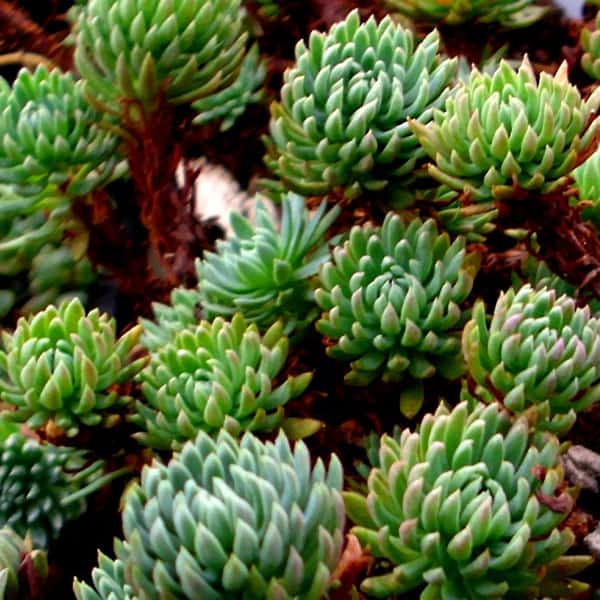
This funky little stonecrop cultivar brings some serious zest to any planting! The needle-like foliage takes on a wild, undulating pattern of green and blazing red/burgundy hues that seems to wiggle and dance across the ground. But just when you think it couldn’t get any crazier, sprays of sunny yellow starry flowers arrive in summer to amplify the sizzle even further. An absolute wild child that’s perfect for injecting offbeat vitality.
Sedum orbatum
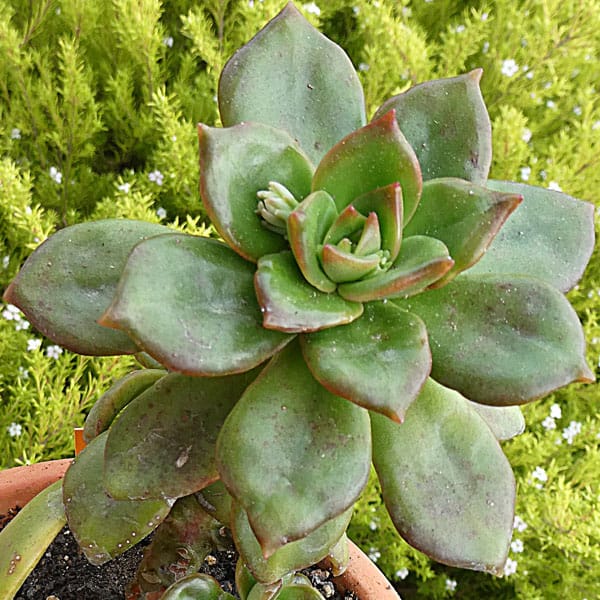
Here’s a plump and punchy sedum to add some robustness to your garden! The broad, spoon-shaped green leaves take on shades of merlot as the weather warms, assembling into perfect rosettes like floral coasters ready for drinks. An already sturdy compact presence gets amplified when the tall, architectural plumes of white starry flowers with violet-blushed petals emerge in summer. A refreshing departure from daintier species!
Sedum oreganum
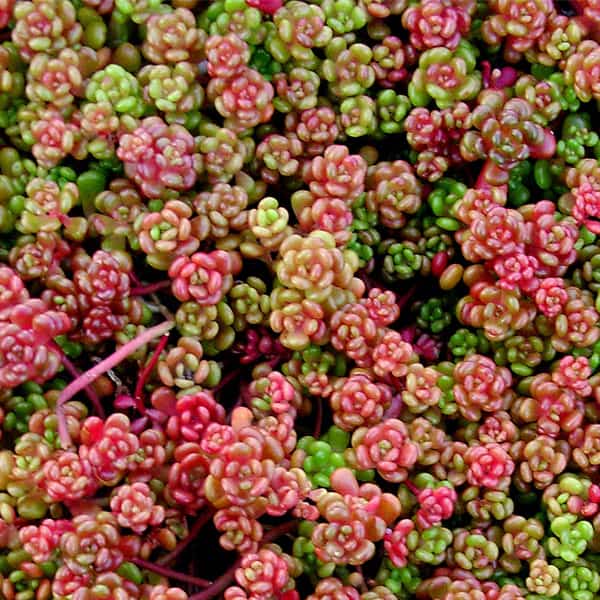
For sedum fans who appreciate the beauty in transitions, this Pacific Northwest native is sure to captivate. The vibrant emerald green leaves take on otherworldly shades of bronzy-red as winter approaches, prolonging the season of warm tones. But the real showstopper arrives in summer when sprays of brilliant yellow starry flowers blanket the succulent mounds and trailing stems. A rugged yet radiant beauty!
Sedum oregonense
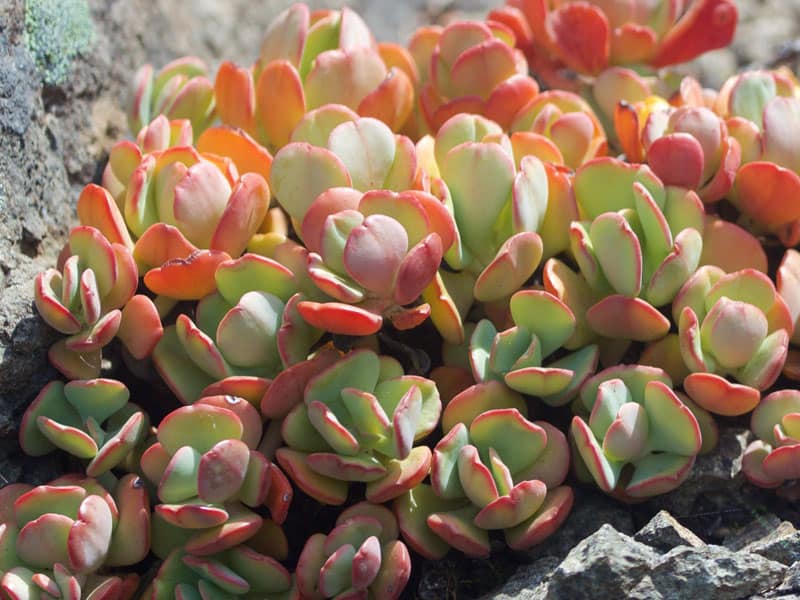
Imagine a dusty, sheltering rosette of powdery grey-green succulent leaves, each shaped like a soft spoon or velvet-edged pod. Now add sprays of creamy yellow flowers that age to shades of coral and salmon, and you’ll get a sense of this variety’s unique, understated charm. A compact yet mesmerizing option for areas where toughness and subtlety need to coexist.
Sedum oteroi
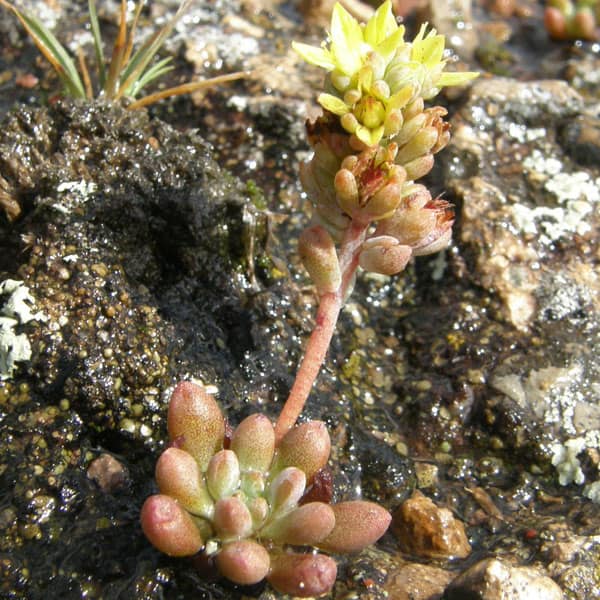
Sedum oxypetalum (Dwarf Tree Stonecrop)
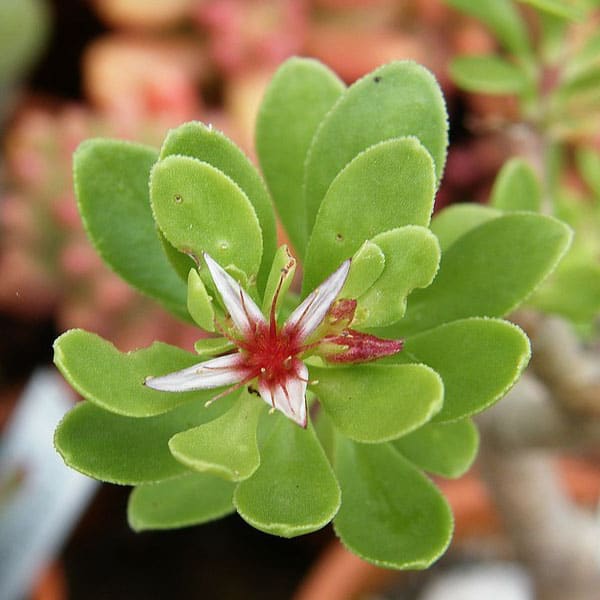
Imagine a miniature bonsai tree reimagined as a quirky succulent and you’ll get a sense of this variety’s unbelievable novelty appeal! The thick, pale green spoon-shaped leaves form concentric rings along the upright woody stems, giving it the most uncanny dwarfed tree-like silhouette. But then fragrant, creamy yellow starry flowers arrive in summer, their pointed petals radiating out like little bursting stars from the leaf rings. Whether grown as a patio accent or nestled in a rock garden, it’s sure to delight anyone who appreciates the utterly unique and whimsical side of sedums!
Sedum pachyphyllum
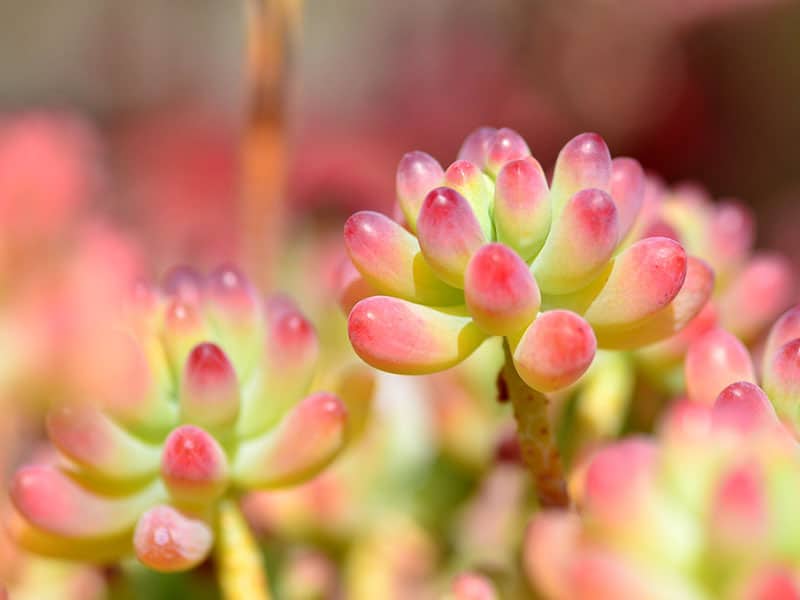
Imagine strings of plump, silvery green jelly beans draped across the ground and you’ll get a sense of this variety’s whimsical, tactile appeal. The succulent, oblong leaves have a translucent, water-bead look that’s utterly captivating. But then in spring, large sprays of radiant buttercup yellow starry flowers arrive to double the sunshine factor. Whether planted as a groundcover or allowed to spill from containers, it delivers pure sunny cheer.
Sedum pallidum var. bithynicum
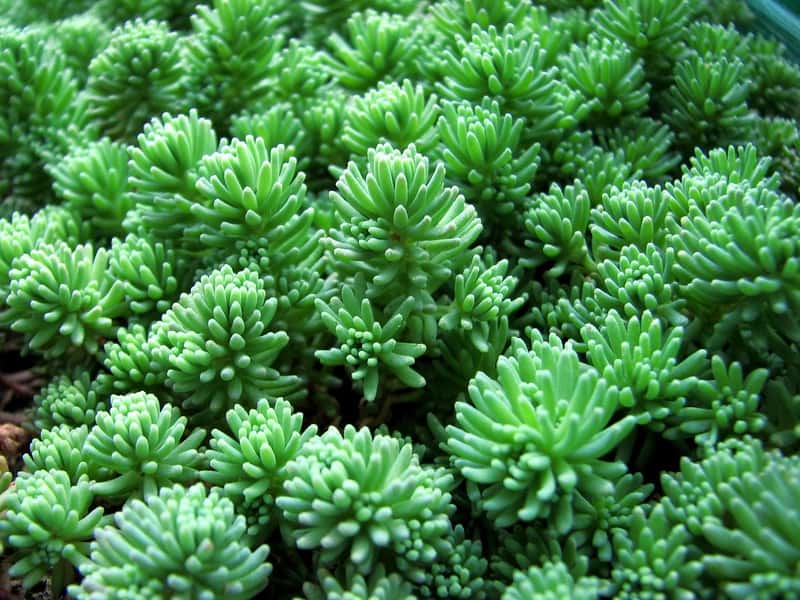
For sedum lovers who appreciate soft, tranquil hues, this Turkish variety delivers soothing shades of minty green and dusty blue. The tiny, bead-like leaves form a delicate, velvety carpet across the ground, creating the most refined and serene of textures. But just when you think it’s too understated, dainty white starry flowers materialize in summer to provide an ethereal, dreamy finishing touch. An elegant yet hardy option for pathways, between pavers, or as a restful groundcover that pampers the eyes.
Sedum palmeri
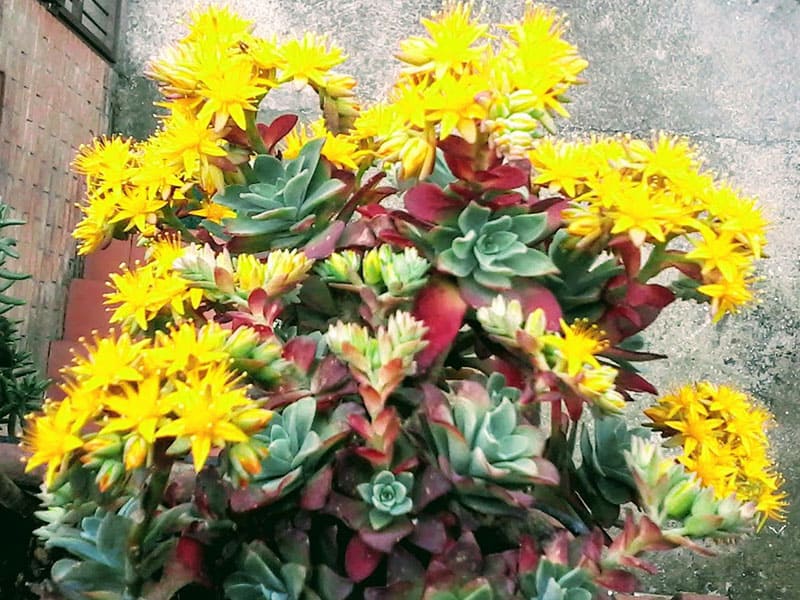
For gardeners who like sedums on the more boisterous side, this cool greenhouse variety is sure to delight! Husky powder-blue leaves arranged in plump rosettes provide an already chunky, robust presence. But then in spring, they get completely overwhelmed by explosive sprays of neon yellow-orange starry flowers that practically smother the entire plant. It’s nature’s version of a boisterous parade float adding zest to any sunny space.
Sedum pilosum
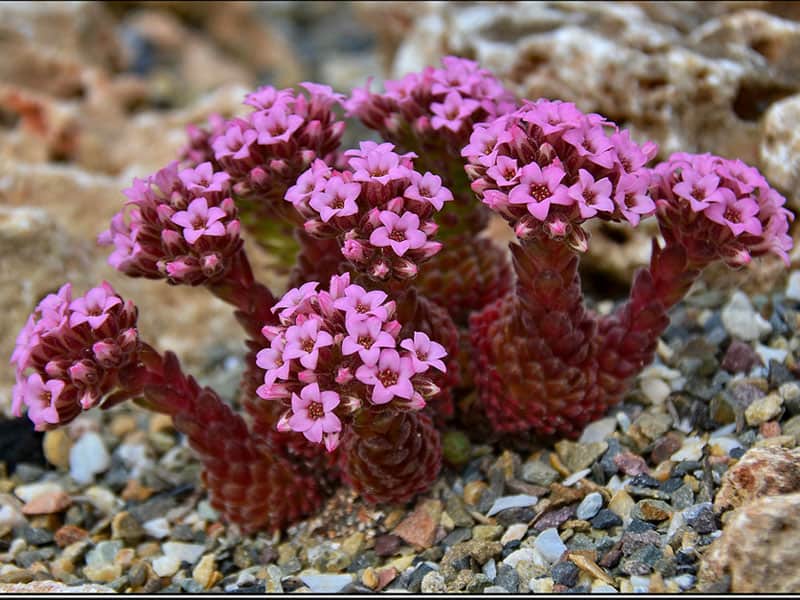
Here’s a rare little biennial sedum from the Caucasus that’s sure to become a fast favorite for collectors! The tight rosettes of fuzzy green succulent leaves bear an uncanny resemblance to a tiny sempervivum hen-and-chick. But then in spring, clusters of hot pink starry flowers add an electric burst of unexpected color. An absolute novelty item to treasure in a dish garden or trough where you can admire its quirky details up close.
Sedum pluricaule
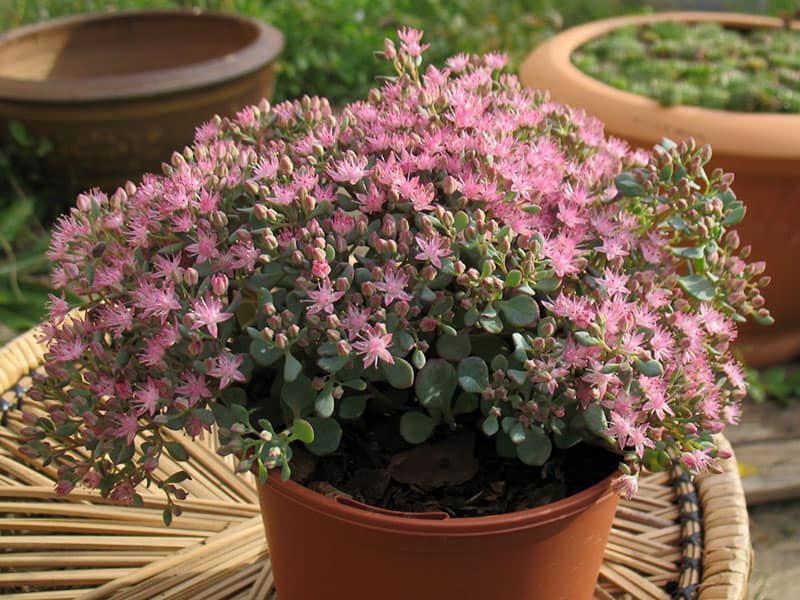
Don’t let the diminutive size of this sedum fool you – it packs a surprisingly vibrant punch! The chubby blue-green jelly bean leaves create a soft, feathery carpet studded with rose-pink starry flowers in early summer. But as temperatures cool, the succulent foliage takes on rich crimson hues that linger into winter for a festive colored-pencil effect. A petite yet spirited option for sunny edges, rocks, or even containers.
Sedum polytrichoides
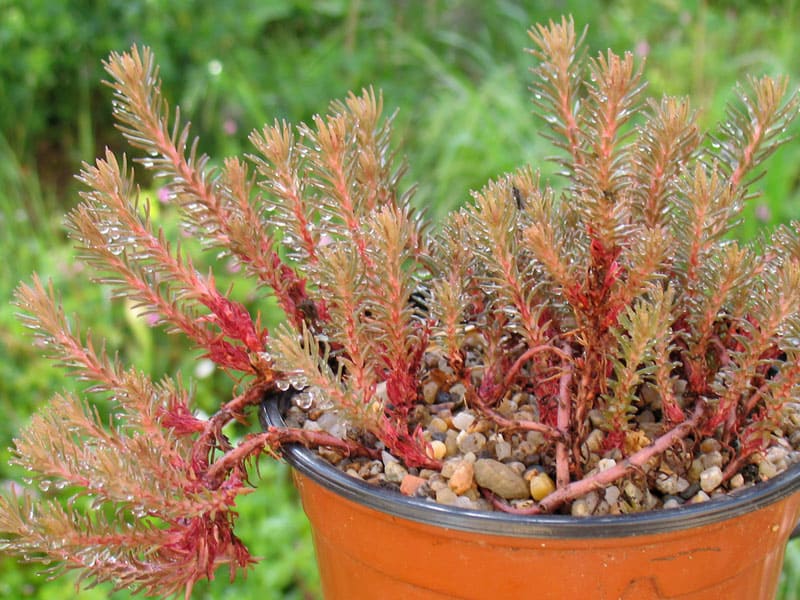
Here’s a creeping sedum with tons of intricate details to appreciate up close. The slender stems get completely covered in tiny, bead-like blue-green leaves arranged in mesmerizing spiral patterns. But the delicate succulence gets overwhelmed when sprays of brilliant yellow starry flowers erupt in summer, creating a sunshine-filled hazy daze across the entire mat. A real micro-marvel for edges, crevices, or containers where you can study its intimate charms.
Sedum potosinum
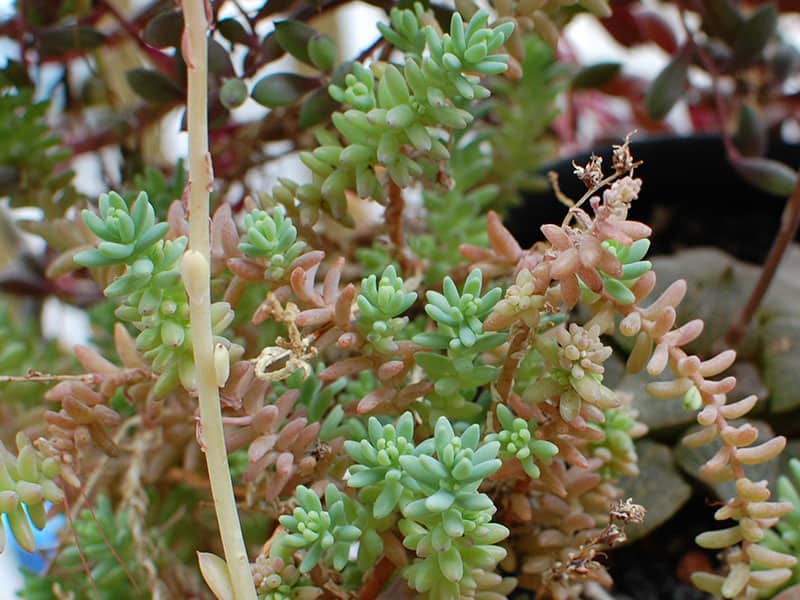
For fans of the classic jelly bean sedums, this variety delivers those plump, translucent succulent leaves in spades! The chubby blue-green pads spiral along the slender burgundy stems to form tactile, geometric patterns you’ll want to reach out and stroke. But then in summer, the normally petite plant gets completely transformed as clusters of pure white starry flowers erupt for a delicate, gossamer finish. A lovely blend of rugged charm and ephemeral grace.
Sedum praealtum
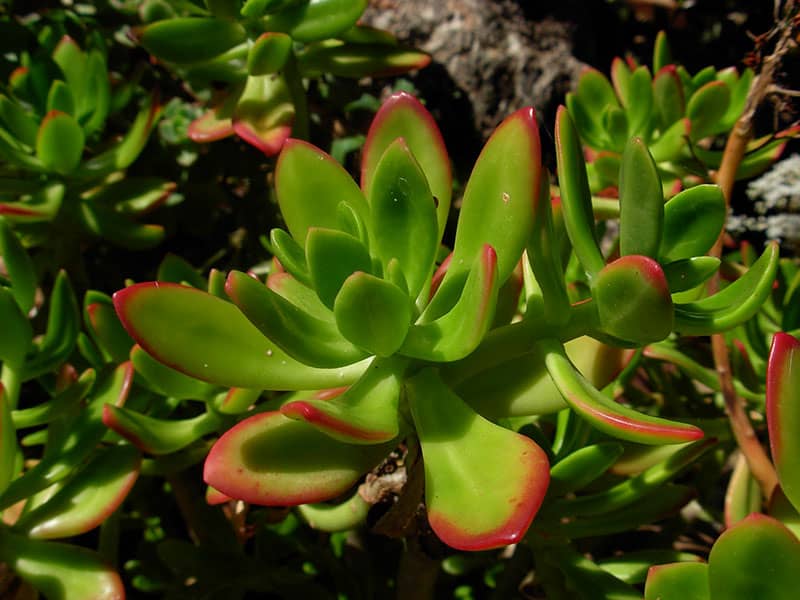
If you love sedums on the slightly larger side, this robust Mexican variety is sure to delight. The broad spoon-shaped green leaves overlap along the thick stems to form patterns reminiscent of pottery or sculpture. But then in late winter and early spring, an absolute frenzy of vivid yellow starry flowers bursts forth to smother the entire plant in radiant sunshine. Talk about a dramatic transformation – it’s like demure succulence giving way to an exuberant floral fiesta!
Sedum pusillum
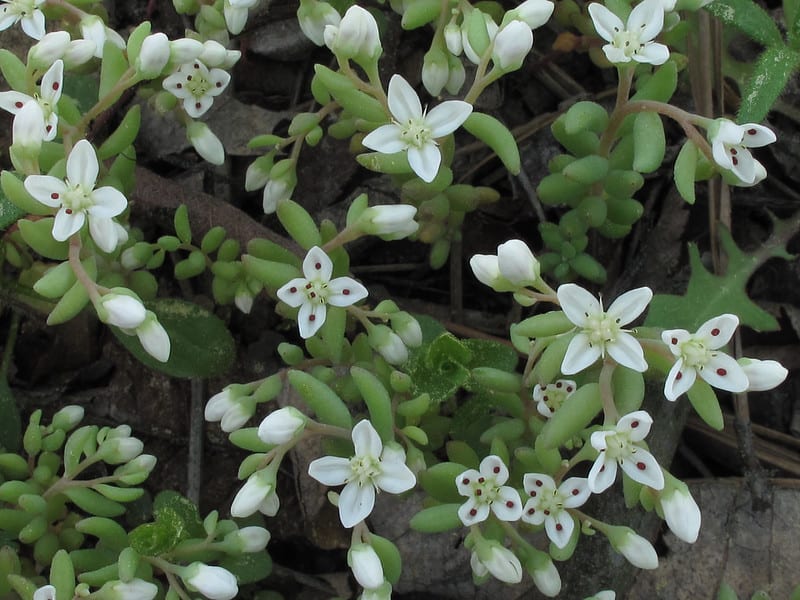
Sedum radiatum
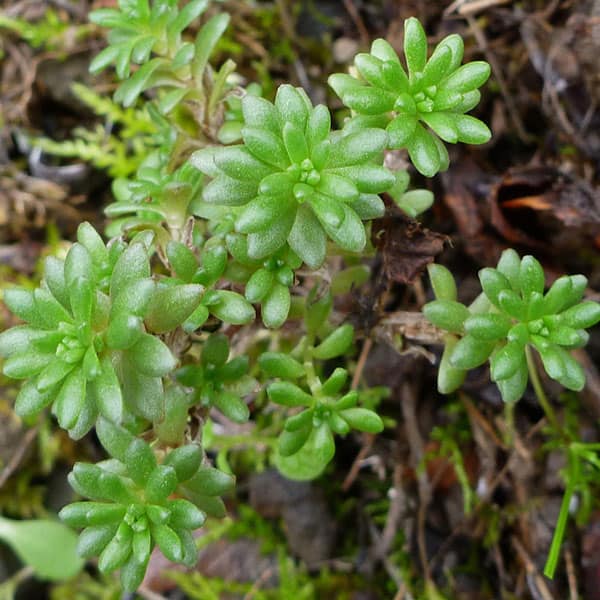
For fans of the more delicate, ephemeral sedums, this western North American native is sure to enchant. The slender stems get lined with petite blue-green leaves, each one meticulously detailed with purple or red veining like miniature roadmaps. But the entire plant becomes a soft cloud of airy whimsy when sprays of tiny white, cream or pale yellow starry flowers release their dainty display. A refined yet hardy choice for rocky areas.
Sedum ‘Red Canyon’
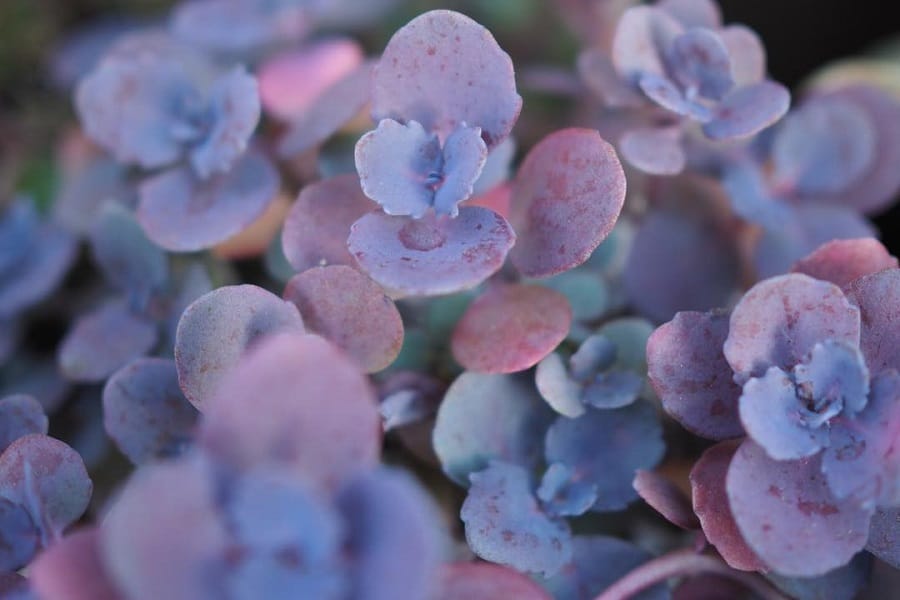
Not a fan of wimpy groundcovers? Then this big, bold stonecrop is the one for you! Thick, fleshy grey-green leaves with spiked crimson edges create a robust tapestry that’s hardy enough to even handle a little foot traffic. But the ruggedness gets balanced by drifts of cheerful yellow starry flowers arriving in summer to lighten the mood. An ideal option for areas that need low-maintenance coverage with plenty of personality.
Sedum reptans
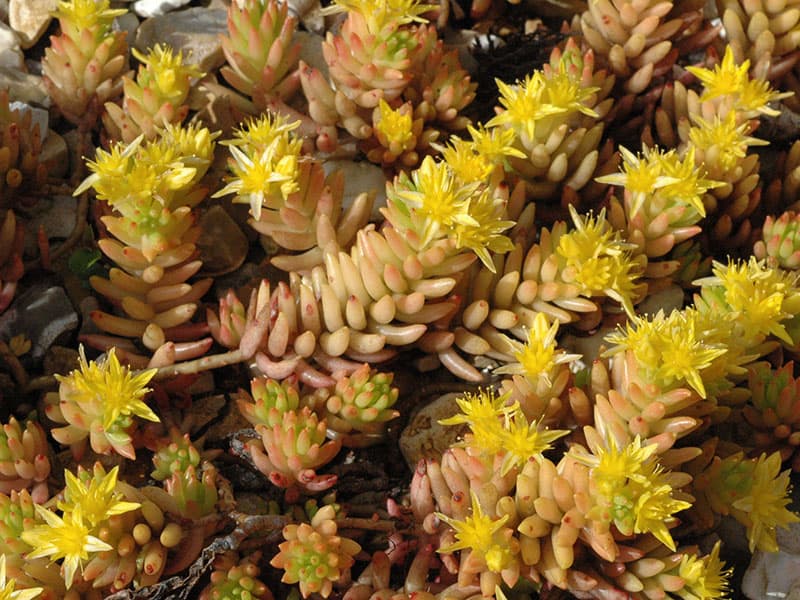
With its glowing green jelly bean leaves that blush red as the season progresses, this low-growing sedum has tons of cheerful charisma. But it lets its true colors shine in summer when masses of radiant yellow starry flowers arrive to double the sunshine factor. A lively option for edging borders or allowing to ramble between step stones where its vibrant hues can bring warmth and energy.
Sedum rhodanthum
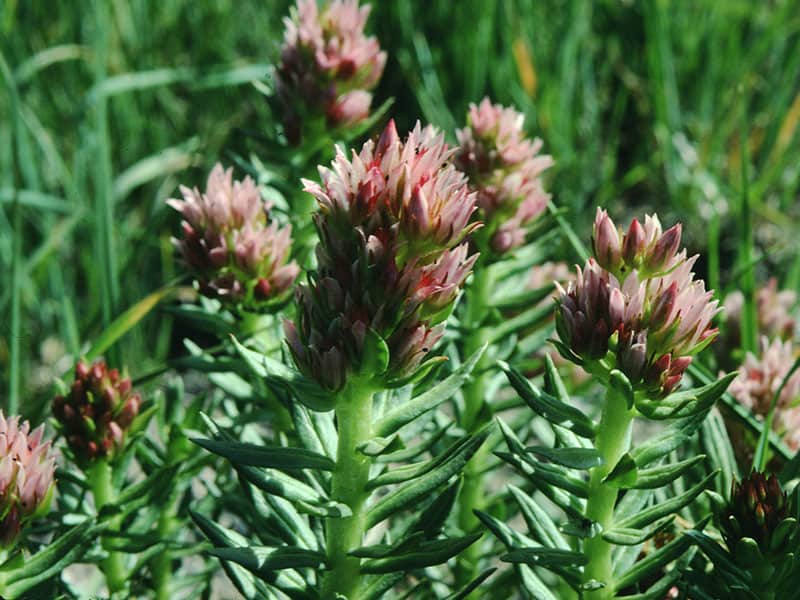
Sedum Rosy Glow
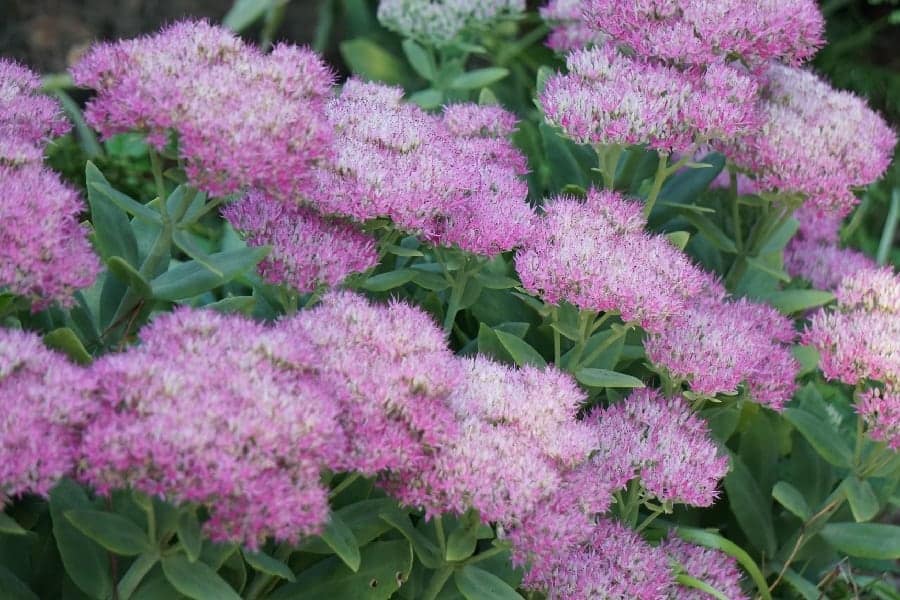
Here’s a sedum cultivar that embraces bright, look-at-me shades with no apologies! The fleshy blue-green leaves take on electrifying shades of glowing rosy-pink that intensify to neon whenever the plant is stressed. Just when you think that’s enough razzle-dazzle, domed clusters of hot pink starry flowers arrive to amplify the scorching floral statement. An incandescent option for hot, sunny areas that need a radiant refresh.
Sedum rubens
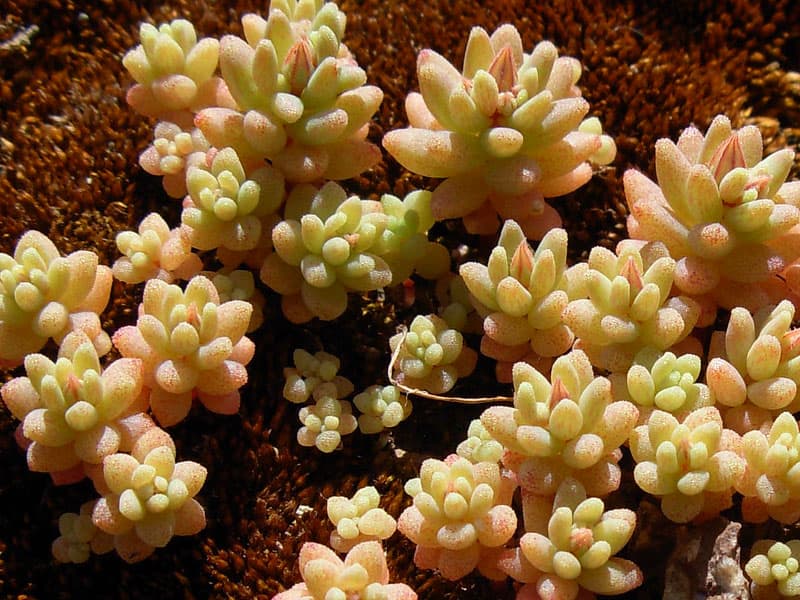
Don’t overlook this petite Mediterranean sedum just because of its subtle looks! The chubby blue-green leaves may appear modest at first, lined up obediently along the slim stems. But then in spring the entire plant gets engulfed in masses of brilliant white starry flowers, aging to shades of cheerful pink and red. A delicate charmer that can easily get lost in the shuffle, so reserve a special spot to appreciate its ephemeral beauty.
Sedum rubrotinctum
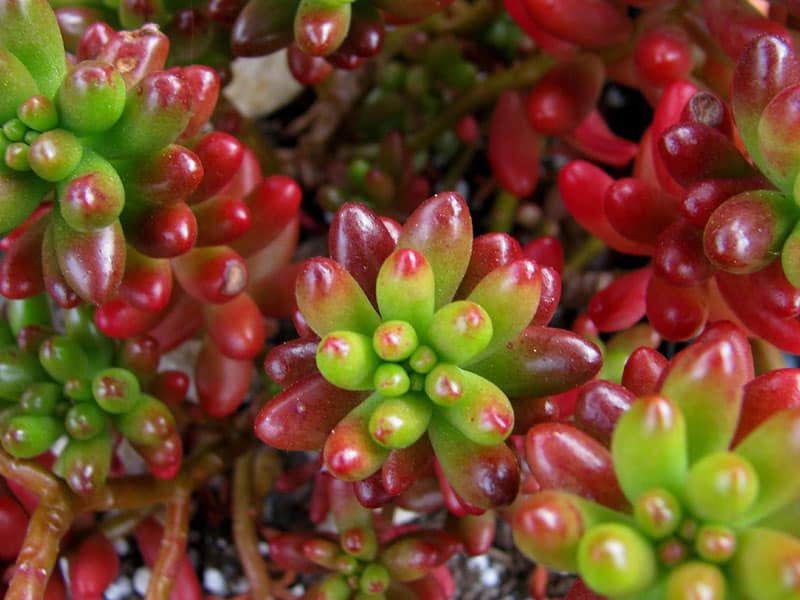
For fans of the classic jelly bean sedums, this variety is sure to become an instant favorite trendsetter. The plump, transparent blue-green leaves already look like gorgeous pebbled glass beads arranged in tidy spirals. But then they start blushing vibrant shades of yellow, orange, and ruby red as the season progresses, putting on a breathtaking warm-toned show. And the vivid accents continue into winter when sprays of cheerful yellow starry flowers arrive to amplify the radiance. A stylish, high-voltage option for sunny areas!
Sedum rupestre
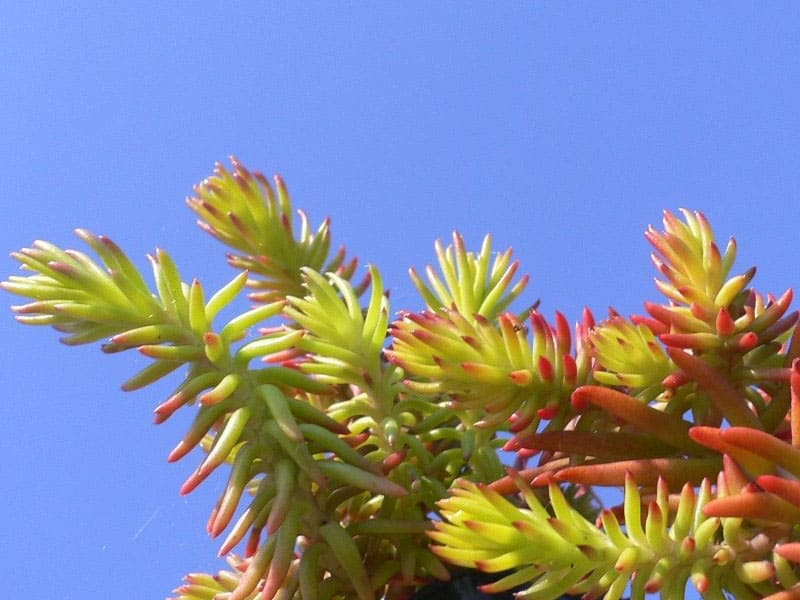
Here’s a sedum that embraces bright, fiery shades with gusto! The needle-like leaves take on electrifying shades of golden-yellow that transition to ember oranges and reds as temperatures drop, creating a sizzling carpet of warmth. But the radiant display kicks into overdrive in summer when sprays of brilliant yellow starry flowers arrive to amplify the incandescence even further. An absolute glow-getter for energizing any sunny spot.
Sedum sediforme
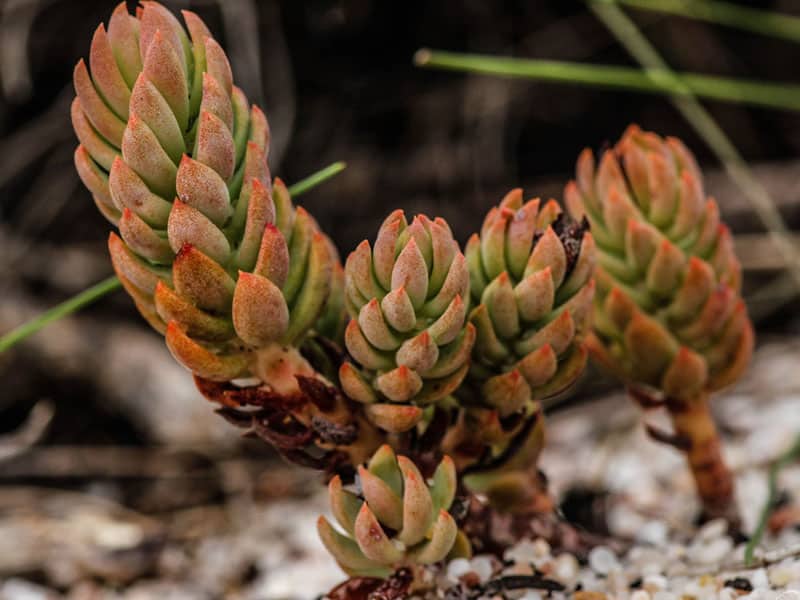
For gardeners who appreciate sedums on the more bold and architectural side, this species hits all the right notes. The thick, broad, powdery blue-green leaves assemble into chunky rosettes that add tons of rugged texture. But then the real showstopper emerges – foot-tall plumes of cheerful yellow starry flowers that practically smother the entire plant in sunny brilliance. A stunning focal point for hot, sunny spaces.
Sedum shitaiense
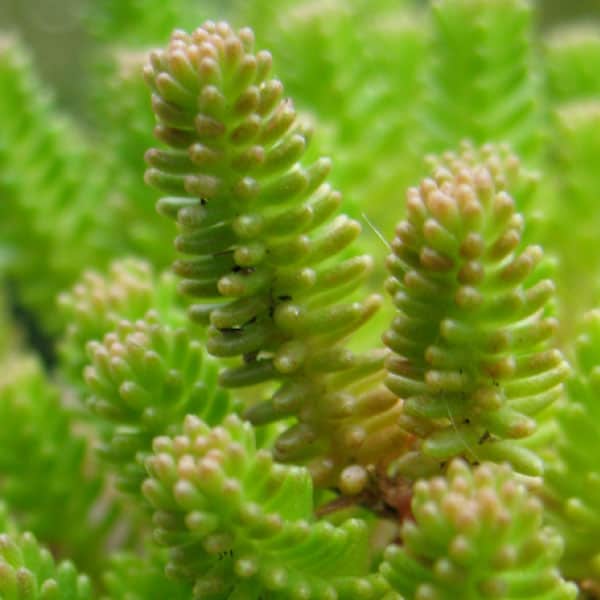
Sedum sieboldii
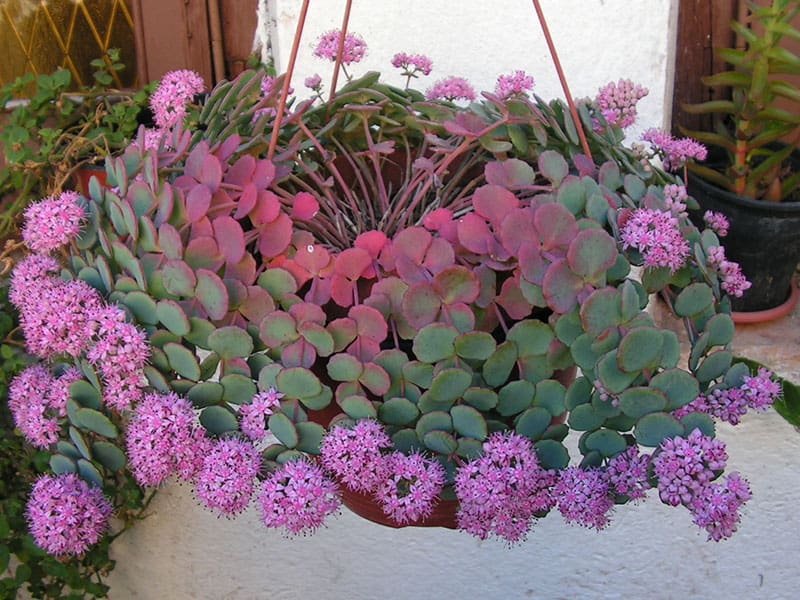
This Japanese stonecrop walks the line between refined and rugged in the most alluring way. The low, branching mounds get covered in petite blue-green jelly bean leaves, each one delicately outlined in deep rose-pink. But just when you think it’s all about dainty details, those vibrant fuchsia petal edges get amplified even further when the starry flower clusters emerge in early fall. A stylish yet totally care-free option for rocks or containers.
Sedum smallii
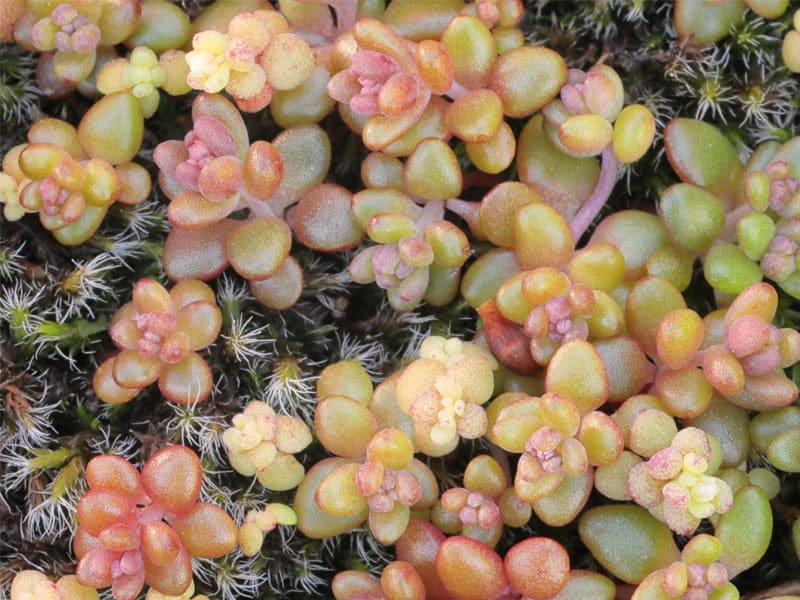
Sedum spathulifolium
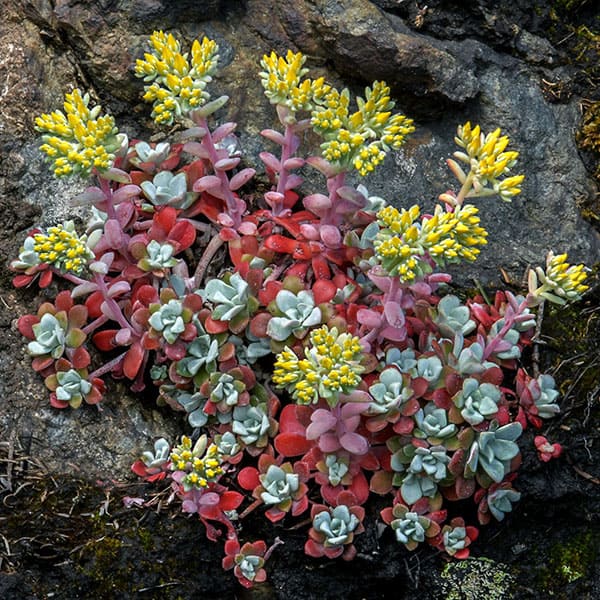
With its ghostly blue-green, spoon-shaped leaves arrayed in mesmerizing rosettes along the stems, this creeping variety has an utterly otherworldly look. But the extraterrestrial appeal gets amplified even further when the yellow flower clusters emerge in summer, each one surrounded by a soft white powdery haze. Allow it to ramble between pavers or over rocks where its intricate details and soft coloring can be fully appreciated.
Sedum spectabile
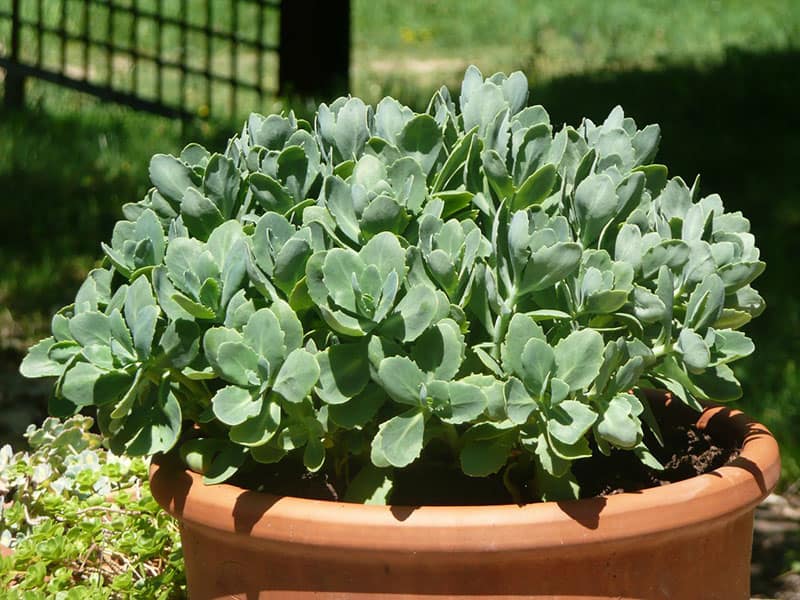
For gardeners who appreciate sedums on the meatier, more substantial side, this variety is sure to satisfy. The upright clumps of fleshy, bluish-green leaves have a weighty, no-nonsense presence that provides excellent textural contrast. But in late summer, they get practically engulfed by drifts of soft dusty pink flower heads, adding a delicate yet radiant finishing touch. Drought-tough but beautiful!
Sedum spurium
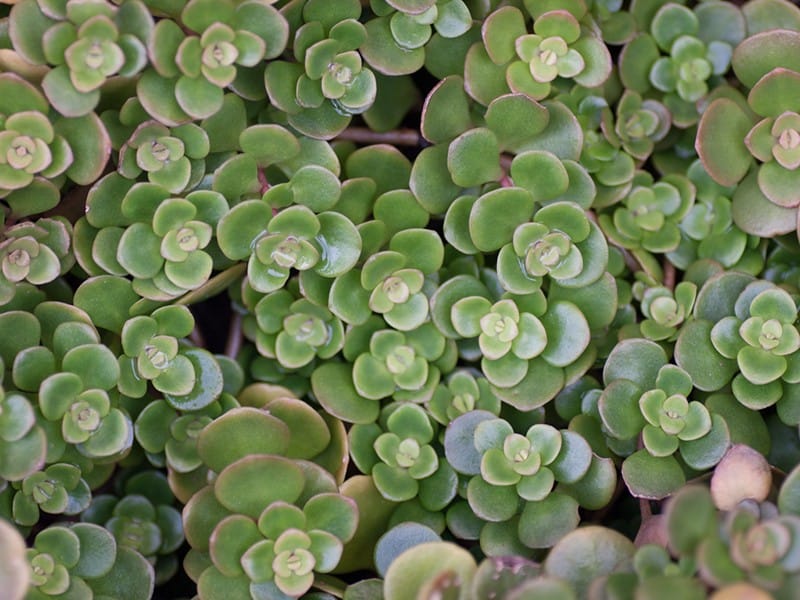
Here’s a fast-growing, weed-smothering groundcover that knows how to turn up the charm in summer! The low mats of plump, emerald green leaves have an easygoing look for most of the season. But then in late summer, masses of starry red, pink, or white flowers erupt to smother the entire patch in vibrant blooms. Perfect for areas where you need lush, no-fuss coverage with a burst of seasonal color.
Sedum stahlii
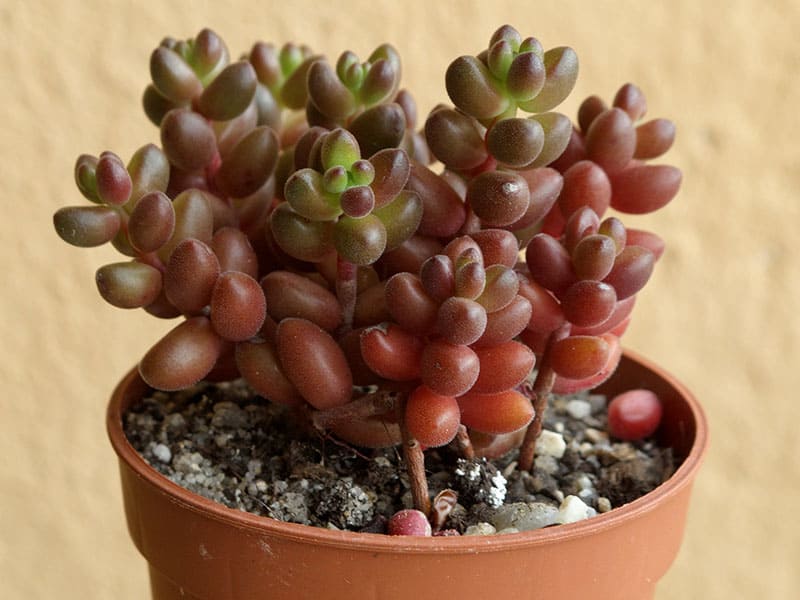
For gardeners who love eccentric, touchable textures, this trailing sedum is sure to become an instant obsession. The egg-shaped, rusty red leaves dangle from wiry stems in mesmerizing patterns, almost demanding to be caressed and fawned over. But the real magic happens in spring when sprays of bright yellow starry flowers materialize to illuminate the geometric succulent display. A bold yet whimsical option for baskets and containers.
Sedum stefco
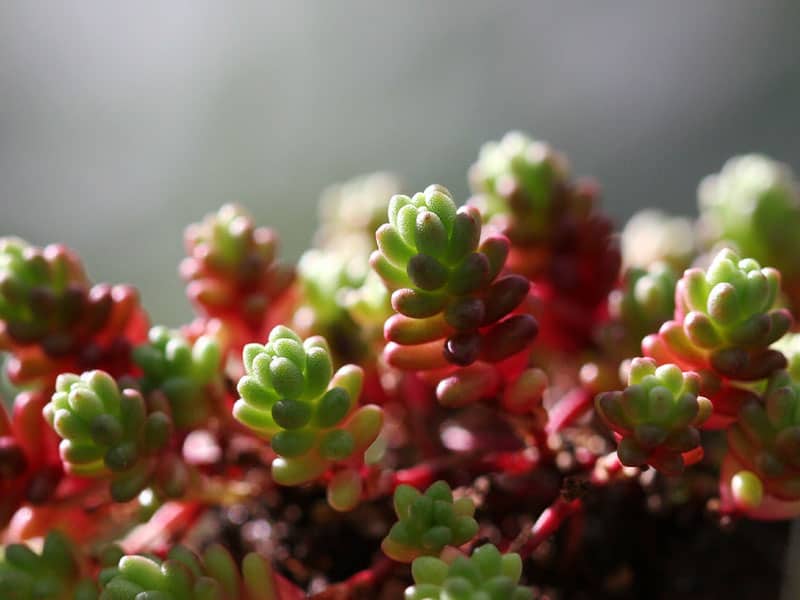
This petite sedum proves that big things can come in small packages! The low, wiry mats of chubby blue-green leaves arranged along ruby-red stems already provide tons of intricate allure. But in late summer, the entire planting gets smothered in a soft hazy veil when masses of tiny white starry flowers make their appearance. Perfect for areas where you need a low, refined accent with season-spanning character.
Sedum stellatum
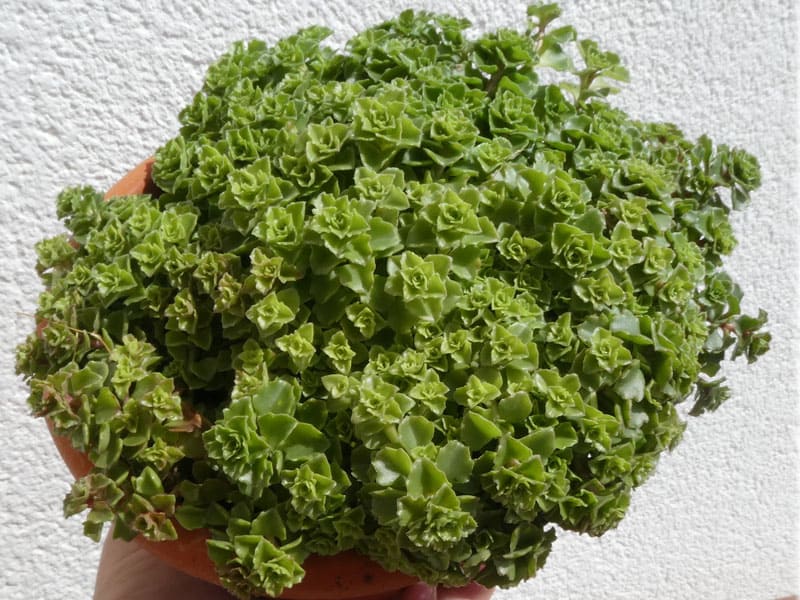
Sedum stenopetalum
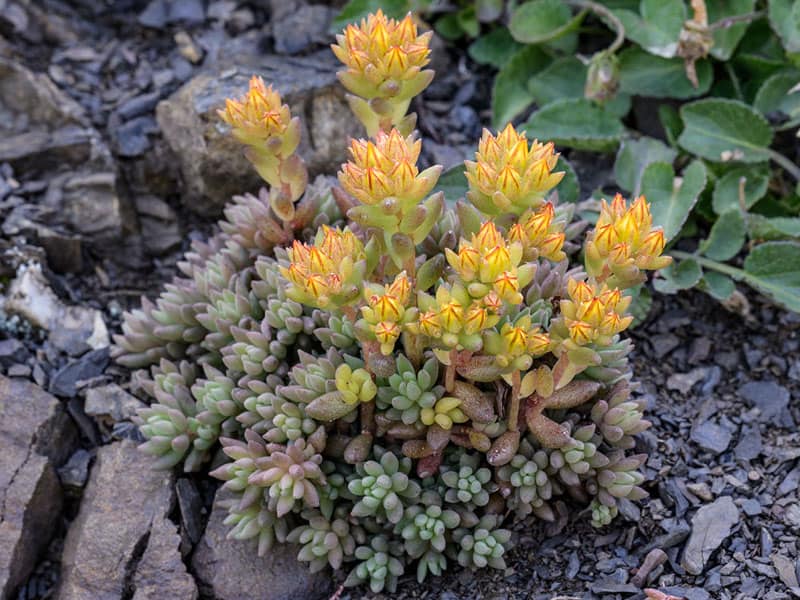
For lovers of sedums on the more delicate and detailed side, this variety is sure to become an instant favorite. The slender stems get lined with tiny linear or three-lobed succulent leaves, each no bigger than a fingernail. But then in spring, the airy, ethereal look gets amplified even further when sprays of yellow starry flowers appear, their pointed petals blushed with delicate red veining. A real sculptural beauty for troughs and rockeries.
Sedum stoloniferum
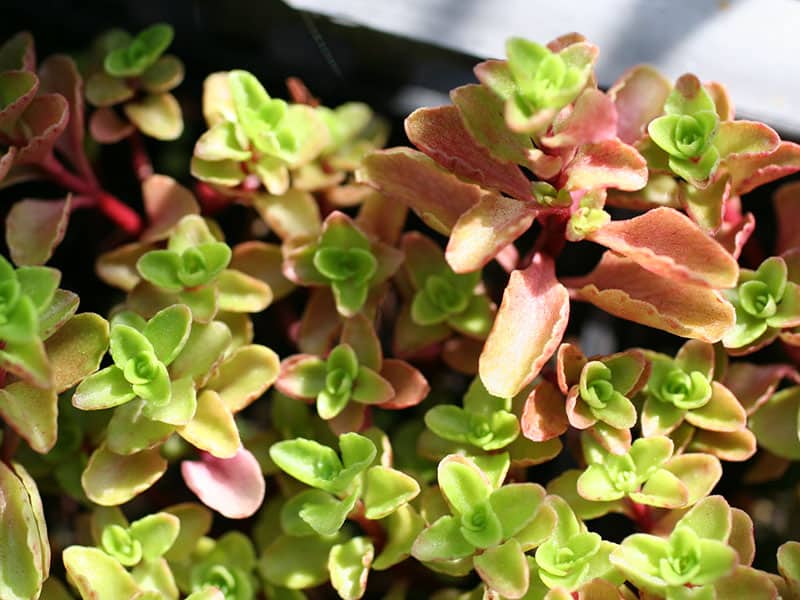
If you love sedums that embrace a laid-back, trailing style, this sprawling variety is sure to delight. The plump blue-green jelly bean leaves form lush, tapestry-like mats that spill over rocks and container edges. But just when you think it’s peaked in the informality department, dainty clusters of bright pink flowers arrive in summer to add a vibrant burst of fresh energy. A perfect blending of cottage charm and easygoing toughness.
Sedum suaveolens
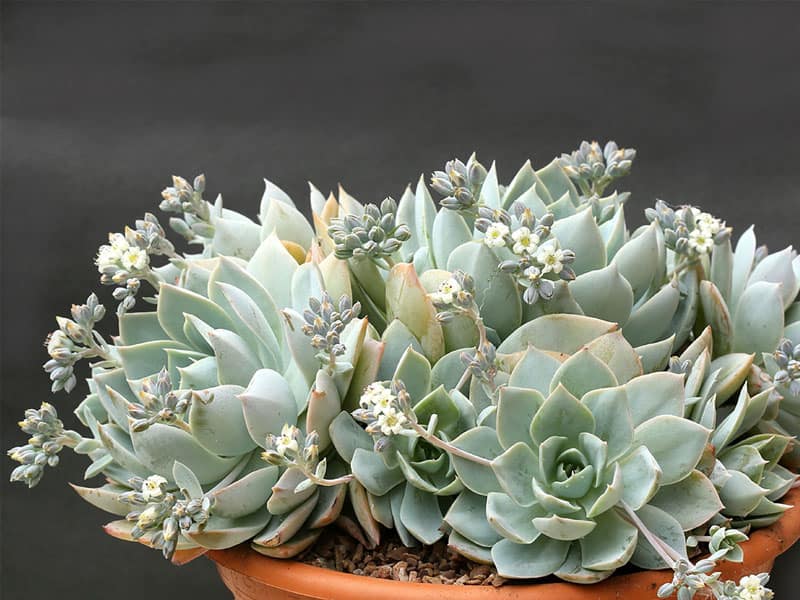
For gardeners searching for sedums with a bolder, more robust presence, this variety really packs a punch. The massive rosettes, up to 8 inches across, consist of chalky blue-green spoon-shaped leaves stacked in perfect concentric circles. It’s an already impressive sculptural display that gets amplified even further when the sweetly fragrant white flower clusters appear from the centers in summer. A real head-turning focal point!
Sedum tenellum
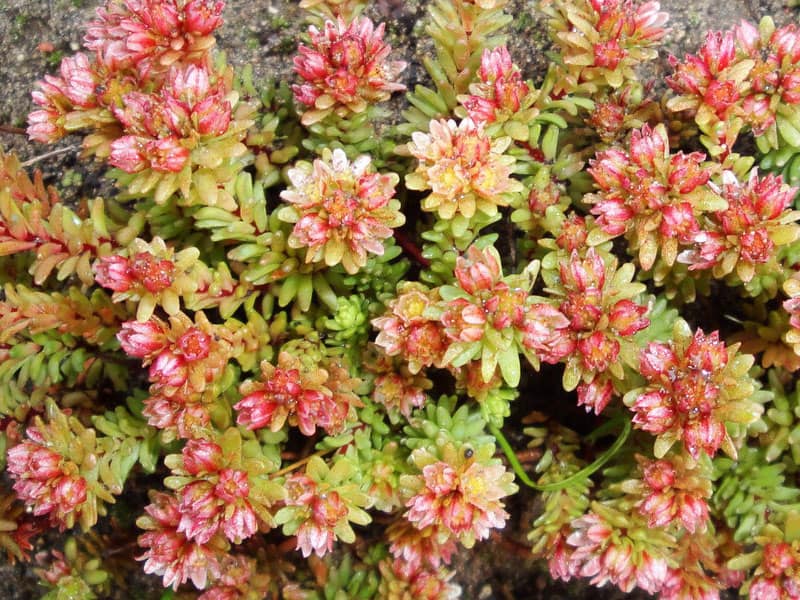
Don’t let the petite size of this creeping stonecrop fool you – it delivers massive amounts of charm! The densely matted stems get completely covered in minute, bead-like green leaves, creating an incredibly refined, velvety texture. But then in summer, the whole planting becomes a smattering of delicate lace when masses of tiny pink or red starry flowers make their appearance. An absolutely captivating option for in-between paving stones, trailing over rocks, or softening the edges of containers where its intricate details can be fully appreciated up close. Sometimes the smallest sedums can make the biggest impact!
Sedum ternatum
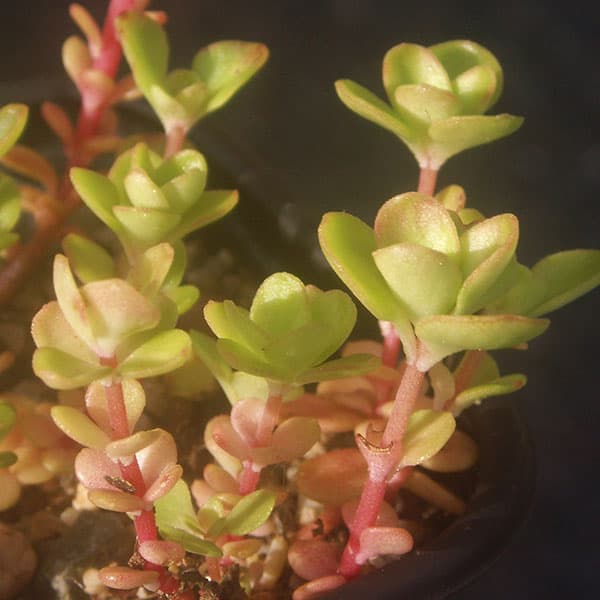
You’d never guess this delicate, wiry Missouri native is one of the tougher sedums in the bunch! The slender reddish stems get lined with tiny fleshy green leaves arranged in precise whorls of three, creating almost a bamboo-like effect. But in spring, myriad white starry flowers arrived studded with burgundy anthers to provide a delicate lacy display. A choice pick for rocky areas or troughs where its refined details can be appreciated.
Sedum tetractinum
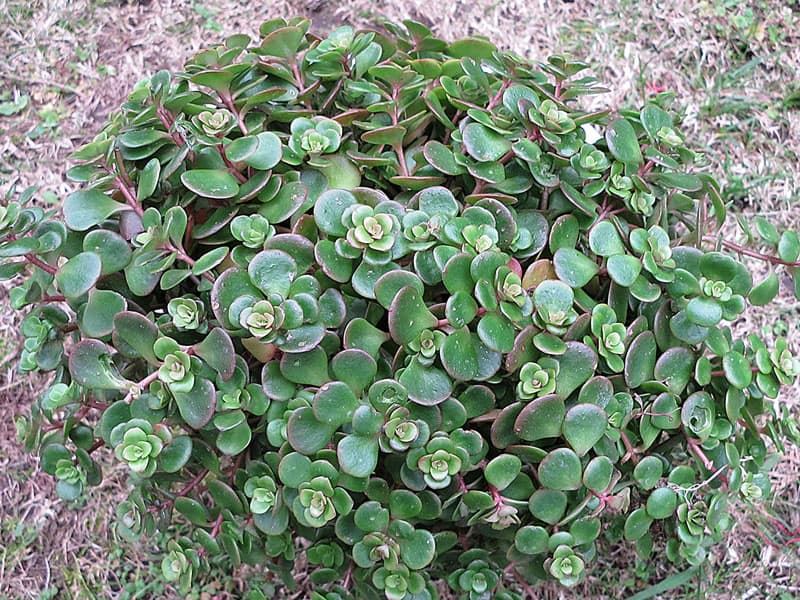
Here’s a fast-growing sedum cultivar that delivers waves of ever-changing, electrifying color all season long! In spring, the low mat is a cool jade tone. But as summer arrives, brilliant shades of coral-orange and red start radiating from the centers to create a sizzling hot display. Finally in winter, pink and white flower clusters arrive to add one final surprising twist to the vivid tapestry. A bolt of pure horticultural energy!
Sedum torulosum
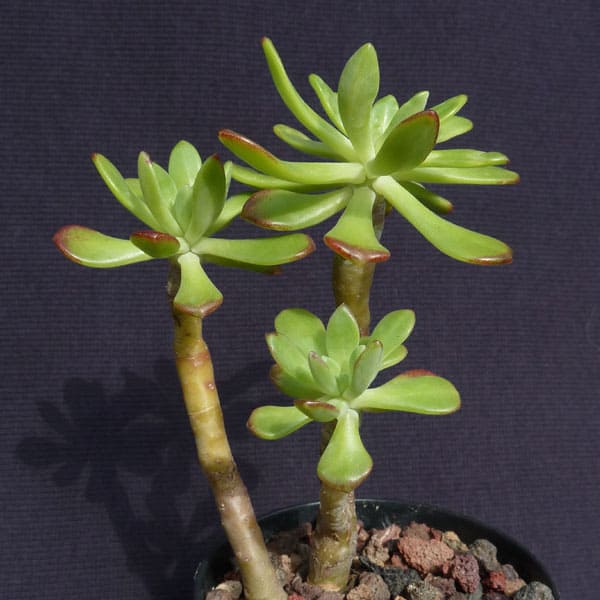
Sedum treleasei
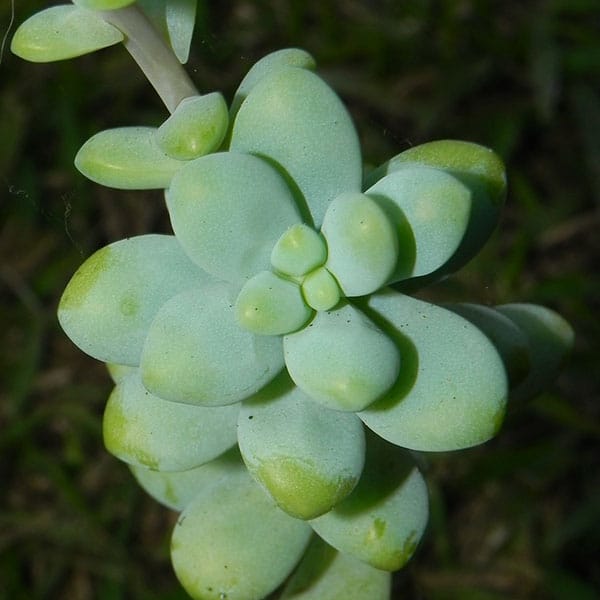
For gardeners searching for sedums with a little extra stature and robustness, this variety delivers in spades. The thick, verigated blue-green leaves arranged in rosettes give it a super-sized, ultra-succulent look. But then in late winter and early spring, the sturdy stems get studded with sprays of brilliant yellow starry flowers up to 6 inches tall to really amplify the vibrant effect. The perfect palette-refresher for hot, sunny areas!
Sedum tymphaeum
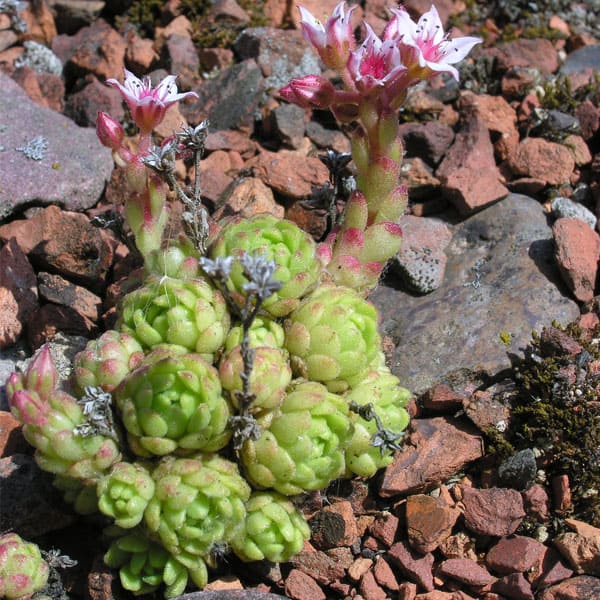
Sedum urvillei
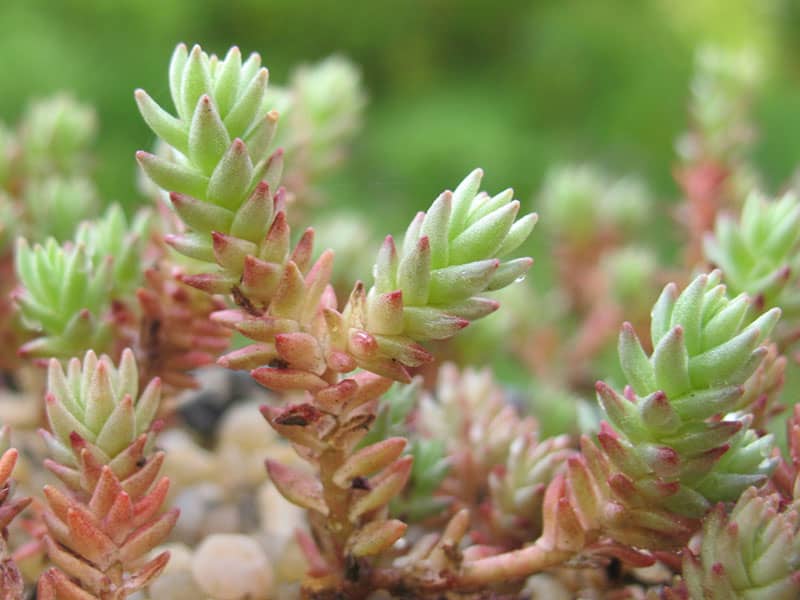
Prepare to have your mind blown by the utterly otherworldly look of this funky little stonecrop! The stiff upright stems get completely covered in plump, blue-grey jelly bean leaves meticulously arranged in intricate spiral patterns. But the real magic happens at the tips, where each leaf features a distinct, broad spur that makes them look like miniature alien antennae. As if that zany look wasn’t already enough, cheery yellow flower clusters appear in summer to create a final burst of sunny whimsy. An absolute must-have for collectors of botanical oddities!
How To Care For Sedum Varieties
Sedums are some of the easiest and most resilient succulent plants to grow. They thrive in full sun and extremely well-drained soil – in fact, the poorer and gritty the better. A mix of 50% potting soil and 50% grit like perlite or chicken grit is ideal.
Once established, sedums are highly drought-tolerant and only need infrequent watering during dry spells. Avoid overwatering at all costs, as it can lead to rot and mushy plants. Sedums also prefer slighly acidic to neutral soil in the 6.0-7.0 pH range.
These tough plants can handle freezing temperatures down to -20°F or lower once mature. Many varieties are evergreen but dormant in winter.
For the most vibrant leaf colors, provide at least 6 hours of direct sun per day. Morning sun is preferable if temperatures get extremely hot in your climate.
Sedums are incredibly low-maintenance – no deadheading is required as the dried flower heads provide winter interest. Simply tidy them up in spring by removing any dead or damaged growth.
Propagating Sedums
These plants are also a breeze to propagate! For upright varieties, simply take stem cuttings in spring and allow them to callus over for a few days before sticking them in well-draining soil.
Ground-hugging sedums can be easily divided and replanted. Or remove a few leaves and place them on top of soil – new plants will sprout from the leaf bases!
Seeds can also be started indoors and transplanted out after the last spring frost.
With their charming looks, vivid colors, and effortless care, let these hardy little succulents add easy texture and vibrancy to all your gardening spaces.
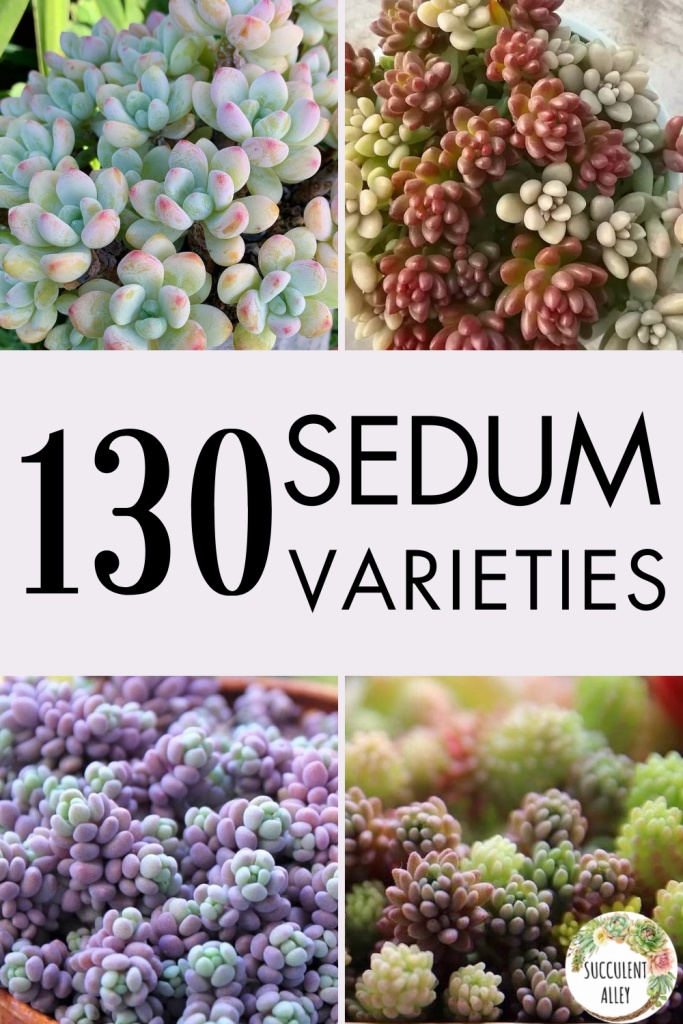
Sources:
https://www.missouribotanicalgarden.org
https://rareplant.me
www.ukwildflowers.com
https://botanicallyinclined.org
https://www.gardenersworld.com
https://worldofsucculents.com
https://www.llifle.com
https://temperate.theferns.info
https://www.fs.fed.us
https://greatplantpicks.org
https://www.perennials.com
https://www.bluestoneperennials.com
https://pfaf.org
https://www.crassulaceae.ch
https://www.americansouthwest.net
https://plantlust.com
www.gardenia.net

